Travel Safe
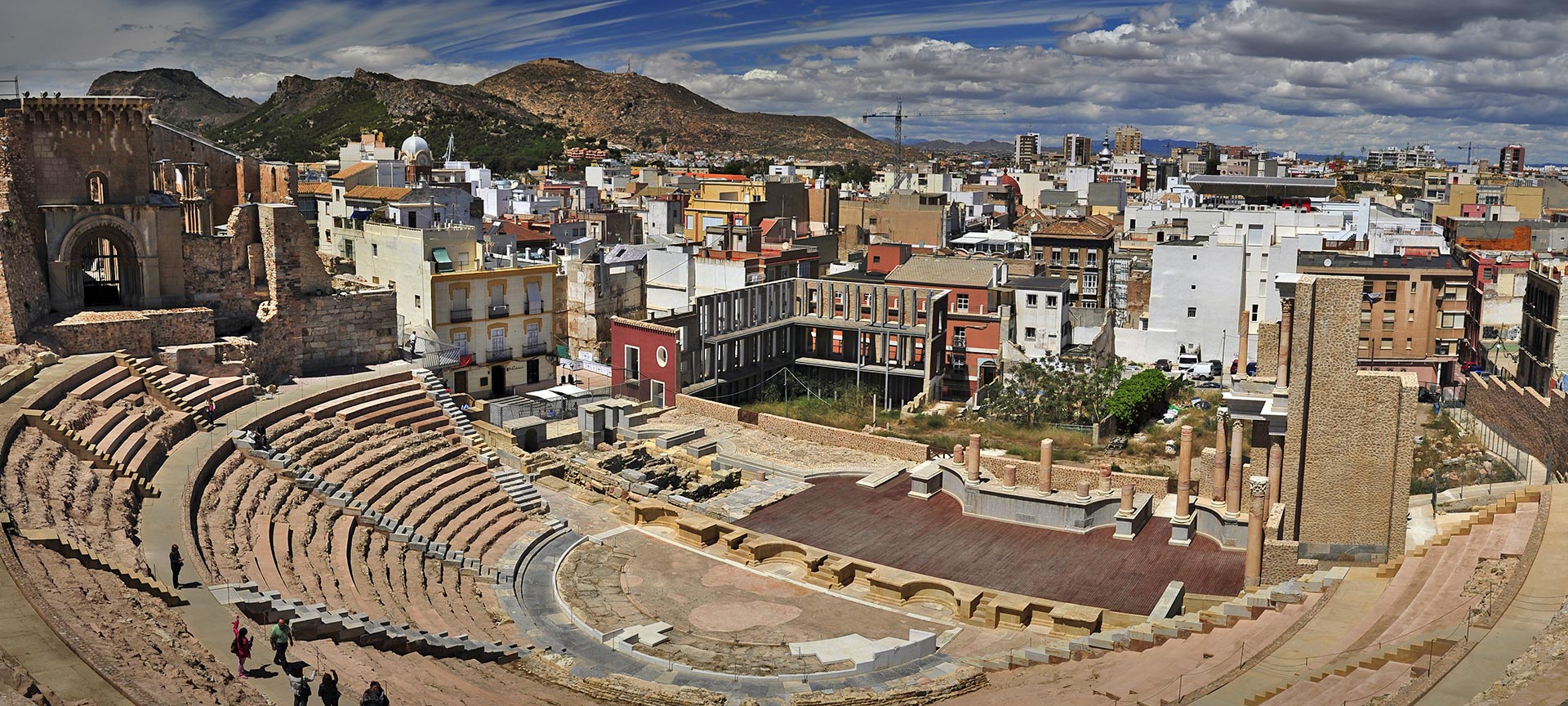
Region of Murcia
The port of Cartagena, in the Mediterranean's Costa Cálida, has been prized since Carthaginian times. Thanks to its strategic position on the Murcia coast, it has been inhabited by several cultures which have left their mark on its artistic heritage.
A tour of the place and its museums will draw us into the history of a city closely tied to the sea. This maritime enclave was already known to the Carthaginians and Romans, and its name today comes from the Latin, Cartago Nova . Cartagena was under Arab domination until Ferdinand III 'the Saint' reconquered it and incorporated it into the kingdom of Castile. Its port played a key role in the War of Succession and the Peninsular War.
Historic centre
The rich Carthaginian heritage spreads to the shores of its marina. The Muralla del Mar ('Sea Wall'), built by Charles III (18th century), delimits the old quarter. Overlooking the Mediterranean there is an element which is clearly connected with the sea: the prototype of the submarine by the inventor from Cartagena, Isaac Peral. In addition, the National Museum of Underwater Archaeology ARQUA (at Paseo Alfonso XII, 22) houses the National Centre for Underwater Archaeological Research. The findings on display reveal aspects of naval construction, trade and navigation since ancient times. The entrance to the city centre is dominated by the Town Hall, a gem of modernist architecture dating from the early 20th century. The Old Cathedral is located on the Camino del Parque Torres (behind the Muralla del Mar wall). This is the oldest place of worship in CartagenaCartagena (13th century), and stands on the remains of a Roman theatre discovered in 1987. This construction dates from the first century A.D., and together with the theatre in Mérida, is one of the most important in Spain. The items found on this site can be seen in the Museum of the Roman Theatre. Other examples of Roman splendour to be seen in the city are the archaeological site of El Molinete, the Morería Baja colonnade and the Byzantine Wall, which –despite its name– is also Roman. Particularly worth mentioning are the Augusteum and the Decumanus . The first contains the remains of the old forum, whose importance as a public building can be seen from the luxurious marble floors on display at the site. The second can be visited on the site adjoining the Roman Forum quarter, a key centre for visitors to the city, containing the different rooms in the city's Roman baths. The Casa Fortuna , built in the first century B.C. and belonging to a wealthy family, shows what daily life was like at the time of the Roman Empire. The Torres park is the site of the Concepción castle . Standing atop a hill, it served as a fortress to Carthaginians, Romans, Visigoths, Arabs and Castilians, and now houses the History and Mediaeval Cartagena Visitor Centre. Indeed the city has always had numerous defensive military buildings. A good example is the Navidad Fortress, built in the mid-19th century and today the Visitor Centre for the Defensive Architecture of Cartagena and the Mediterranean. Also worth visiting is the Refuge – Civil War museum , a series of galleries which were used as protection from aerial attack throughout the conflict. (More information at http://www.cartagenapuertodeculturas.com/ ) The best way to learn more about the Modernist architecture of Cartagena is to take a walk along the Calle Mayor, which leads off the Plaza del Ayuntamiento square, and around the surrounding area. Here visitors will find the houses of Cervantes and Llagostera, by the Cartagena architect Victor Beltrí, with their characteristic glassed-in balconies, worked in iron with bronze reliefs of allegorical figures. Other representative buildings of this artistic movement include the Casino, the Gran Hotel, the railway station, and the houses of Maestre and Dorda, all elegant monuments to the bourgeoisie which remain as evidence of the area's economic development, based on mining and industry, in the late 19th and early 20th centuries. More aristocratic are the palaces of Aguirre (whose adjoining modernist building is this side of the Regional Modern Art Museum MURAM) and Pedreño, one in the modernist and the other in the neoclassical style. The Punic Wall stands on Monte Aletes, one of the five hills surrounding Cartagena. This is the location of the Visitor Centre for this site, dating from the third century B.C. Adjoining the historic walled centre is the Military Arsenal, whose construction was concluded during the reign of Charles III. The walls here have the only surviving entrance gateway in the city. More interesting items from the history of Cartagena can be seen in the Naval Museum , located in the old Naval Offices in Paseo de Alfonso XII, which contains an exhibition of old maritime navigation instruments, maps and navigation charts, as well as models of ships of all kinds. The fishing quarter of Santa Lucía is also well worth visiting. The city of Cartagena also has a variety of key cultural events each year, such as the world music festival known as the 'La Mar de Músicas' (Sea of Music). Other highlights include the historical festivities of the Carthaginians and the Romans in the second fortnight of September which commemorate the Punic foundation of the city, and the Roman reconquest.
The wide variety of landscapes of the Region of Murcia produces a rich selection of different ingredients from the farmlands, the sea and the interior. In Cartagena , the star dishes are products preserved in brine, fish, rice dishes and paellas. The abundant salt flats of the Mediterranean are used for salt to prepare food in brine (particularly tuna, mackerel and bullet tuna) and fish such as gilthead sea bream baked in salt. The calderos, (casseroles) with grey mullet, monkfish, grouper... consist of rice cooked in fish stock and accompanied by a garlic mayonnaise known as ali-oli. Fig bread is a regional speciality, and Cartagena's typical asiático, made from condensed milk, cognac and cinnamon, is the ideal accompaniment to coffee. To enjoy all the different types of cuisine in Murcia, the best idea is to head for the northwest of the region, in order to visit the Sierra de Moratalla, Caravaca de la Cruz and Calasparra, whose rice is the only one in Spain with its own Designation of Origin . This is definitely the star product in a long list of typical dishes, such as rice with snails, or in a stew with celery and turkey. La Vega del Segura leads to towns and villages such as Cieza, Archena (with a spa centre) and Molina del Segura (with a first-rate golf course), where visitors will find such delicacies as green asparagus, hearty chard soup, and rabbit with chestnuts. The area known as the Altiplano in Murcia (in the north) is home to such monumental towns as Jumilla and Yecla . These towns also have wines with their own Designation of Origin. The typical gazpachos (seasoned unleavened bread crumbs) and pulses are served as accompaniments to game dishes. The area's fertile farmlands produce a wide range of vegetables, which are perfect served with the delicious local sausages and cured meats. The Parador hotel in Puerto Lumbreras, and the towns and villages along the Costa Cálida (Águilas, Mazarrón, San Pedro del Pinatar...) are home to interesting monuments from the area's rich heritage, as well as exceptional facilities for nautical sports, beaches, and a delicious cuisine.
What to visit
Select from the list or hover over the map to find out about points of interest.

Torre Ciega

Cartagena Roman Theatre Museum
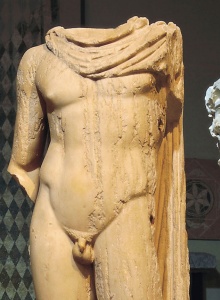
"Enrique Escudero de Castro" Municipal Archaeology Museum
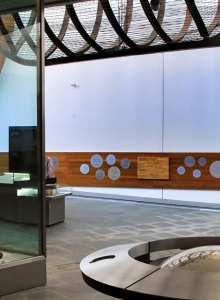
National Museum of Underwater Archaeology.
Travel plans for inspiring you
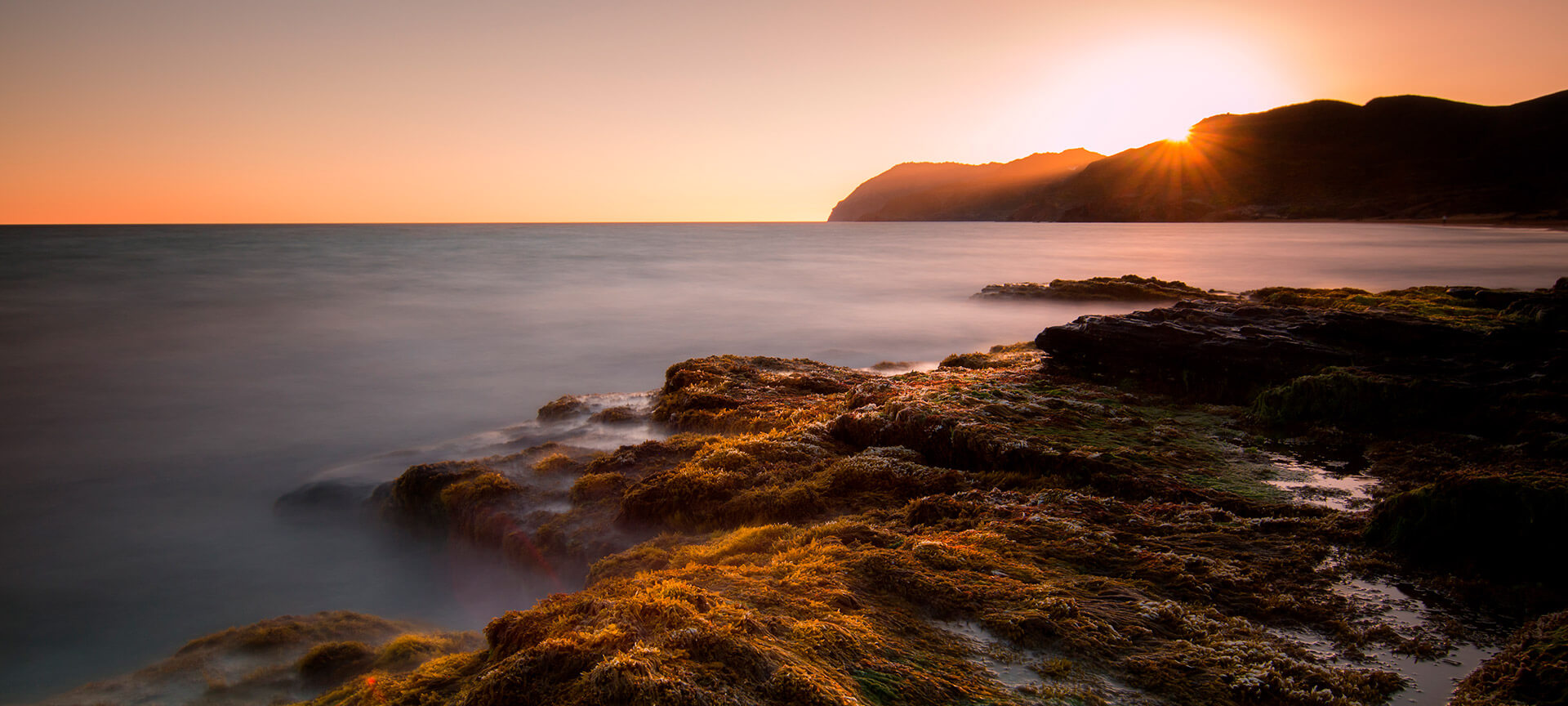
Holidays in Murcia: great things to do at a surprising destination
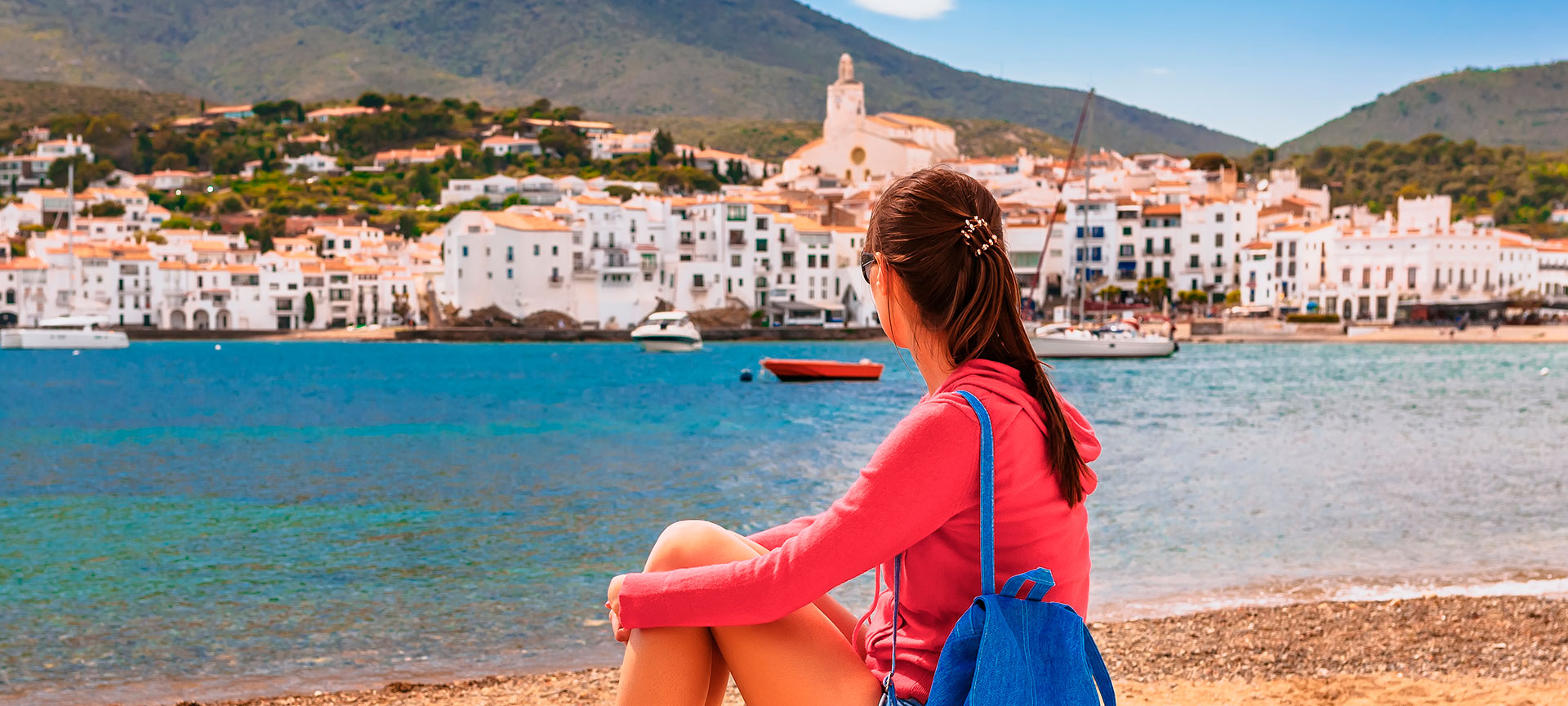
A road trip along Spain’s east coast
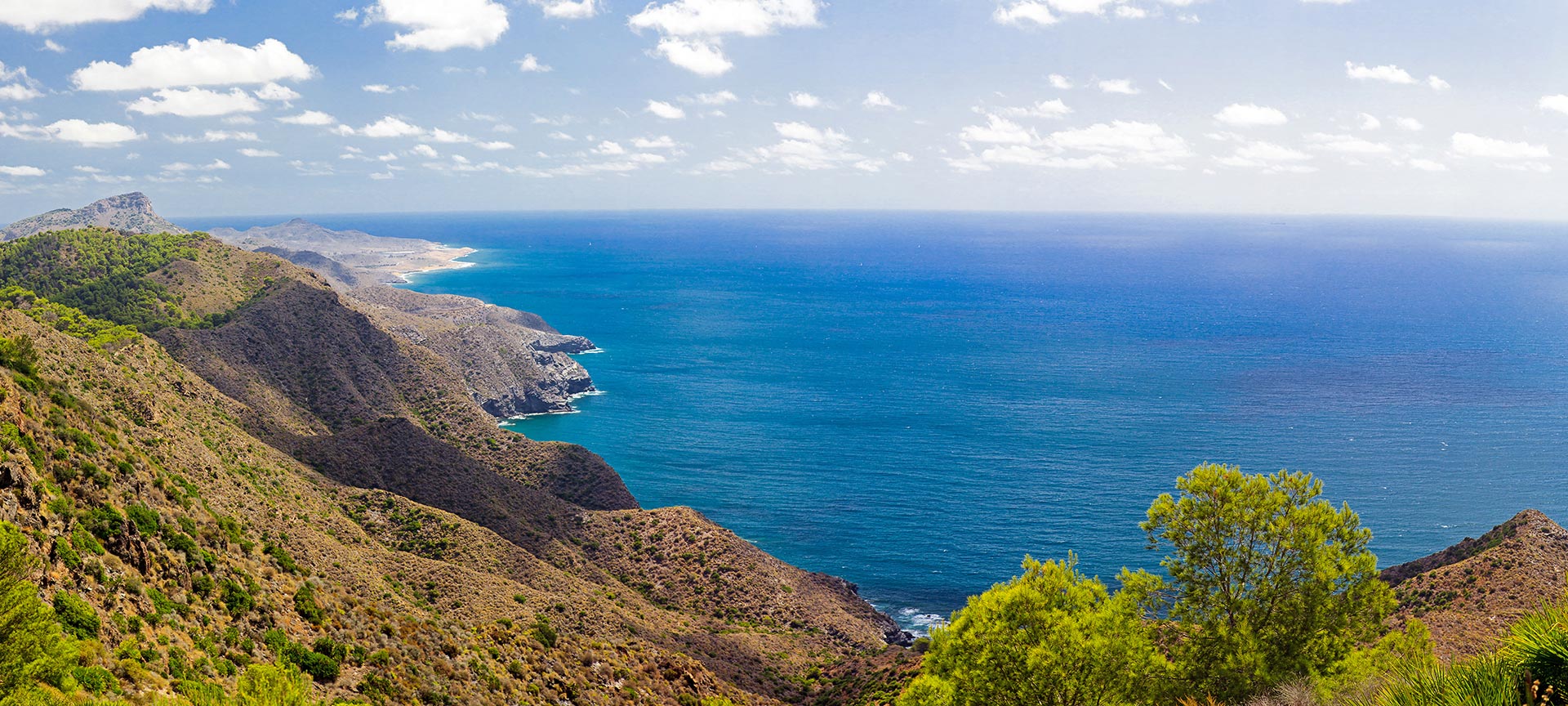
Seaside towns in the Region of Murcia
Shows, festivals, sports...
View some of the most relevant events you will be able to enjoy at the destination.
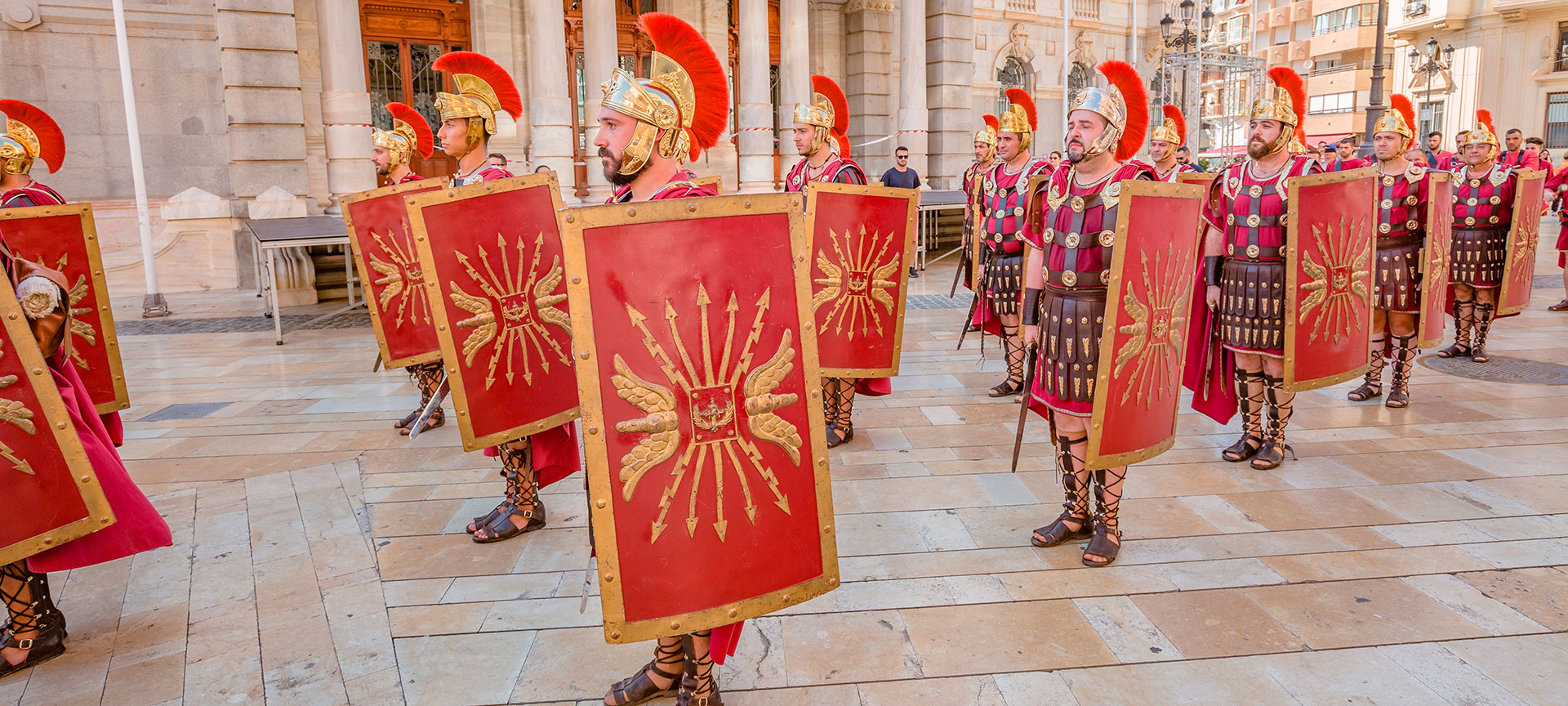

Carthaginians and Romans Fiesta
15 September 2024 - 24 September 2024

La Mar de Músicas Festival
19 July 2024 - 27 July 2024
Cartagena International Film Festival
23 November 2024 - 30 November 2024

Choose between thousands of activities to live your best life on holiday.


Home » Travel Guides » Spain » 15 Best Things to Do in Cartagena (Spain)
15 Best Things to Do in Cartagena (Spain)
With one of the world’s great natural harbours and rich mineral mines, Cartagena has been a prized location for millennia. The Carthaginians played a big role in its evolution as an ancient trading hub in the 3rd century BC before it was conquered by the Romans.
You can purchase a multi-ticket to get access to Cartagena’s numerous Roman sites to understand the complicated ancient history of the city. In the 19th century there was a mining boom, bringing a lot of wealth to Cartagena and transforming the historic centre with art nouveau architecture.
Let’s explore the best things to do in Cartagena :
1. Roman Theatre Museum
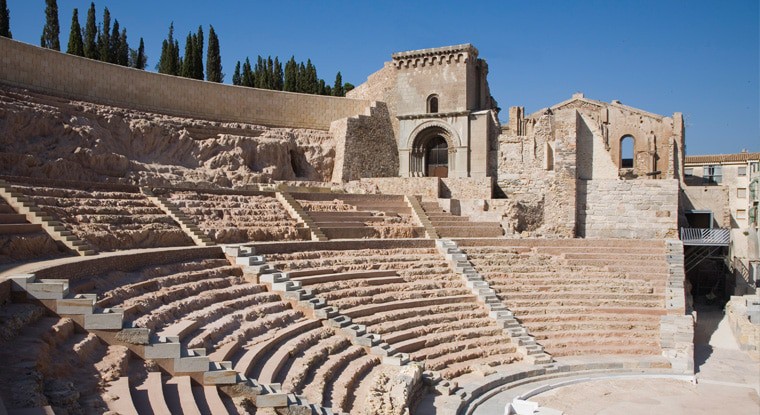
Of all the marvellous Roman landmarks in Cartagena, the 2,000 year-old theatre should be your first port of call.
It was discovered as recently as 1988 beneath the ruins of the Old Cathedral, which had been destroyed during shelling in the Spanish Civil War.
About two thirds of the theatre’s building material was still on site, which made possible the very detailed restoration you can see now.
In the museum you’ll study the fantastic artefacts discovered during the excavations, among them an altar to Jupiter, a statue of Apollo, inscribed lintels, plaques and also Islamic ceramics from the middle ages.
2. ARQUA, Marine Archaeology Museum

It’s fitting that this institution should be set in one of the western Mediterranean’s great ancient harbours, where new finds are made almost every year.
ARQUA is a national centre for marine archaeology: A place to can see remarkable historical artefacts from underwater sites, but also a research facility for experts and scholars in the field.
Find out how archaeologists analyse their discoveries at the laboratory area, which has interactive displays for kids.
Among the many artefacts to check out are Carthaginian ivory tusks and the treasure of Nuestra Señora de las Mercedes, a frigate that was sunk in the early 19th century with 14.5 tons of gold and silver coins.
3. Modernist Architecture

In the late-1800s the mining industry made a handful of people very rich, and the most obvious expression of this wealth can be seen in the historic centre of Cartagena and nearby La Unión.
Cartagena’s centre already needed rebuilding in the late-19th century, after a federalist insurrection in 1874 wiped out half the city.
So towards the end of the century some gorgeous art nouveau buildings went up.
You could fit the best ones into a walking tour and they include the Palacio Pedreño, the Casino de Cartagena, the Casa Cervantes, the Palacio de Aguirre and the Gran Hotel.
4. Palacio Consistoria

You can enter one of Cartagena’s most impressive modernist wonders, the 100 year-old town hall on Plaza del Ayuntamiento.
This triangular palace was also a response to the mining boom in the late-19th century, as Cartagena had outgrown its former town hall.
After suffering from structural problems in the 90s the building was restored to its Belle Époque glory days ten years ago.
Take a few minutes to study the facade, composed entirely of white marble and topped with domes that are coated with local zinc.
Get closer and you’ll even see a few bullet holes from the Civil War.
There are English-speaking guided tours, showing you around the marble balustraded stairways and an exhibit of period tapestries.
5. Municipal Archaeology Museum

Furthest north of Cartagena’s ancient sites is a late-Roman necropolis, which was set on the shore of an ancient lagoon that has since disappeared.
It’s an enthralling site, because it contains some of the latest evidence of Roman settlement, dating from 300 to 700AD – a time of transition to Christianity.
The museum has plenty of items excavated from this site, but has also gathered a wealth of artefacts from around Cartagena.
You’ll get a full chronology of the area, from Neanderthal remains, through Phoenician ceramics to the tools discovered in the Roman mines in the mountains on the edge of the city.
6. Calle Mayor

Linking the Plaza de San Sebastián in the north with Cartagena’s town hall is a ravine-like pedestrian street paved with distinctive blue marble tiles.
It’s a typically Spanish “Paseo”, where families and couples will take a stroll together or meet friends.
The street is kept spotlessly clean and boasts many of Cartagena’s best modernist buildings.
By day you can drop by for a cup of coffee or some high-street shopping, and in the evening you’ll be tempted by the various restaurants and tapas bars in this handsome location.
7. Batería de Castillitos

An eerie time can be had at the tip of Cape Tiñoso, 30 minutes from Cartagena and reached via dirt roads.
At 250 metres you’ll be able to gaze back at the extraordinary mountainous landscape of this natural park.
But also here is an installation that mixes frivolous architecture with meaty and sinister artillery guns.
It was built in the mid-1930s during the rule of Primo de Rivera as part of a series of batteries defending Cartagena’s coast.
Whimsical medieval-style turrets blend with the mountainside and look strange next to the menacing, black Vickers-Armstrong guns.
Use the torch on your phone to investigate the tunnels in the fortified area.
8. Military Museum

Cartagena has had a large military presence for thousands of years, and in modern times a number of Spanish army units have been based in the city.
You can see a great deal of this heritage in one place, and it’s an attraction that will blow your mind if you’re into military hardware.
The museum building was constructed in the late-18th century and in the courtyard you’ll spot an undetonated shell wedged in a wall from the insurrection in 1874. On show are tanks, missiles, field telescopes, light arms, a number of heavy-duty guns and all kinds of other military equipment.
The museum also has the largest collection of hand-made military models in the world, with the Guinness certificate to prove it!
9. Spanish Civil War Museum

The war from 1936-39 was one of the darkest moments in Spain’s history, and Cartagena didn’t escape the destruction.
The city was a Republican military stronghold, and as you may have noticed it was well-defended from sea.
This made it a target of bombing raids by the Nationalist forces (with help from the Nazis) so shelters like this one were built around the city.
Down here you’ll appreciate what people had to do to survive, and will also see original signs, propaganda posters and other artefacts.
There are moving first-hand accounts about the conflict, and you’ll learn of the ingenious ways the city attempted to trick the Nationalist forces into bombing the wrong locations.
10. Casa de la Fortuna

You’ve seen the necropolis, the theatre and the history of the port; now’s your chance to find out how Roman Cartagena’s wealthy citizens lived.
This domus’ name comes from a Latin inscription on its back entrance: “Fortuna Propitia”, meaning “good luck” and it would have greeted all visitors.
It’s easy to get a feel for the site as there’s so much of the walls and decoration remaining, as well as a stretch of the roman road outside.
You can make out the hallway (atrium), bedrooms (cubiculum), dining hall (triclinium) and the owner’s office (tablinum). There are surprising features everywhere, including wall paintings and mosaic floors.
11. Naval Museum

Right on the port is this museum that covers Cartagena’s maritime military past.
It’s in a dignified 18th century waterside building that until recently was a college for marine personnel joining Spain’s navy.
The museum showcases memorabilia, weapons, navigational tools and offers detailed accounts of the turmoil on the 1870s.
An absolute must is the Peral Submarine, the world’s first battery-powered underwater vessel, that was launched in 1888. This prototype was tested for two years but never developed, despite being a great technological step forward and possibly the world’s first “U-boat”.
12. Castillo de la Concepción

Cartagena had long been in decline by the time the Moors arrived in Spain.
And for centuries it was believed that they hadn’t made their mark on the city at all, but excavation of the walls of this fortress in Parque Torres have shown that it was an Alcazaba, an Islamic fortified palace in the middle ages.
Long before that it had been a Roman temple to Asklepio, and the cisterns from that time are still intact.
Most of what remains now is from the 13th century, following the Christian “re-conquest”, with small pointers to this period visible in the carvings of eagles and rosettes.
Catch the lift to the top for supreme panoramas of the harbour and coastal mountains.
13. Playa de Calblanque

For a day of sun and sand you won’t regret going the extra mile to this unspoiled beach half an hour from Cartagena.
Playa de Calblanque is on the road to Cabo de Palos, the headland at the southern end of La Manga.
Take the exit for Calblanque and the road runs south towards the coast through farmland traced by the low arid mountains of the Calblanque Regional Park.
Beyond these peaks is a secluded 300-metre beach with sands the shade of burnt gold.
On quieter days you’ll have the beach almost to yourself, but don’t forget to bring refreshments as there’s hardly a sign of civilisation here.
14. Licor 43 Tour

A grown-up rainy day option is a tour of one of Spain’s most-exported liqueurs, Licor 43, distilled right in Cartagena.
Book ahead and you’ll take a two-hour trip around the facility, picking up loads of factoids from your multi-lingual guide.
For the uninitiated, Licor 43 is a 31% abv spirit, made with 43 different citrus fruits and spices, and goes best with ice and milk.
On the visit you’ll see the production process up close, from mixing to fermentation, ageing and bottling.
Try to avoid being the designated driver, because the tour concludes with cocktails!
15. Local Mines

As with many things in Cartagena mining was introduced to the area by the Romans.
The Sierra Minera is rich with an assortment of metals including silver, copper, zinc, lead, tin, manganese and iron.
Anyone who gets a kick out of industrial heritage will a closer look at the two mining attractions in the area: the La Unión Mining Park and the Las Matildes Mine.
At La Unión the Agrupa Vicenta mine will blow you away; it plunges 80 metres beneath the surface and has huge, navelike spaces and an underwater lake with reddish waters.
At both attractions you’ll see gear and infrastructure like miner’s quarters, compressor rooms, 19th-century derricks and carts for carrying minerals.
15 Best Things to Do in Cartagena (Spain):
- Roman Theatre Museum
- ARQUA, Marine Archaeology Museum
- Modernist Architecture
- Palacio Consistoria
- Municipal Archaeology Museum
- Calle Mayor
- Batería de Castillitos
- Military Museum
- Spanish Civil War Museum
- Casa de la Fortuna
- Naval Museum
- Castillo de la Concepción
- Playa de Calblanque
- Licor 43 Tour
- Local Mines

34 Things to do in Cartagena, Spain – 3 Day Itinerary
By Author Paulina
Posted on Published: June 3, 2020 - Last updated: July 7, 2023
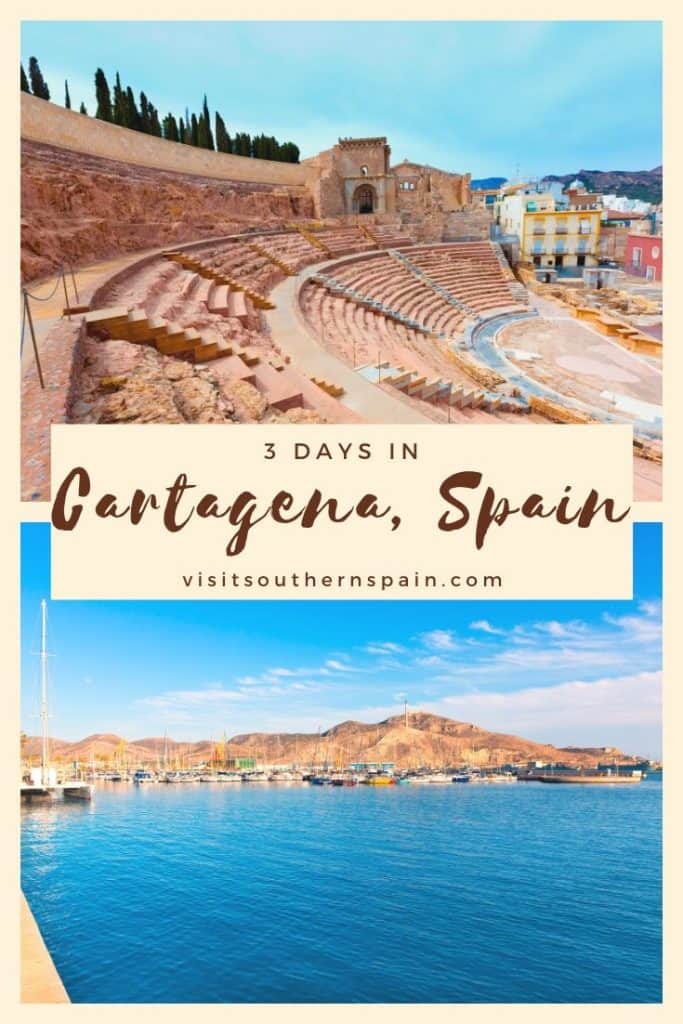
A travel guide to the best attractions in Cartagena, Southern Spain: the perfect Cartagena Itinerary
Looking for things to do in Cartagena ? Cartagena is one of the most amazing places to visit on the Mediterranean coastline, especially for those interested in ancient history. The city has ample Roman ruins and a rich maritime background.
Nowadays the city in Murcia province is one of the most important harbours in Spain for cruise ships, thus the starting point for many to explore Southern Spain.

Following this 3-day itinerary for Cartagena, Spain will allow you to fully explore this historical gem, and if in a hurry, it’s easy to adjust it by simply skipping a few locations – or just take your time, and enjoy the long holidays in Cartagena!
You, dear reader, support this blog. If you purchase through a link, we earn a small commission. As an Amazon Affiliate, we earn from qualifying purchases.
Top Things To Do In Cartagena, Murcia Region – Our Cartagena Itinerary For 3 days
- Visiting the Old Town and nearby monuments
- Exploring ancient Roman ruins
- Trying Andalusian cuisine and tapas
- Relaxing on the best beach in Cartagena
- Discovering wildlife from Southern Spain
Useful Travel Information About Cartagena
✈ Book cheap flights to Cartagena with Skyscanner ⚘ Avoid tourist traps and get the customizable “ Andalucia Like a Local ” itinerary. – Get it here ✔ Book tours in Cartagena with GetYourGuide ➳ Find the best hotels in Cartagena with Trivago ❖ Rent a car at the best rates with Discover Cars ✎ Never leave without travel insurance ! I get mine at HeyMondo . It is easy to set up, cheap and reliable. $ Withdraw money without hidden fees and avoid exchange charges with TransferWise (Free Mastercard debit card to spend money abroad)
Where is Cartagena?
Cartagena is located right by the Mediterranean coast in the Region of Murcia . You’ll find it only 50 km south-east from Murcia and next to the wildlife resort Sierra de la Muela, Cabo Tiñoso y Roldán.
How to get to Cartagena
How to get from Murcia to Cartagena:
Bus: Take a direct bus from Murcia Central to Cartagena bus station (45min). Train: Take a direct train from Murcia del Carmen train station (50min).
Get tickets in advance here
How to get from Almeria to Cartagena:
Bus: Take a direct bus from Almeria main bus station (4h). Train: There are no train connections between Almeria and Cartagena..
How to get from Alicante to Cartagena:
Bus: Take a direct bus from Alicante main bus station (1:50h). Train: Take a direct train from Alicante-Termino train station (2:12h).
Day 1: 1 day in Cartagena
Visit cartagena old town.
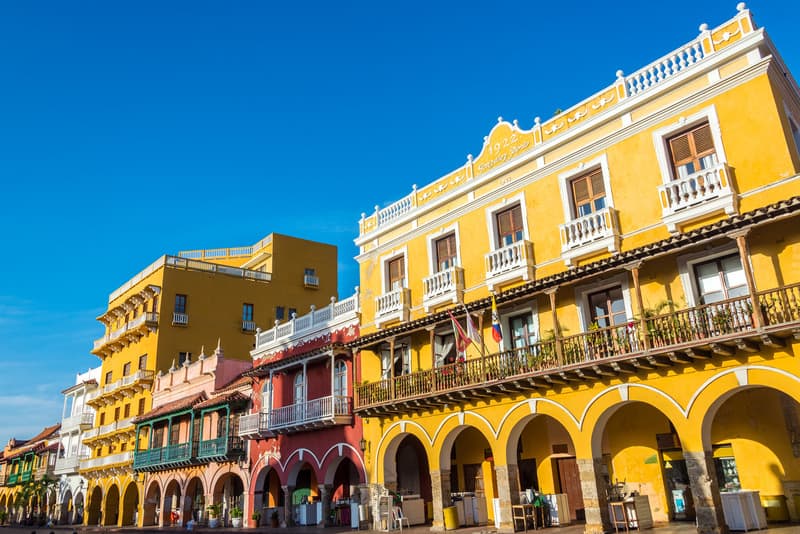
One of the best things to do around Cartagena city is to visit the old town of Cartagena. It’s one of the richest and full of character places in the city. It was constructed in 223BC, and was Hannibal ‘s capital city on the Iberian Peninsula, making it an area with plenty of historical monuments, squares, and buildings for you to discover!
It’s an amazing example of the beauty of Andalusian architecture, built within grotesque, little streets, lively tapas bars, and the overall Spanish atmosphere and chatter!
Make sure to stop at Plaza Ayuntamiento with the gorgeous town hall for a photo! The square is absolutely breathtaking!
In order to explore all hidden gems, take a guided tour . – Check the best prices here
Discover the Roman theatre and Roman heritage of Cartagena
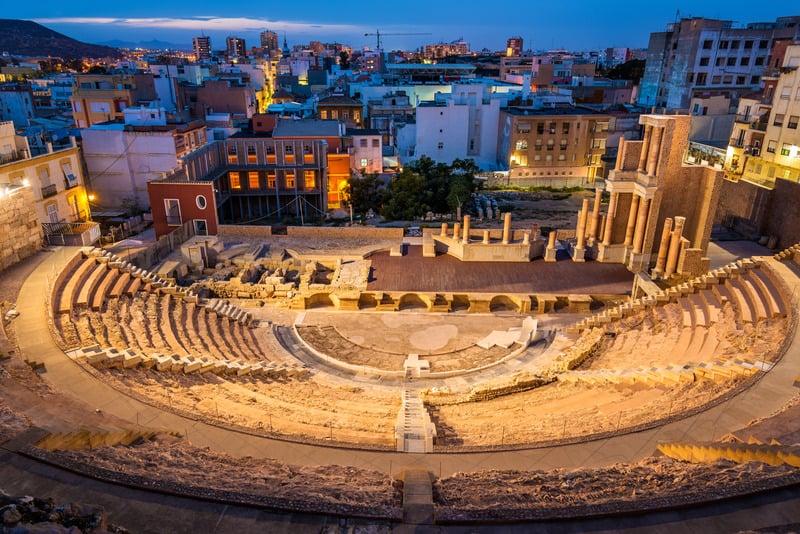
When walking around the Old Town, you simply cannot skip the Roman theater in Cartagena Spain! Built between the 5th and 1st centuries BC, the theater has been one of the best things to see in Cartagena and is a truly magnificent site to explore!
A great place for all interested in re-discovering the ancient history of Spain and a fantastic opportunity to learn more about the archeological remains and development of Spanish architecture.
Check rates for guided Roman tours here
Opening times:
Oct – April: Tues – Sat: 10:00-18:00/ Sunday: 10:00 – 14:00 May – Sept: Tues – Sat: 10:00 – 20:00/ Sunday 10:00 – 14:00
Head over to ARQUA, Marine Archaeology Museum
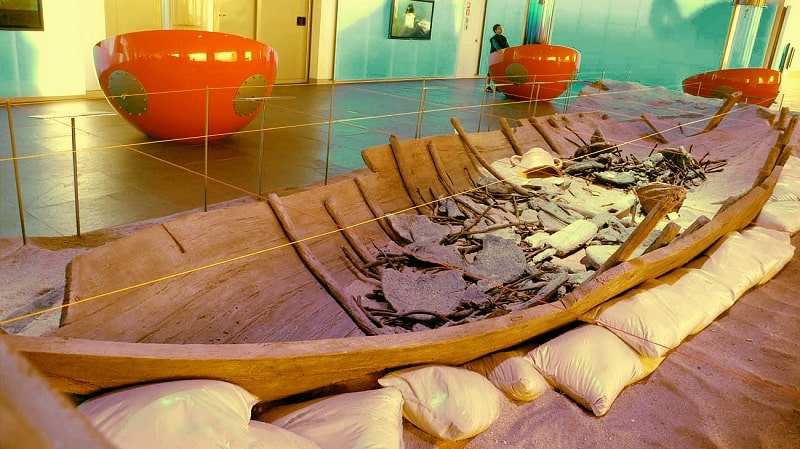
If you’re looking for museums in Cartagena, Spain, this museum is one of your best options.
Spending at least an hour in the Marine Archaeology Museum is simply a must! Known to be one of the best places to visit in Cartagena, the ARQUA facility is true underwater life and marine history wonderland set in a modern and well-designed building for you to relax and enjoy the tour!
Great exhibitions about the city’s development and marine life history are here for all travelers to marvel at and discover more about Cartagena, España! You can enter for free if you decide to visit on a Saturday after 2 pm!
Oct – April: Tues – Sat: 10:00-18:00 May – Sept: Tues – Sat: 10:00 – 20:00
Learn about history at the Punic Wall
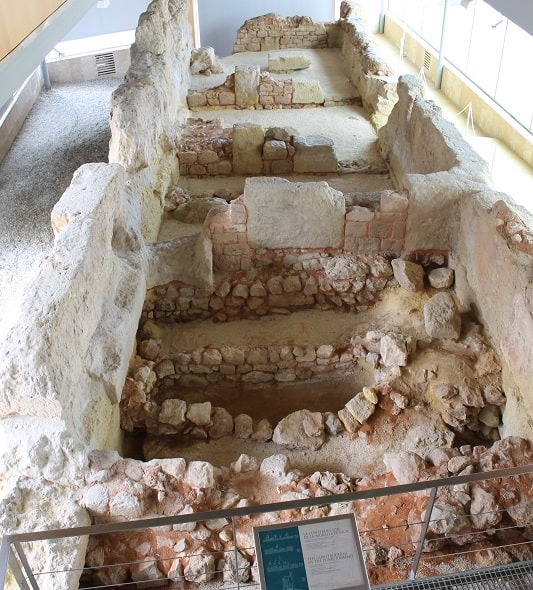
The Punic Wars between the Carthaginians and the Romans are known to be the most important moments in Cartagena’s history, and it’s a great idea to learn a bit about that period!
The legendary Qart Hadast founded by Hasdrubal in 229 BC and one of the few remaining Carthaginian relics – the wall – is a must-see when visiting Cartagena, Murcia. – Check guided Roman tours here
Lunch in La Catedral

After a busy morning, it’s time to sit down and relax, surrounded by the aromas and flavors of Southern Spain!
For an unforgettable experience head down to La Catedral ( Plaza Condesa de Peralta ) – one of the best restaurants in Cartagena, where you’ll be able to dive into the world of Spanish cuisine.
Try their delicious Tuna Tartare , Cod, and Baked Sea Bream if you’re seeking for the best quality seafood dishes in town!
Explore the Modernist architecture of Cartagena
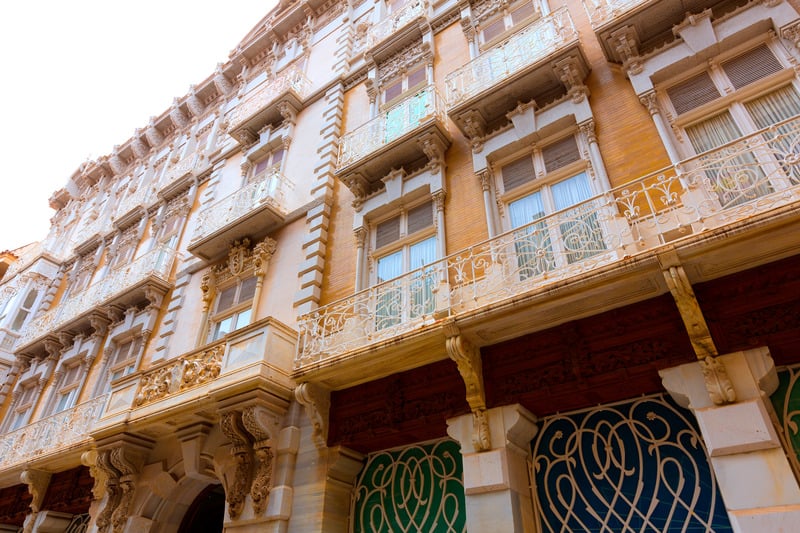
Architectural discovery does not only mean visiting museums and ancient ruins of Cartagena. Head down to Calle Mayor to discover the Art Nouveau buildings alongside the best shopping area in Cartagena.
You’ll find here plenty of local bars and restaurants as well as monumental sites and squares to marvel at!
There are plenty of hidden gems in Cartagena, that’s why we recommend booking a guided tour . – Check prices here
Visit the military museum of Cartagena
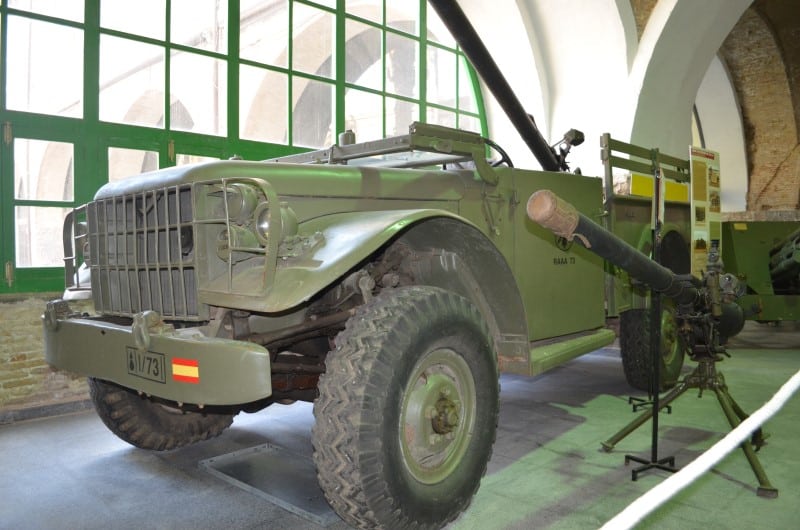
The Museo Militar is a true gem in terms of capturing Cartagena’s military history, and holds the world’s biggest collection of military models!
You’ll find here endless weapon collections and a great representation of the defense tactics of the city during its many years of war and conflicts!
The museum is free of charge and is a must-see when discovering the Murcia coast.
Opening times: Mon – Fri: 10:00 – 13:30
Take a picture at Palacio Consistorial
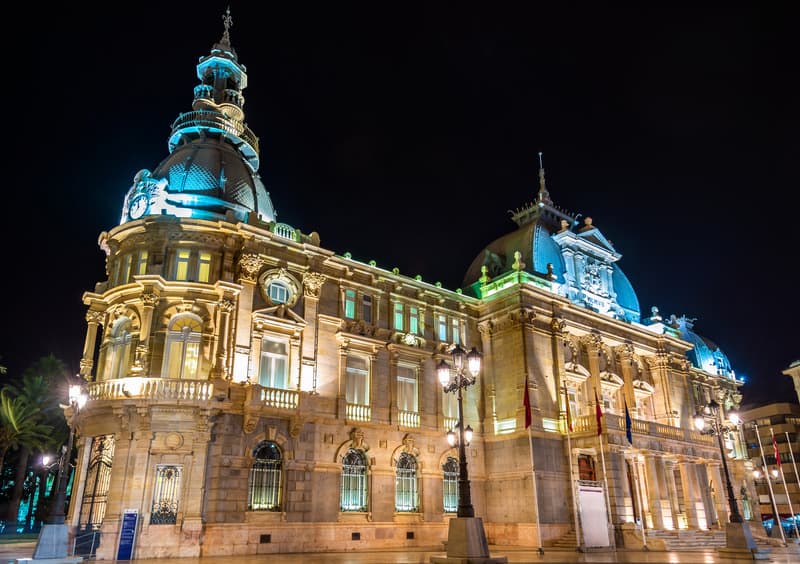
The City Hall is, without doubt, one of the most outstanding buildings in Cartagena. It was built between 1900-1907 by Tomás Rico and Francisco de Paula Oliver and will definitely catch your attention with its eclectic French style.
A truly stunning place, not only to enjoy while wandering within its ornamented halls and corridors but also a beauty to marvel at from the outside square, while enjoying a sunny afternoon!
Tues – Fri: 10:30 – 13:30/ 17:00 – 19:00 Sat: 10:30 – 13:30/ 17:00 – 20:00 Sun: 10:00 – 13:30
Marvel at Casa de la Fortuna
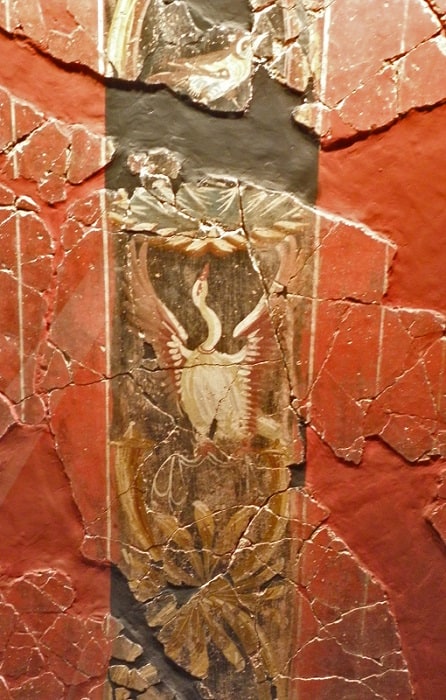
Visiting Casa de la Fortuna will take you back in time to the domestic ways of the Roman Cartagena. A great place to learn and discover the traditional household settings from the 1st century, and a very interesting way of presenting a museum within Roman remains.
You’ll find here plenty of personal objects, ancient dishes, murals, mosaics, and more, which will allow you to relive the history of the first settlements in Southern Spain .
Opening times: Tue – Sun: 10:30 – 15:30
Go shopping in Calle Mayor, Cartagena
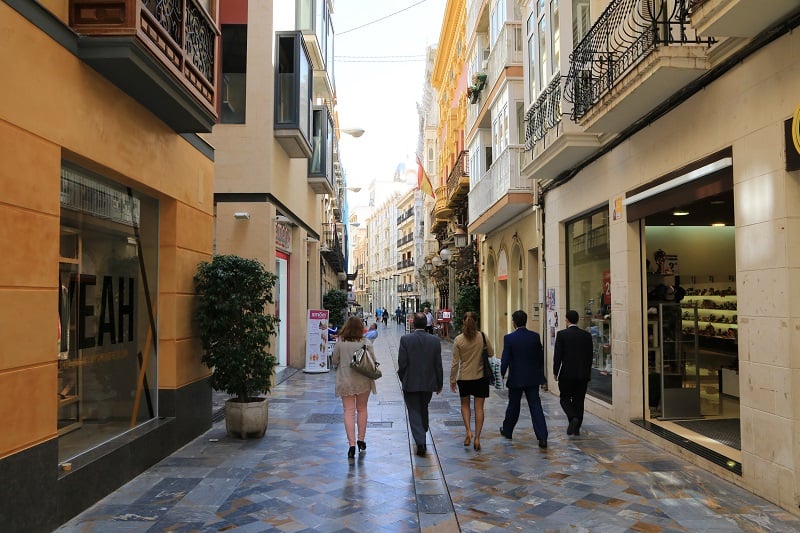
The main shopping street, Calle Mayor , runs from the Cartagena port area into the center.
Filled with local markets, lively bars, restaurants, and petit cafes, here you’ll be able to enjoy some good old shopping and grab a delicious coffee if you need a break from retail therapy!
A great place to enjoy the Carthaginian lifestyle and get to know the ways of the locals. – Check guided tours here
Enjoy tapas in Cartagena

The best way of ending your first day in Cartagena is definitely going out for tapas! Close to Calle Mayor , you’ll find plenty of original and unique places to grab a delicious Tinto de Verano and try some Andalusian delicacies!
In order to find the best tapas in Cartagena, have a look at the guided tapas tours . – Check prices here
Check out one of the best tapas bars in Cartagena and fill your belly with amazing treats:
- La Fortaleza (Calle Canon 7) – best for crispy Spanish croquettes
- Las Termas Del Pincho (Calle Honda 9) – great variety of pinchos
- Tasca Tio Andres (Paseo Alfonso XIII 46) – delicious seafood
Visit Spanish Civil War Museum
Visiting this museum is surely one of the most interesting things to do in Cartagena. The museum is extremely well organized, and will definitely make an impact on your perception of the Civil War while showing the harshness and difficulties of life during the bombardings.
You’ll be led through a channel of tunnels with audio-visuals and very well restored sets – making it truly an intense learning experience!
Opening times: Tue – Sun: 10:00 – 19:00
Visit Naval Museum
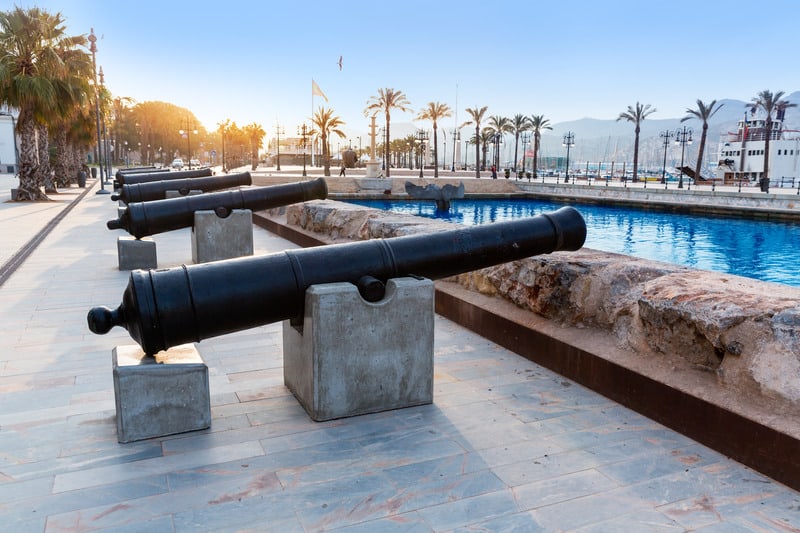
You’ll find the Naval Museum just next to the Puerto de Cartagena . It’s a fascinating place where you can discover the underwater world of the navy, and explore the machinery and weapons of Carthaginian ships.
The museum is excellently prepared for visitors and holds plenty of large scale models of warships, showing their evolution through the ages.
The general entry is free of charge, but you will be able to leave a donation and support the local museum!
Opening times: Tues – Sun: 10:00 – 14:00
Climb Castillo de la Concepción
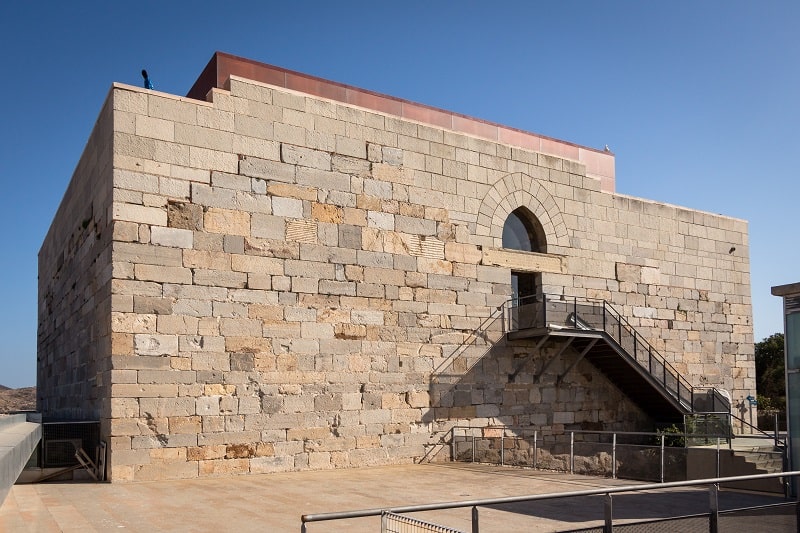
For a breathtaking view of the city, make your way up the castle of Cartagena! It’s located on a hill in the city center, where it has served as a Roman temple, a Muslim fortress, a medieval castle, and the watch out point during the Civil War.
Feel free to climb the lengthy staircase, or take the comfortable lift up to the top, and enjoy the incredible panorama of Cartagena and the port.
Opening times: Tue – Sun: 10:00 – 17:30
Lunch in La Alacena de Maria
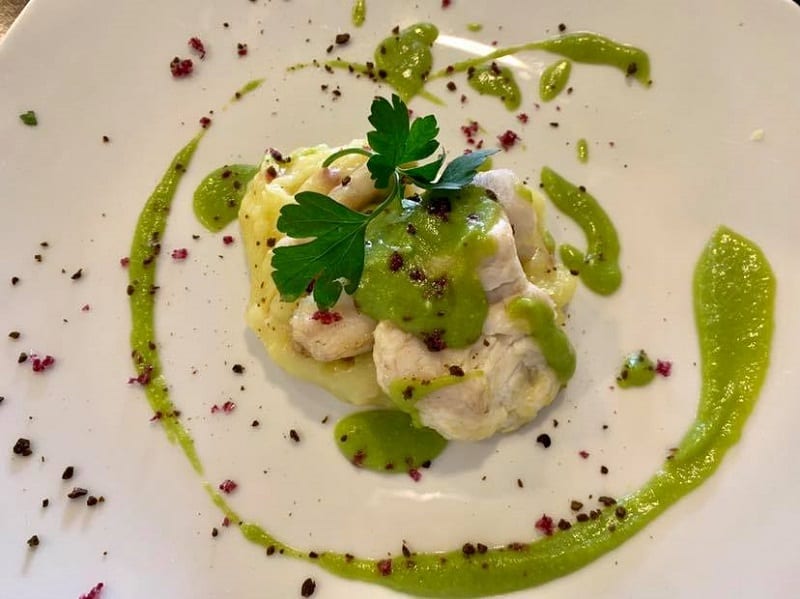
When visiting the Murcia coastline you must try the delicious and fresh seafood dishes this region has to offer.
La Alacena de Maria (Calle Real 24) is known to be one of the best restaurants in Cartagena for lunch, and will take you on a delicious exploration of fresh and tasty seafood, prepared in the most traditional way!
Try their Merluza con Parmentier de jamón y crema , and allow the chefs to surprise you with not only flavors but also a gorgeous presentation!
Mon – Sat: 9:00 – 11:00/13:00 – 16:00 Sun: 13:00 -16:00
Explore the town’s only beach: Cala Cortina
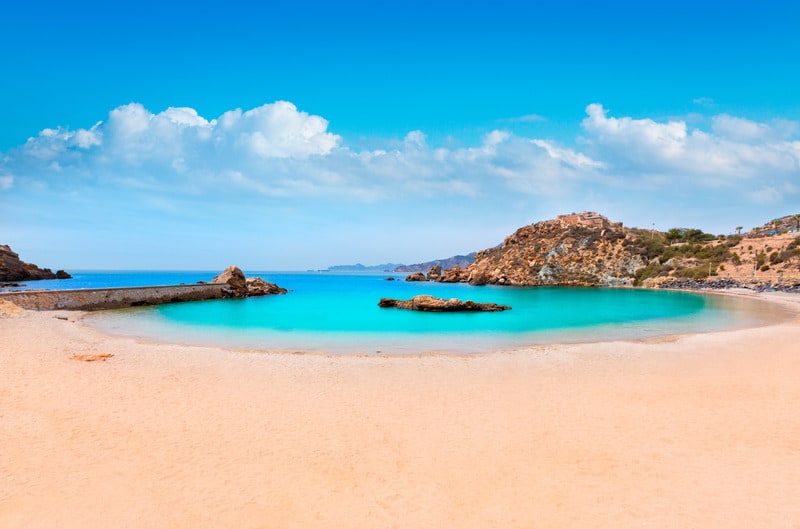
If you’re researching Cartagena beaches, there’s actually just one. Beaches in Cartagena are not as common as in other coastal cities, but you’ll find a beautiful little cove located a few minutes outside of the city – Cala Cortina !
A lovely sandy beach with clear water is a perfect spot to rest from the city hustle and bustle, and enjoy some sunbathing or snorkeling.
Right next to Cartagena beaches you’ll also be able to grab some tapas and enjoy a delicious sunset drink, thanks to many bars and restaurants just across the street!
Do a sailing cruise in Cartagena
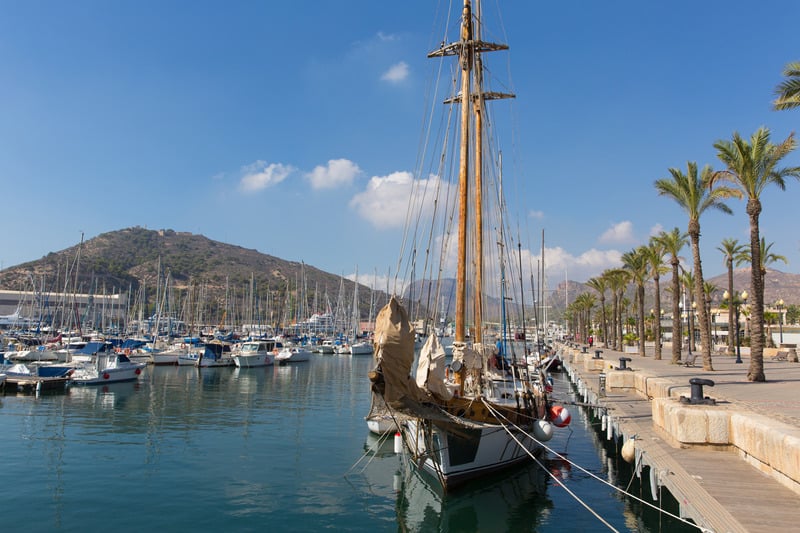
If you’re looking for a unique and exciting way to spend time in Cartagena why not hoping on a cruise boat to explore the coastline!
Cartagena’s port has many sailing trips and cruises to offer, and it’s a great way to enjoy a magical sunset from the sea waters.
Seeing the Roman city from a distance will definitely become a strong and beautiful memory of your trip to Spain. – Check sailing tours here
Finish the day with a food tour in Cartagena
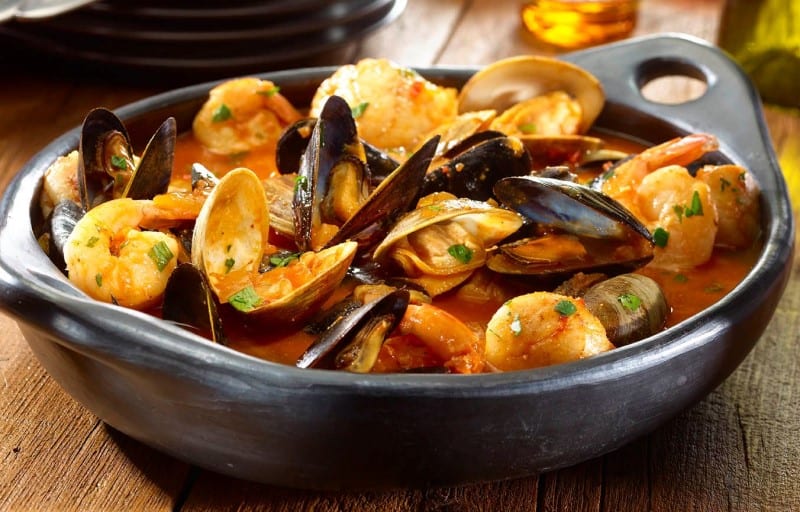
Taking part in a food tour is one of the best plans for the evening! Spanish cuisine is famous all around the world and with such tours, you’ll be able to discover hidden restaurants and delicious treats of Cartagena.
You’ll be able to try one of the most traditional Cartagenian dishes, such as Mojarra or Cazuela de Mariscos !
- Street Food Tour of Cartagena
- Cartagena Tapas and Culture
To learn more, please visit our ultimate guide about the best Andalusian food .
Check food tours in Cartagen, Spain here
Enjoy dinner in the best restaurant in Cartagena
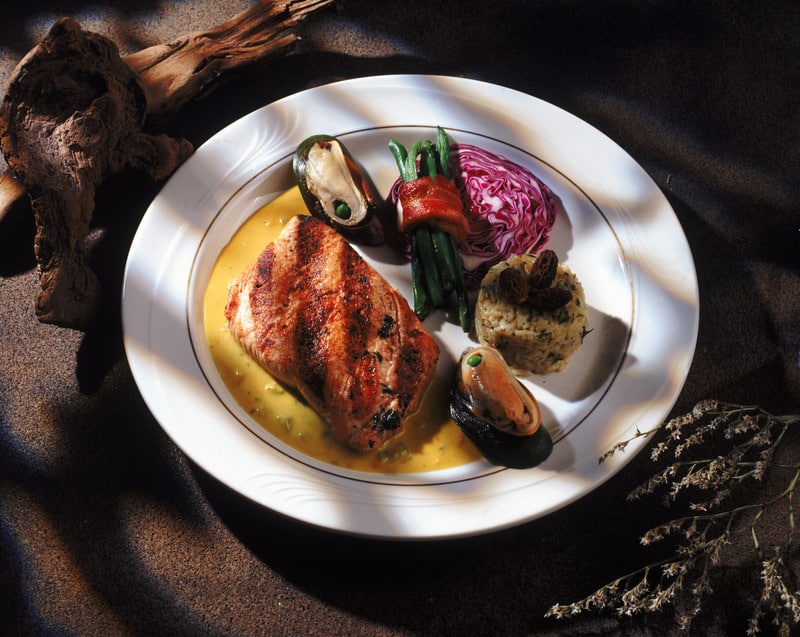
La Marquesita is known to be one of Cartagena’s best restaurants, and is a perfect choice for an elegant dinner in a friendly atmosphere!
A lovely interior, together with the very helpful staff and talented chefs will make your evening a memorable and delicious experience.
Try the famous Arroz y Bogavante or Bacalao Encebollado , and don’t forget to order their delicious dessert – Corazon de Mousse de Chocolate Negro !
Day 3: 3 days in Cartagena
If you’ve seen all the parts of Cartagena that you’d like to, day 3 can be spent visiting places near Cartagena like Murcia and Mar Menor.
Day trip from Cartagena to Murcia
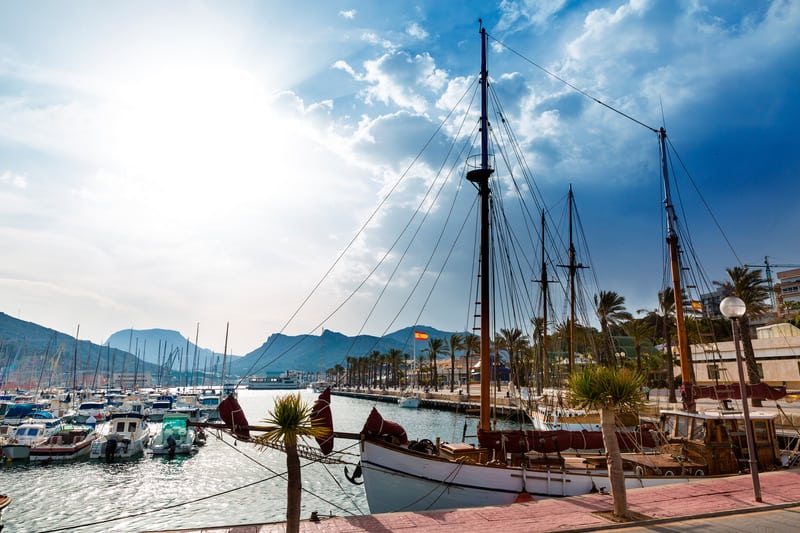
Murcia is located just 50 km north from Cartagena and is a perfect destination for a day trip, especially if you’d like to change from Cartagena’s Roman-style to a more modern, yet still authentic, Spanish city.
Not to mention the famous Murcian cuisine you’ll be able to discover when rumbling through tapas bars in town!
Best places to see in Murcia:
- Cathedral de Santa Maria
- Jardin de Floridablanca
- Plaza Cardenal Belluga
For more information on Murcia, please visit the following guide with the perfect 3-day itinerary for Murcia . For now, why not try our Murcia salad recipe or even our Puntillitas Fritas recipe .
Day Trip to Mar Menor from Cartagena
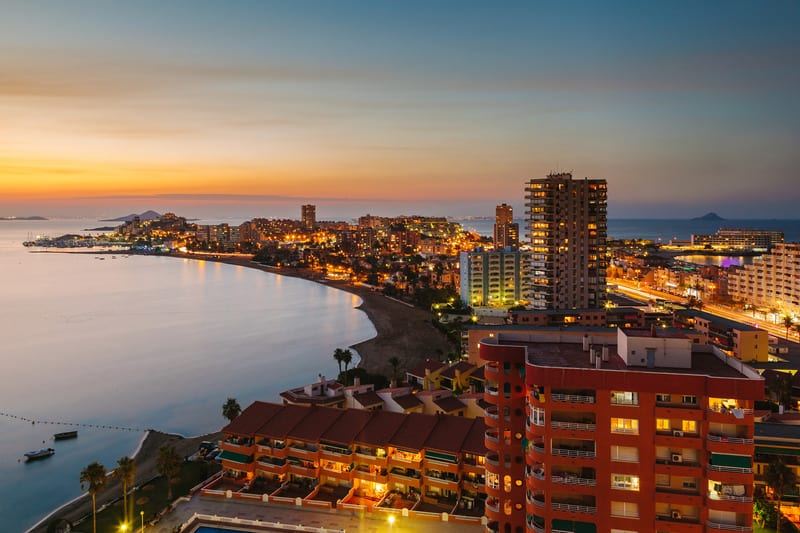
Another great idea for a day trip would be visiting the extraordinary areas of Mar Menor – a beautiful saltwater lagoon surrounded by Spanish port towns.
It’s a great place to enjoy the wilderness of the Murcia coast, and explore the beauty and roughness of the Mediterranean cliff sides. Best places to see around Mar Menor:
- Puente de la Risa
- Puerto Deportivo Tomas Maestre
- Cala Del Pino
- Las Charcas Mud Baths
Day Trip to La Magna from Cartagena
La Manga is located a 30-minute drive away from Cartagena. The ALSA – L20i Puebl bus also runs frequently between La Magna and Cartagena and takes 1 hour, 5 minutes.
Also known as La Manga del Mar Menor, the area is a seaside spit of Mar Menor.
The area is famous for its beaches, especially Playa de Paradiso and Playa de La Cala . Playa de Paradiso is one of the best beaches in Southern Spain .
Mar Menor is Mar Menor is the largest saltwater lagoon in Europe and is even known to have therapeutic properties. There are many watersports available to try including sailing, kayaking and paddleboarding.
Also in the area is Calblanque Natural Park , where there are plenty of hiking options and stunning coves for swimming.
If you plan to stay late, the area is famous for its nightlife. The ‘La Magna Strip’ has many bars and restaurants as well as shops open late.
Day Trip from Cartagena to Alicante
Alicante is located 1 hour, 32 minutes drive North of Cartagena. The city is the capital of the Alicante region. It’s best to drive or book a private transfer; otherwise, you will have to travel by bus via Murcia.
Alicante is a beautiful city with ample beaches, a stunning marina and is home to Santa Barbara Castle, which towers over the city. Alicante is also one of the best places in Spain for good-value tapas.
Here are the best things to do in Alicante on a day trip from Cartagena:
- Walk along the Explanada de España
- Visit the MACA Contemporary Art of Picasso
- Walk around the Basilica of St. Mary
- Discover Mercat Central d’Alacant
- Walk along Deportiva del Puerto de Alicante
Go Horseback riding near from Cartagena

Thanks to the incredible beaches and natural resorts all around Cartagena, you can also decide on going on a Horseback riding trip !
Whether you’d like a romantic ride on the beach or relaxing forest retreat, you’ll be able to experience a thrilling and bonding experience with nature and horses. – Check guided rides here
At the beginning of this article, we mentioned how to get from Almeria to Cartagena, but we didn’t mention the things to do in Almeria . Be sure to check it out since it is only a short trip from Cartagena.
Best Hotels in Cartagena, Southern Spain
Below you’ll find the 3 top spots from luxury to cheap accommodation in Cartagena , which will provide you not only with a good night’s sleep, but also great commodities and location.
Hotel Sercotel Alfonso XIII **** – Luxury
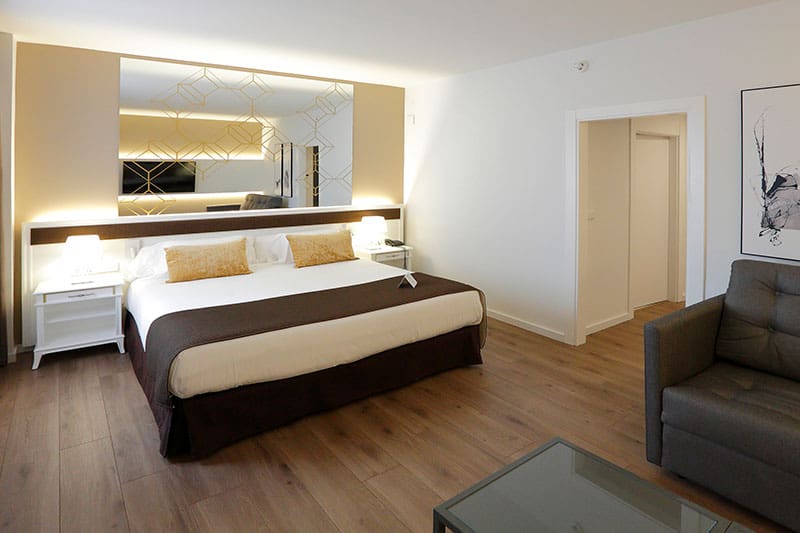
One of the best hotels in Cartagena Spain, located close to the Punic Wall, is a great choice for the most demanding travelers.
The rooms are very spacious and well designed, allowing you to really make yourself comfortable and feel at home!
The Sercotel Alfonso XIII offers additional services such as free wifi, restaurant, bicycle, and car rental, free parking and conference rooms – all to make your stay a pleasant experience! – Check rates & reviews here
Sercotel Carlos III *** – Mid-Range
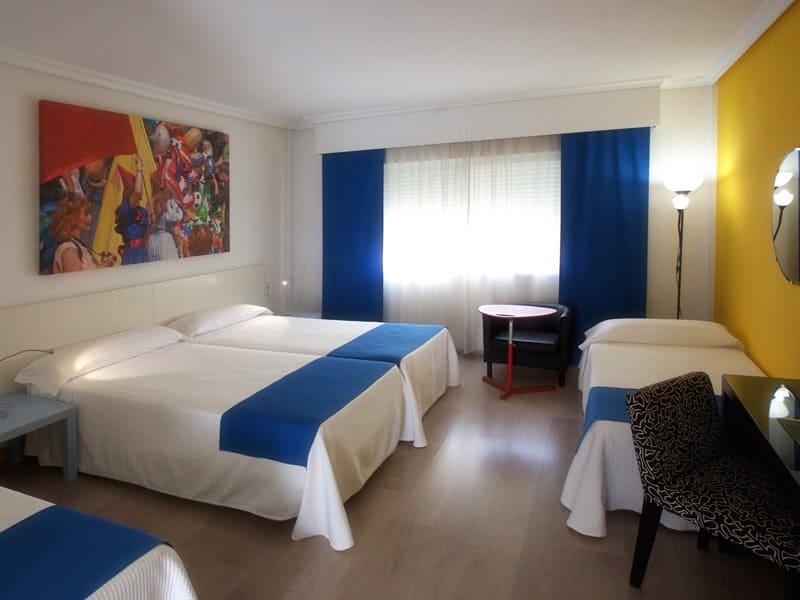
Located just 500m from the main bus station, and very close to the marina, Sercotel Carlos III is a great place to enjoy your stay! A very friendly, colorful decor and tidy rooms are all that you need to feel good and rested.
The hotel offers additional services such as free wifi, restaurant, and breakfast buffet, bicycle rental, indoor workout room, and parking. – Check rates & reviews here
Hotel Los Habaneros *** – Budget
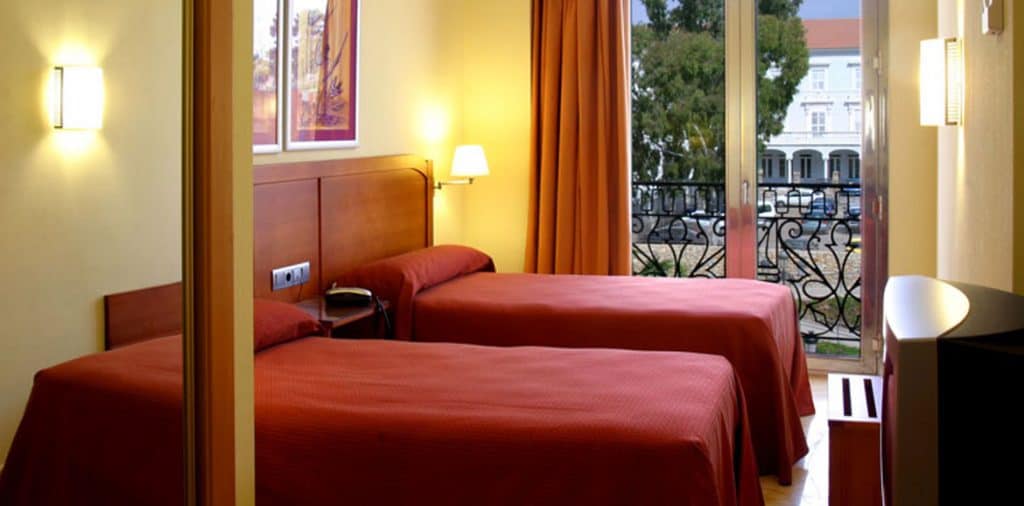
Hotel Los Habaneros is located near the Roman Theater and the Port of Cartagena, and is known to be a great choice for budget travelers!
Decorated in a traditional Andalusian style, you’ll find clean and tidy rooms attended by very helpful staff on site.
The hotel offers additional services such as: free wifi, bar, bicycle rental, paid parking and meeting room. – Check rates & reviews here
Getting Around Cartagena
Biking and walking are definitely the best ways to discover Cartagena! The city is very well connected by cycling and walking paths and it’s a joy to explore it on foot.
Not to mention that the distances between the main tourist attractions are very small, and you’ll be able to reach them in no time!
Best Attractions in Cartagena, Spain Map
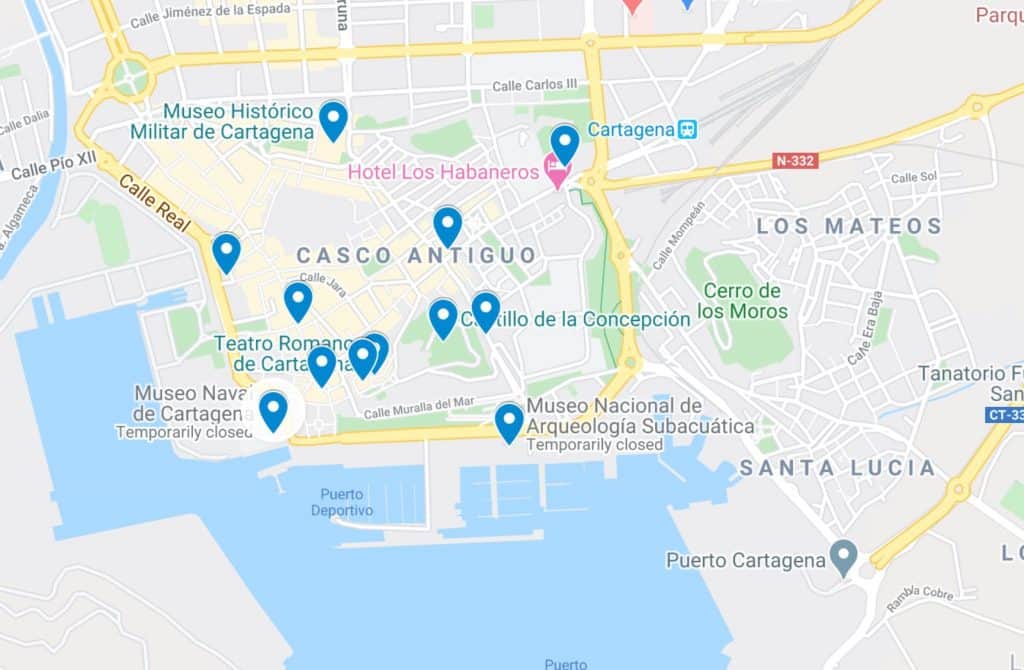
A short FAQ about Things to do in Cartagena, Spain
What are things to do in cartagena, spain with family.
Discover the Roman theatre and Roman heritage of Cartagena are great things to do in Cartagena with a family.
What are free things to do in Cartagena, Spain?
Visiting the ARQUA – Marine Archaeology Museum, the military museum of Cartagena, and the Naval Museum are some free things to do in Cartagena, Spain.
What are unusual things to do in Cartagena, Spain?
Doing a sailing cruise in Cartagena is quite an unusual thing to do in Cartagena, Spain.
What is Cartagena, Spain, known for?
Cartagena is renowned for its rich maritime history, impressive Roman Theatre, and Modernist architecture. It is also famous for its natural harbour and beautiful old town.
Is there good nightlife in Cartagena, Spain?
There isn’t a huge nightlife in Cartagena. However, there are plenty of bars open late, some with live music.
is Cartagena Spain worth visiting?
Yes, there are lots of amazing things to do in Cartagena from exploring the old town to discovering more about Murcia’s Roman heritage. Cartagena is also home to Cala Cortina beach!
Where do cruise ships dock in Cartagena, Spain?
Cruise ships dock at Cartegena cruise port which is called Pier Alfonso XII Cruise Terminal. From here you can walk to the city centre. There is also a terminal slightly further away from the Cartagena centre called Muelle de la Curra. From here, there is a shuttle bus to the centre.
Can you walk around Cartagena, Spain?
Yes, Cartagena is a very walkable city. You can walk between all the main attractions. There are also lots of hikes you can do from Cartagena.
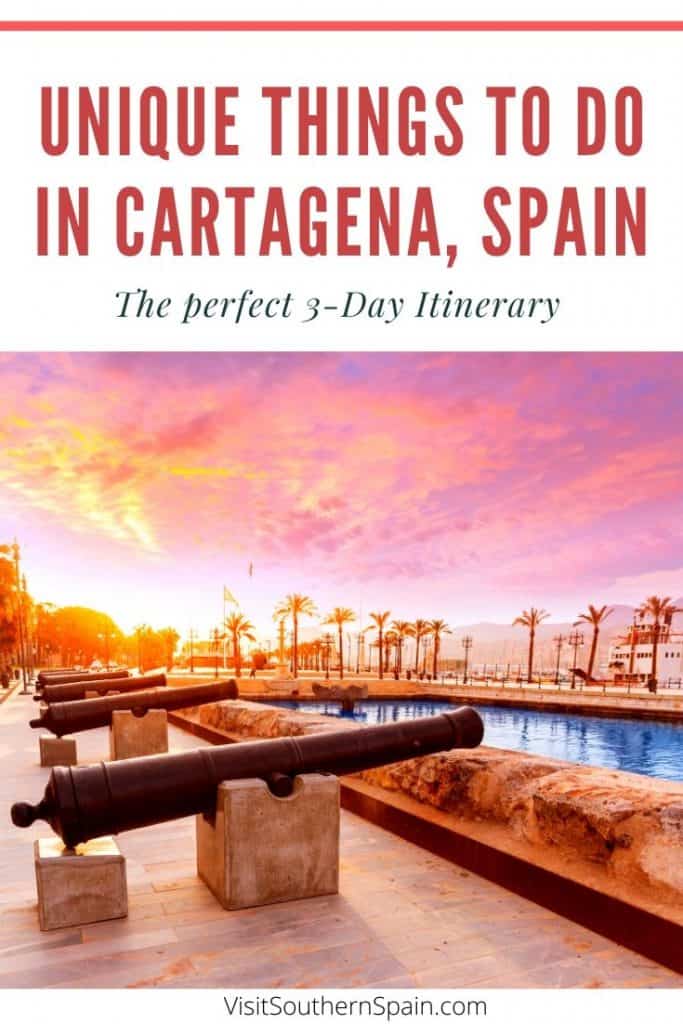
Hola, I’m Paulina! Together with my team, we are passionate about Southern Spain. Here we share all you need to know for great times in Southern Spain with the best places to visit, stay and, of course, the best food to eat.
Let’s dive in and explore Southern Spain’s outdoors, food and culture con pasión!
Thursday 8th of June 2023
Thank you for this itinerary! hoping to explore Cartagena next Tuesday, can't believe there's a beach too!
Kim Ratcliff
Monday 12th of October 2020
I have a Silver & Clothing shop in Calle San Fernando called Mystic Sol could I advertise with you ?kind Regards Kim .
Thursday 3rd of December 2020
Hi Kim, I sent you a mail! Can't wait to hear from you!
10 Best Things to Do in Cartagena, Spain
:max_bytes(150000):strip_icc():format(webp)/d0598453a36aa6f71cb57cc8be377f9de9d6b98d-582c8418c5d24bcbb4ccdfcbf6293fce.jpg)
Eve Livesey / Getty Images
Founded in 227 B.C. by the Carthaginian Hasdrubal the Fair, Cartagena, a vibrant port city on Spain’s southeast Mediterranean coast, has a long history with a plethora of monuments documenting the passing of many civilizations.
Being a rather small city, it’s easy to walk from one site to the other, starting with the remains of the Punic Walls, continuing on to the second largest Roman Theatre of the Iberian Peninsula, enjoying the splendor of Art Deco buildings, and finishing the day with a panoramic view of the city and port on board a harbor cruise. Additionally, lovers of all things maritime will be delighted by the Naval Museum and a model of the world’s first submarine, invented by Cartagena-born Isaac Peral and launched in 1888.
Tour the Roman Theatre
Cartagena presumes of the second largest Roman Theatre on the Iberian Peninsula. Dating back to the first century, it was opened in honor of the visit of Gaius Cesar, grandson of Emperor Augustus.
The theatre could accommodate more than 6,000 people. It’s accessed via a pink building a which also houses the Roman Theatre Museum. Over three floors, the museum has a huge collection of Roman statues and artifacts, then leading via a glass bridge into the theatre itself. Behind it and visible from the theatre’s top tier are the Cathedral of Cartagena and remains of a Byzantine Wall.
Understand Ancient History at the Punic Wall
Cartagena has made a great effort to explain the sometimes complicated history to visitors. The Punic Wall Interpretation Center protects the remains of Cartagena’s oldest part, the Punic Wall, under glass walkways, whilst a video explains the founding of Cartagena. It’s of particular historical value because there are very few Punic remains Spain. During excavations, the 16th century Hermitage of San Jose was discovered. What remains is the crypt of the monks, with bones and skulls resting in several stories of burial niches and a quite macabre depiction of the Dance of Death.
Marvel at Casa de la Fortuna
Cartagena lived through its heyday when it was part of the Roman Empire. The wealth of the citizens derived from trade and abundant silver mines in the surrounding countryside.
The Casa de la Fortuna is a well preserved Roman villa dating from the first century. Marvel at the floor mosaics and the colorful wall paintings, among them a swan which is the most famous image of the villa.
Furniture, tools, and mannequins dressed in the clothes of the times evoke a vivid image of how a rich Roman merchant lived. Only discovered in 2000, the villa originally extended to 2,200 square feet. At the rear of the house you can see part of a Roman road with huge stone slabs and remains of their advanced canalization.
Climb the Concepcion Hill
Dominating Cartagena’s skyline is the 13th century Castle of Concepcion on top of the hill of the same name. Before King Alfonso X of Castille conquered Cartagena from the Arabs in 1245, it was the site of a Roman temple and an Arab Alcazar.
Access is from sea level at the King Charles III rampart via a winding path through a landscaped park full of flowers, ponds, statues and peacocks. The castle often features exhibitions, most recently of splendid Renaissance costumes. Make your way down via a footbridge to the outside elevator, illuminated at night.
Discover Art Deco Along Calle Mayor
Calle Mayor is the main pedestrian shopping street of Cartagena and the site of many outstanding Art Deco buildings. At the beginning of the 20th century, the growing mining industry brought wealth to the city and with it richly decorated townhouses and public buildings.
Prime examples are the triangular Town Hall and the casino. Casinos in Spain are not for gambling, but rather they are the seat of a cultural society.
Pass by the former Grand Hotel, now a bank, and the pink and white Casa Aguirre which also houses the Museum of Regional Modern Art. Finally, take a break at Cartagena’s most traditional bar, La Tartana.
Ride the Waves on a Harbor Cruise
LUNAMARINA / Getty Images
The natural, sheltered port of Cartagena is the main reason why so many civilizations fought over it. Enjoy the best view of the city from the sea with an entertaining harbor cruise. It leads past the cruise ship dock and commercial port into the open sea past two castles that guard the entrance to the port.
There are two options : a catamaran and or a closed boat with a sundeck. Both depart from the quay crossing Paseo Alfonso XII and down the steps. The tour in the boat lasts approximately an hour, while the catamaran trip is three hours and includes a stop at the recently refurbished castle Fuerte de la Navidad.
Learn about Cartagena’s Naval History
It’s not surprising that a city so closely connected to the sea has several venues dedicated to maritime history.
The Naval Museum, located in a fine 18th century building on the waterfront features a vast collection of tall ship models, naval uniforms, medals and the Peral submarine, which was built in the late 19th century by Spanish sailor Isaac Peral for the country's Navy.
Shiver at the Spanish Civil War Museum
The Spanish Civil War, fought from 1936 through 1939, brought suffering and destruction to Cartagena too. Coming down in the lift from Concepcion Hill, turn left and enter the Spanish Civil War Museum, a former shelter for the citizens and a dramatic testimony to the hardship of this dark time in Spanish history.
Become a Moor or a Roman
Visitors in September are in for a treat as they're given the chance to relive history up close and personal. The biggest festival, called Moors and Christians, takes over the city for two weeks with re-enactments of the battles and thousands of "soldiers" and "civilians" in historical costumes taking part in plays and parades. Everybody wears a piece of fancy dress and clinks glasses in the Feria precinct (the football stadium) in one of the many tents.
Explore Underwater Archaeology at ARQUA
Matías Soria / CC BY-SA 3.0
Further along the waterfront stands the modern building of ARQUA, which is the national center for maritime archaeology. A museum as well as a research facility for scientists, ARQUA’s most outstanding exhibit is a treasure of 14.5 tons of gold and silver coins recovered from the fregatte Nuestra Señora de las Mercedes that sunk in the early 19th century.
10 Best Things to Do in Sagunto, Spain
Top 20 Most Popular French Cities for International Visitors
Top 20 Most Popular UK Cities for International Visitors
20 Best Things to Do in Barcelona
The 15 Best Things to Do in Alicante, Spain
Madrid on a Budget
The Most Architecturally Significant Building in Every State
The 9 Best Things to Do in Saint-Tropez
The 9 Most Romantic Things to Do in Madrid
Cubas Capital City of Havana
Top 15 Destinations in the French Riviera
North Coast of France: The Ultimate Road Trip From Dieppe to Calais
The 12 Best Things to Do in Casablanca
The Top 12 Things to Do Around the Eiffel Tower
The 12 Best Day Trips From Barcelona
Top 18 Things to Do in Athens, Greece
Must-see attractions in Cartagena

Museo Nacional de Arqueología Subacuática
This excellent, attractive space delves into the depths of the fascinating world of underwater archaeology. It starts off by explaining the work of those…
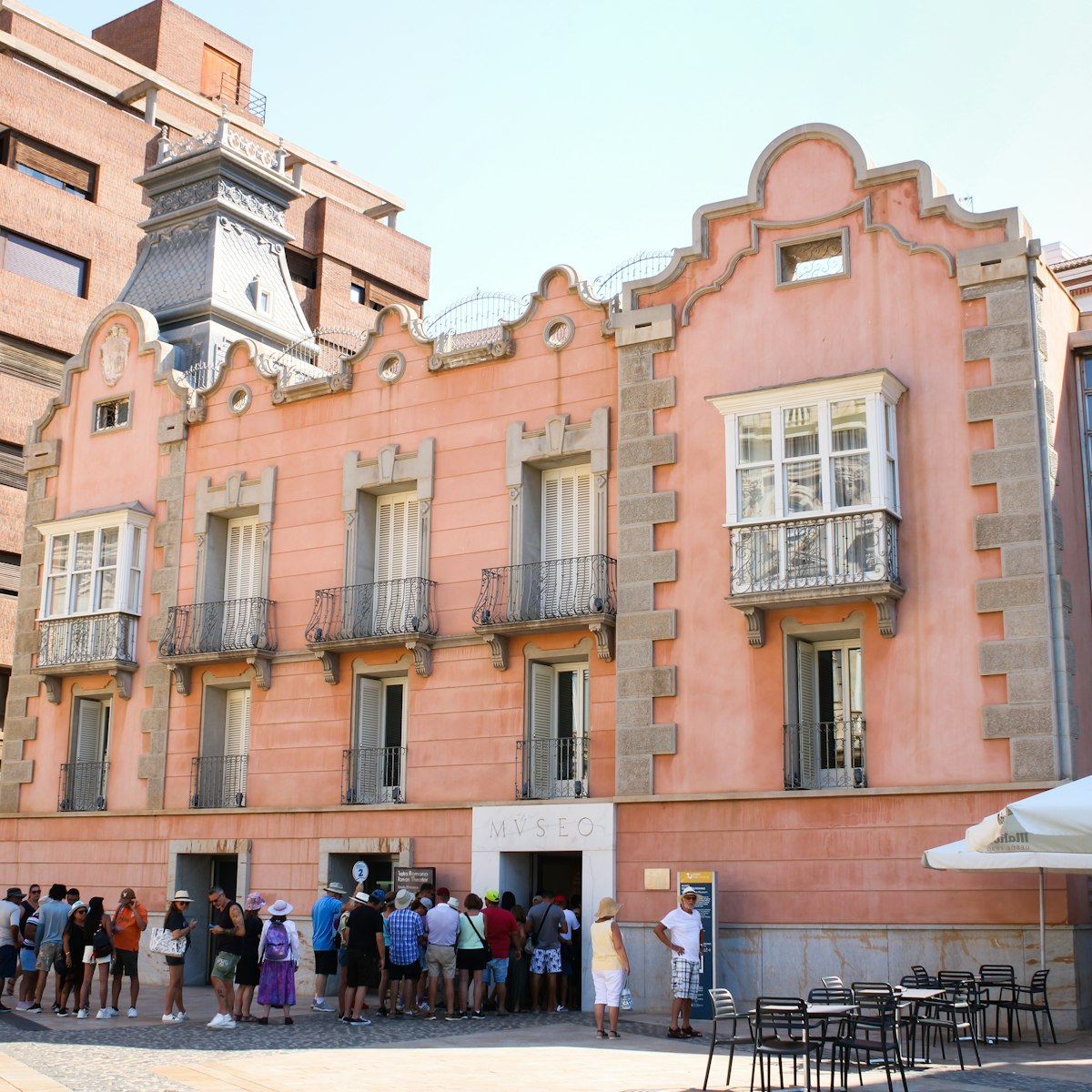
Museo del Teatro Romano
This impressive complex was designed by top Spanish architect Rafael Moneo. The tour transports visitors from the initial museum on Plaza del Ayuntamiento…
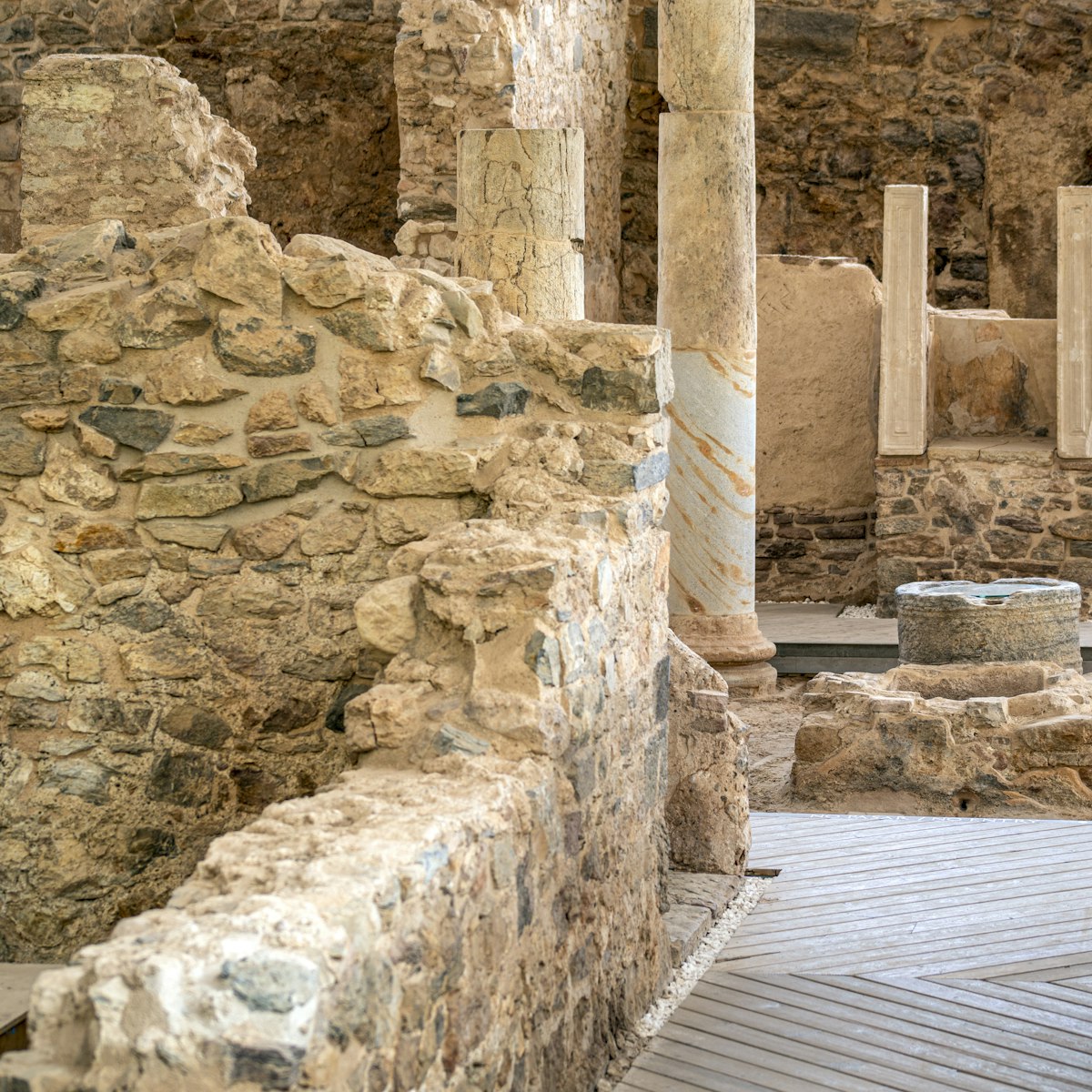
Barrio del Foro Romano
Set alongside the Molinete hill are the evocative remains of a whole town block and street linking the port with the forum, dating from the 1st century BC…
Casa de la Fortuna
The Casa de la Fortuna consists of the fascinating remains of an aristocratic Roman villa dating back to the 1st century BC, complete with some well…
Castillo de la Concepción
For a sweeping panoramic view, stride up to Castillo de la Concepción, or hop on the lift. Within the castle’s gardens, decorated by strutting peacocks,…
Museo Refugio de la Guerra Civil
Cartagena, as base of the Republican fleet and with an important arms industry, was the target of heavy bombing during the Spanish Civil War. This…
Muralla Púnica
The Muralla Púnica, built around a section of the old Punic wall, concentrates on the town’s Carthaginian and Roman legacy. It also contains the…
Museo Arqueológico Municipal
Built above a late-Roman cemetery with a rich display of Carthaginian, Roman, Visigoth and Islamic artefacts. To get here, head northwest of the city…
Parque Arqueológico Molinete
The central Molinete hill has archaeological remains ranging from the Phoenicians to Republicans in the civil war. Strolling over and around it reveals…
Palacio Consistorial
Without too many whimsical flourishes, this Modernista town hall, set back from the waterfront, imposes itself on the heart of town. Drop into the…
Casa Llagostera
The Modernista Casa Llagostera is one of several works in town by the architect Víctor Beltrí. At time of writing the facade was covered while the…
Casa Clares
Among Cartagena's Modernista buildings, the strawberries-and-cream confection of Casa Clares is particularly magnificent. It now holds a cafe and offices,…
Casa Cervantes
Cartagena is rich in Modernista buildings such as Casa Cervantes, which was designed by Víctor Beltrí in the last years of the 19th century. It's now a…
The zinc-domed Modernista Gran Hotel is particularly magnificent. Only the facade remains of this 1917 classic, but it's impressive.
Palacio Aguirre
The splendid Palacio Aguirre is now an exhibition space for modern art (known as Muram).
Lift to Castillo de la Concepción
This lift zips you up to the castle hill, with views.
More destinations you need to see
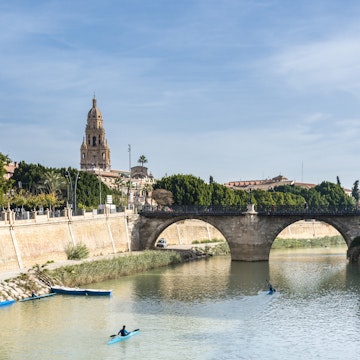
15+ Best Things To Do In Cartagena, Spain
Cartagena, the one in Spain not Colombia, is a small port city with a long and rich history. Its strategic location on the coast and closeness to the mineral reserves made the city an important hub for more than 2000 years. Over these years, Carthaginians, Romans, Arabs, and finally Spaniards, inhabited the area and each left its mark on the city. Nowadays Cartagena is full of ancient ruins, museums, and historic sites, which makes it a real paradise for history buffs.
But don’t worry if history is not your jam and you don’t feel like visiting museums. Thankfully, it’s not the only attraction city has to offer! In this post, we’ll show you many great things to do in Cartagena, Spain and you’ll choose which ones interest you most. We’re sure that among all of them, every traveler will find something for himself. Without further ado, let’s go!

Created by Sonia & Wojtek
One day, we packed our lives and slowly rushed into the unknown with smiles on our faces. We’re full-time digital nomads traveling in Europe who inspire to live, travel, and discover differently. Sunny coastal destinations are what we love most. We share travel guides, tips, and know-how to make planning your next trip a piece of cake. Real human experience and verified facts only!
This website uses affiliate links thanks to which we may earn a commission for purchases you made at no additional cost to you. If you like the content, consider using those links to support us. Thank you!
Cartagena, Spain FAQ
Cartagena is located in the Region of Murcia in Spain , on the Mediterranean coast known as Costa Calida .
Nowadays, without a doubt, Cartagena in Spain is best known for its numerous Roman ruins spread all over the city, and especially for its impressive and well-preserved Roman Theatre. Many travelers also will associate the city with Art Nouveau architecture which is filling the streets of the old town, its important naval history, and for being one of the most important harbors in Spain.
Absolutely! Cartagena is definitely a city worth visiting. In our opinion, it’s the most interesting and beautiful city in the Region of Murcia. A charming old town full of art nouveau architecture, a bustling harbor, a picturesque coastal setting, a warm Mediterranean climate, archeological sites, ancient ruins, spectacular views, and delightful cuisine – all of that really tempts you to visit and see Cartagena with your own eyes.
Cartagena is a walkable city, easy to get around on foot as most of the attractions are located close to each other within a short walking distance. Also, be aware that it’s a city with some hills and stairs to climb but it shouldn’t be a problem for those who are fairly fit and don’t have any mobility issues. In case of any problems. You can use public transport or a taxi.
Cartagena is a great destination for a one-day trip, a weekend getaway, and even a home base for longer stays to slowly discover the Region of Murcia. We started exploring Cartagena early in the morning, around 8AM, and without rushing we managed to see all we wanted in one day. But if you want to get to know the city even better we recommend staying at least for 3 days.
The best time to visit Cartagena in Spain depends on your personal preferences for things like crowds, weather, or desired activities. Summer months will be the hottest, driest, and most crowded. During the low season months temperatures will be more pleasant, there will be fewer crowds, and prices will be lower.
We can only speak for ourselves but we felt safe in Cartagena in Spain. Like in any touristic place, be cautious and take basic safety precautions, such as being aware of your surroundings and keeping an eye on your belongings, particularly in crowded areas and popular tourist spots.

Restaurants, accommodations, and map
Check out various recommended places below.
Where to eat in Cartagena?
Here are your best, high-rated options in Cartagena:
- Bodega La Fuente
- El Soldadito de Plomo
- Restaurante Techos Bajos
- Restaurante Bahía
- Delicia Tropical
- Cotton Grill
Where to sleep in Cartagena?
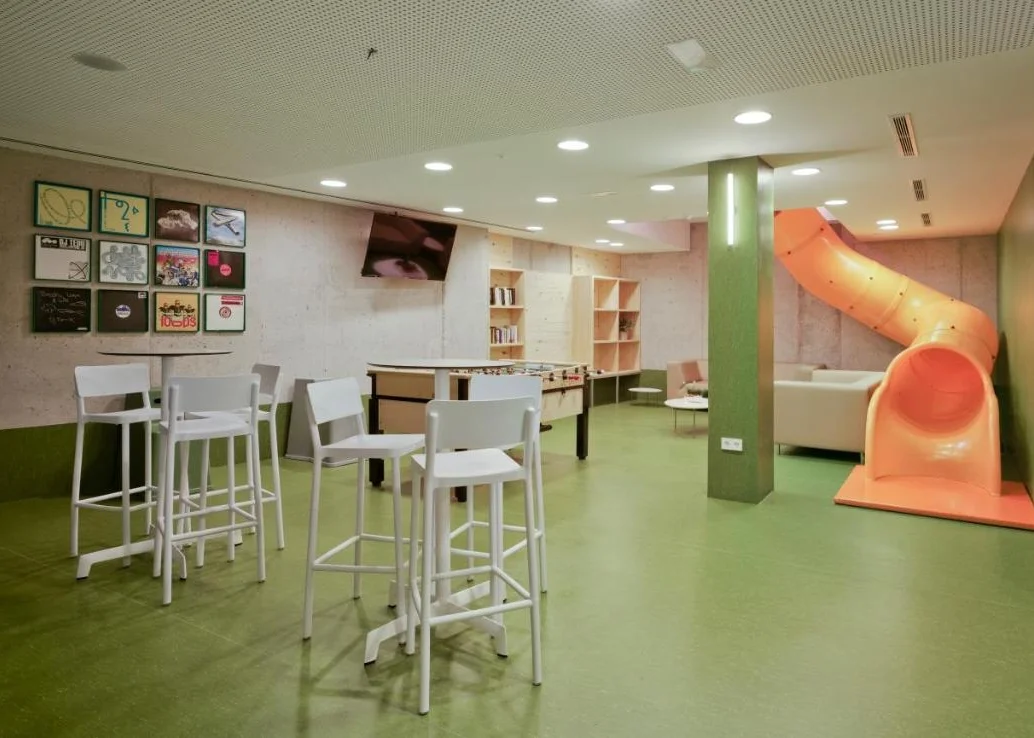
Loop Inn Hostel
Loop Inn Hostel is a vibrant and modern hostel located in the heart of Cartagena. With its lively atmosphere and friendly staff, it offers a welcoming and comfortable stay for travelers looking to explore this beautiful coastal city. The hostel provides various accommodation options, including dormitories and private rooms, as well as a communal kitchen, rooftop terrace, and common areas, making it a great choice for budget-conscious travelers and backpackers.
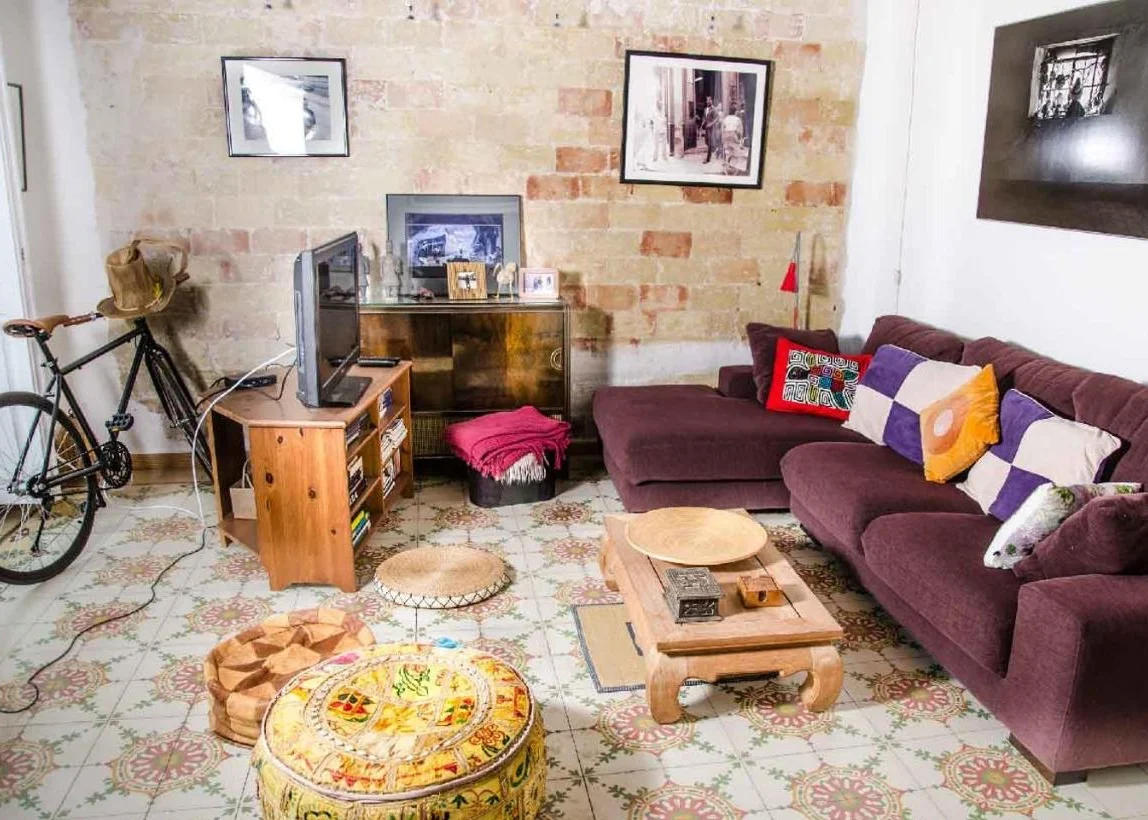
Apartamentos Turisticos Teatro Romano
Apartamentos Turisticos Teatro Romano offers a fantastic stay in Cartagena. It offers modern and spacious apartments located just a stone's throw away from the iconic Roman Theatre. The apartments are elegantly furnished and equipped with all the necessary amenities for a comfortable stay, making it a perfect choice for both short and long-term stays in the city.
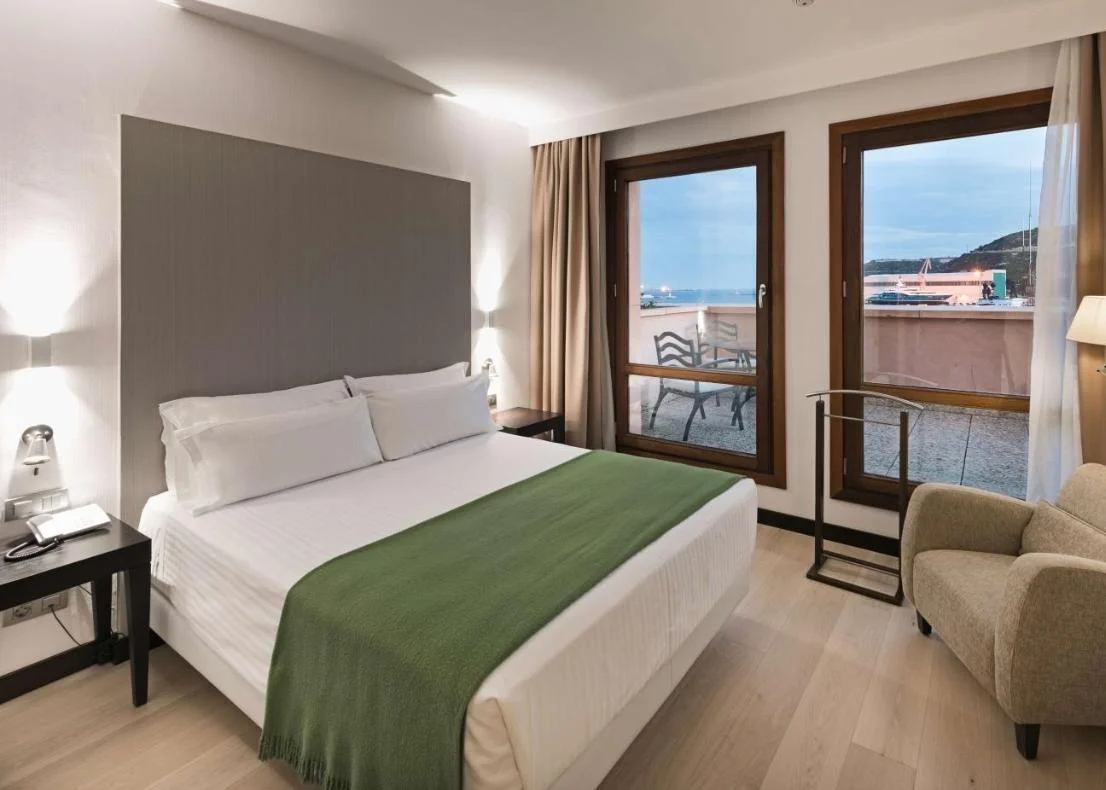
Nh Cartagena Hotel
NH Cartagena Hotel is a stylish and contemporary accommodation option conveniently situated in Cartagena. With its modern amenities, comfortable rooms, and attentive staff, the hotel offers a comfortable and enjoyable stay for both business and leisure travelers. Its strategic location provides easy access to the city's main attractions, making it an ideal base for exploring Cartagena's rich history and culture.
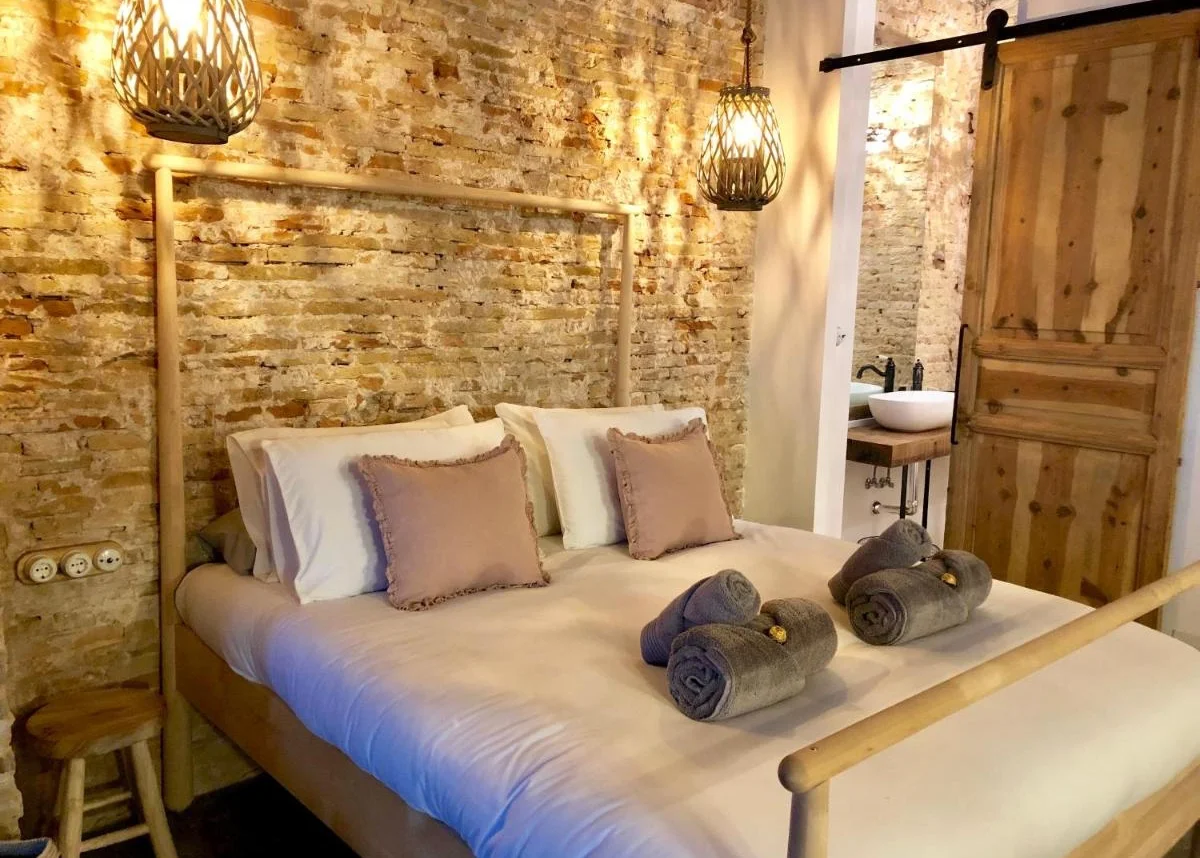
Casa Poeta Pelayo
Casa Poeta Pelayo is a charming spacious apartment with a terrace and city views, nestled in the heart of Cartagena. The property with two bedrooms, a living room, a kitchen, and two bathrooms boasts a very unique design making it a place for a very pleasant stay in the city.
Accommodations photos source: booking.com
Cartagena, Spain - Map of places
Traveling in region of murcia.
- Best Coastal Cities in Spain
- 20+ Best Beach Towns In Southern Spain
- Best Places To Visit In Region Of Murcia
- Murcia City
- Bateria de Castillitos
- La Manga del Mar Menor
Pin & share: 15+ Best Things To Do In Cartagena, Spain
Your travel resources handy in one place 🗺️, 🏨 accommodations.
For a short stay check out Booking or Agoda . Staying longer? Take a look at the offers at Airbnb .
🎫 Book tours
Are you up for taking part in epic guided tours? Book ones you like using GetYourGuide or Viator .
🚗 Rent a car
To find great rental car deals check out Rental Cars and get ready for your car trip!
✈️ Book a flight
For the hottest deals check out WayAway or Skyscanner .
🚆 Get train tickets
Love traveling by train in Europe? Book your tickets on Trainline .
🧳 Travel insurance
Enjoy peace of mind during traveling and don't leave your country without good travel insurance. SafetyWing or World Nomads are the best in class.
To stay safely connected while traveling, don’t forget about a good VPN. We recommend Surfshark or NordVPN .
🌐 Mobile internet
To stay online always and have roaming bills in check use Airalo - the world’s first eSIM store with digital data packs for over 200 countries/regions!
💰Travel finances
Get your travel finances smart and straight with Wise or Revolut .
Leave a Comment Cancel Reply
Your email address will not be published. Required fields are marked *
Save my name, email, and website in this browser for the next time I comment.
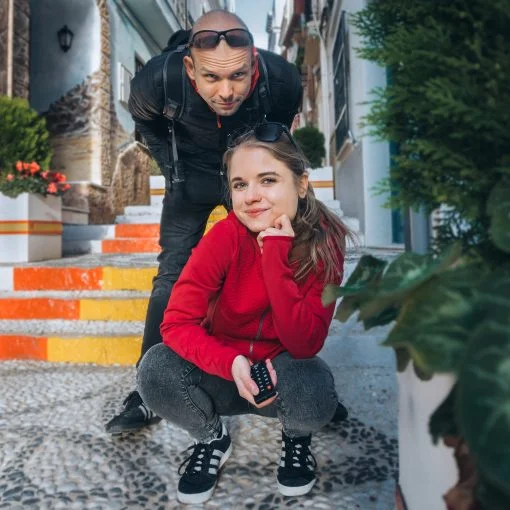
Hello Travel Seeker! Sonia & Wojtek here. One day, we packed our lives and slowly rushed into the unknown with smiles on our faces. We’re full-time digital nomads who inspire to live, travel, and discover differently. Join us and get all the answers you need to start your own journey.
Region of Murcia - TOP3

15+ Best Things To Do In Murcia City In Spain
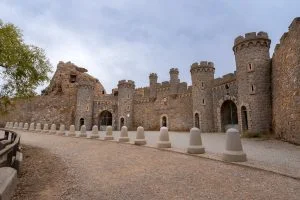
Bateria De Castillitos Cartagena, A Fairytale-Looking Fortress In Spain

Plan Your Cartagena Holiday: Best of Cartagena

Explore Cartagena
Essential cartagena.

Trending in the forums
Cartagena Is Great For
Historical tours.

Art & history

Ports of Call Tours


Sand & surf

Plan Your Trip to Cartagena: Best of Cartagena Tourism

Explore Cartagena
Essential cartagena.

Trending in the forums
Cartagena Is Great For
Historical tours.

Art & history

Ports of Call Tours

Sand & surf

- Hotel Cartagena Puerto
- Camping Naturista El Portus
- Sercotel Alfonso XIII
- B&B HOTEL Cartagena Cartagonova
- Los Habaneros
- The Curyy Corner
- El cantón Cartagena
- Marisqueria La Marina
- Luces Restaurante
- Playa de Calblanque
- Bateria de Castillitos
- Museo Del Teatro Romano
- Experiencia 43
- Cala Cortina
- Cartagena and Murcia - full day shore excursion for cruise guests
- Roman exploration in Cartagena (Spain)
- 3 Tapas Cartagena walking tour
- Luxury Rewaco Trike "The Fun In The Sun Tour" - (3 hours, Min of 2 Passengers)
- Discover two wonderful cities: Cartagena & Murcia on a private tour

Cartagena Spain
Visitor & Tourist Information

Cartagena, Spain, is located in the southeast of the country bordering on the Costa Blanca and the Costa de Azahar. Often overlooked by visitors to Spain, it is a city brimming with history, culture, and Mediterranean charm.
One of the must-see attractions in Cartagena is the Roman Theatre Museum , a remarkable archaeological site that takes you back in time to the days of the Roman Empire.
Explore the well-preserved ruins of the ancient theatre and marvel at the intricate architectural details. As you walk through the museum, you'll learn a lot about the city's rich Roman heritage.
Another fascinating historical site is the Concepcion Castle and Fortress , perched high on a hill overlooking the city. This medieval fortress offers panoramic views of Cartagena and its surroundings.
You can explore the castle's various rooms and exhibits, and imagine what life was like within its walls centuries ago. Don't miss the chance to stroll along the castle's ramparts and soak in the breathtaking vistas.
For those seeking a beach escape, head to Cala Cortina , a pristine stretch of coastline that offers tranquillity and natural beauty. If you prefer a livelier beach atmosphere, Playa de la Manga is a bustling strip of sand lined with bars, restaurants, and water sports activities.
When it comes to cuisine, Cartagena is a gastronomic delight. Indulge in the region's fresh seafood delicacies, such as the famous Caldero, a traditional rice dish with fish and spices. Don't forget to sample the local Spanish tapas , small plates bursting with flavour and showcasing the best of Spanish cuisine .
Head to the bustling Calle del Carmen, known as the "Gastronomic Street," where you'll find an array of charming restaurants and bars serving up delectable dishes.
Cartagena's vibrant city center is a hub of activity, with its picturesque squares, lively plazas, and bustling markets. Explore the pedestrian-friendly streets, browse the shops for unique souvenirs, and soak up the lively atmosphere.
Don't miss a visit to the fascinating Military Museum and Artillery Park, a green oasis in the heart of the city, where you can relax amidst lush gardens and admire ancient cannons.
As you wander through Cartagena's charming streets, you'll encounter architectural gems like the City Hall and the iconic Modernist Casino. These buildings reflect the city's rich architectural heritage and offer glimpses into its past.
Best Things To Do In Cartagena
Roman Theatre Museum :
Explore the well-preserved ruins of an ancient Roman theatre and learn about Cartagena's rich Roman history.
Concepcion Castle:
Visit this medieval fortress for panoramic views of the city and immerse yourself in its fascinating history.
Playa de Calblanque:
Relax on this pristine beach with crystal-clear waters and stunning natural beauty.
Playa de la Manga:
Enjoy a lively beach atmosphere with water sports activities, bars, and restaurants.
Calle del Carmen:
Discover this gastronomic Street, lined with charming restaurants and bars serving delicious local cuisine.
Admire the beautiful architecture of this historic building located in the city center on a guided tour of the city .
Artillery Park:
Relax in this green oasis amidst lush gardens and ancient cannons.
Modernist Casino:
Marvel at the intricate design and architecture of this iconic building.
Guided Walking Tour:
Take a guided walking tour to get to know the local gastronomy of Cartagena. Taste some delicious local tapas and drinks, and visit the city's ancient Roman Theater as part of your tour.
Bateria de Castillitos:
Visit this coastal fortress for panoramic views of the Mediterranean Sea.
Cartagena Naval Museum:
Learn about the city's maritime history through fascinating exhibits and artefacts.
Cartagena Cathedral:
Admire the grandeur of this impressive cathedral, a blend of Gothic, Baroque, and Neoclassical styles.
Augusteum Roman Forum:
Explore the remains of a Roman forum and discover the city's ancient past.
Museum of Underwater Archaeology:
Dive into the fascinating world of underwater archaeology and discover sunken treasures.
Port of Cartagena:
Take a stroll along the bustling harbour, lined with restaurants, bars, and shops.
Cartagena City Walls:
Walk along the historic city walls and enjoy panoramic views of the city and the sea.
Castillo de la Atalaya: Climb to the top of this hilltop castle for breathtaking views of Cartagena.
Punic Walls:
Discover the ancient Punic defence walls and learn about Cartagena's Carthaginian heritage.
El Faro de Cartagena:
Visit the lighthouse for stunning views of the coastline and the city.
Calle Mayor:
Wander through the charming streets of the old town, lined with shops, cafes, and historic buildings.
Santa Maria de Gracia Church:
Admire the beautiful architecture and artwork of this historic church.
The Roman Theatre Cartagena

One of the most iconic places of interest to visit in Cartagena is the Roman Theatre, which is a remarkable archaeological site that provides a glimpse into the city's rich history.
Located in the heart of Cartagena's historic centre, the theatre stands as a testament to the Roman influence in the region.
It is a well-preserved structure that dates back to the 1st century BC and was rediscovered in the late 1980s. Since then, it has become one of the most significant attractions in Cartagena, drawing history enthusiasts and curious visitors alike.
The Roman Theatre offers you a fascinating insight into the architectural marvels of the Roman Empire. Its impressive size and intricate design showcase the grandeur of Roman construction techniques.
Here you can marvel at the well-preserved semicircular seating area, the stage, and the stunning backdrop that once provided a backdrop for performances.
The theatre also houses an informative museum that provides further context and historical details about the site. The museum displays various artefacts and objects found during archaeological excavations, giving visitors a deeper understanding of the theatre’s significance in the Roman era.
The site is open to the public, but the opening hours may vary depending on the time of year, so it is advisable to check the official website or inquire locally for the most up-to-date information.
Guided tours are available , providing insightful commentary and enriching the visit with historical anecdotes.
The Consistorial Palace

The Consistorial Palace is another stunning landmark in Cartagena. Located in the heart of the city, this magnificent building serves as the seat of the local government and stands as a symbol of historic cultural heritage.
The Consistorial Palace is a striking example of neoclassical architecture, with its grand façade and imposing presence. The building's design reflects the influence of various architectural styles, including baroque and neoclassical elements, which add to its unique charm.
Constructed in the 19th century, the Consistorial Palace has been meticulously preserved, showcasing its architectural splendour. The ornate details, such as the intricate carvings, elegant balconies, and grand staircase, exemplify the craftsmanship of the era. The interior of the palace is equally impressive, featuring beautifully decorated halls, grand meeting rooms, and historical artefacts.
You can visit the exterior of the Consistorial Palace which lets you admire the grandeur of the building. The central location of the palace makes it easily accessible for visitors to appreciate its architectural beauty and take photographs. While the interior is not open to the public, the exterior alone is worth a visit.
Historic Gun Batteries

Cartagena has a fascinating military history, and one of the attractions that showcase this heritage is the gun battery placements.
Scattered throughout the city, these historical sites offer visitors a glimpse into the strategic defence systems that once protected the harbour and the city from potential threats.
The gun battery placements in Cartagena are remnants of the city's fortified past, where cannons and artillery were strategically positioned to safeguard the coastline.
These sites played a crucial role in defending the city and its valuable naval port, highlighting the military prowess of the region.
Notable gun battery placements in Cartagena include the Batteries of Castillitos and the Batteries of Cenizas.
The Batteries of Castillitos , located on a hilltop overlooking the Mediterranean Sea, offer panoramic views of the surrounding landscape and provide an immersive experience of the coastal defence system.
The Batteries of Cenizas, situated on a stunning cliffside, offer a glimpse into the military history of the region and offer breathtaking views of the sea.
Cartagena Port & Marina

The historic port of Cartagena is a captivating destination that beautifully blends its rich maritime history with modern amenities. This ancient port city boasts a strategic location that has attracted seafarers and merchants for centuries.
Cartagena's historic port showcases a fascinating collection of ancient ruins, including Roman and Carthaginian remains.
Here, you can explore the impressive Roman Theatre, which dates back to the 1st century BC and was discovered in the 1980s. The theatre's grand amphitheatre-like structure stands as a testament to the city's ancient past.
In addition to its historical significance, the port of Cartagena also features a bustling marina that offers a vibrant atmosphere for both locals and visitors.
The marina is home to a wide range of yachts and sailboats, creating a picturesque scene against the backdrop of the city's historic architecture.
Strolling along the marina promenade, you'll find a multitude of charming cafes, restaurants, and shops where you can relax and enjoy the maritime ambience.
The marina is not only a place to admire beautiful vessels; it also serves as a gateway to various maritime activities.
Here you can enjoy boat tours to explore the stunning coastline, embark on fishing trips, or even charter a yacht for a luxurious sailing experience.
The marina is also a hub for water sports enthusiasts, offering opportunities for jet skiing, kayaking, and paddleboarding.
Whether you're interested in delving into Cartagena's maritime past or simply soaking up the vibrant atmosphere of the marina, the historic port of Cartagena provides an enchanting experience that combines history, culture, and a love for the sea.
Best Beaches in Cartagena

Whether you're seeking relaxation, water sports, or simply a day under the sun, here are some of the best beaches in Cartagena and its surroundings:
Cala Cortina:
Located near the city center, Cala Cortina is a picturesque beach with calm waters, making it perfect for families with children. It offers fantastic views of the port and the iconic Castle of San Julián.
Situated within the Calblanque Natural Park, this unspoiled beach is renowned for its untouched beauty. With its pristine coastline, dunes, and crystal-clear waters, it's an ideal spot for nature lovers and those seeking a tranquil escape.
Playa de Cala Reona:
This small, hidden gem is nestled within the stunning landscape of Cabo de Palos. Surrounded by cliffs, it offers a secluded and peaceful atmosphere, making it a favourite among locals and snorkelling enthusiasts.
Playa de Levante:
Located in La Manga, a narrow strip of land that separates the Mediterranean Sea from the Mar Menor lagoon, Playa de Levante boasts a vibrant atmosphere and a range of water sports activities. It's an excellent choice for those seeking excitement and a lively beach scene.
Playa de la Almadraba:
Situated near the charming village of Portman, this beach is renowned for its rugged beauty and clear blue waters. It's a popular spot for snorkelling and diving due to its abundant marine life.
Playa de Cala del Pino:
Tucked away within the Calblanque Natural Park, this secluded beach offers a serene setting and pristine waters. Surrounded by cliffs and pine forests, it provides a picturesque backdrop for a relaxing day by the sea.
Best Festivals Held In Cartagena

Carnival of Cartagena (February/March):
This colourful and lively carnival takes place in the weeks leading up to Lent. It features parades, music, dancing, and elaborate costumes, creating a festive atmosphere throughout the city.
Holy Week (Semana Santa) (March/April):
Like many other Spanish cities, Cartagena commemorates Holy Week with solemn processions and religious events. The streets come alive with religious statues, music, and the scent of incense as the city honours its religious heritage.
Carthaginians and Romans Festival (September):
This week-long festival reenacts the historical conflict between the Carthaginians and Romans. Locals dress up in elaborate costumes, stage battles, and recreate historical events, providing a unique glimpse into the city's ancient past.
Cartagena Jazz Festival (November):
Music enthusiasts flock to Cartagena for this renowned jazz festival, which attracts both national and international jazz artists. Concerts, jam sessions, and workshops take place in various venues across the city, delighting jazz lovers of all ages.
Virgen de la Caridad Festival (September):
This religious festival celebrates the patron saint of Cartagena, the Virgen de la Caridad. Processions, religious ceremonies, and fireworks honour the revered figure, bringing together the community in a display of faith and devotion.
The Gastronomy of Cartagena

The cuisine of Cartagena, Spain, and the surrounding region of Murcia is a delightful blend of Mediterranean flavours and local ingredients. Known for its fresh seafood, aromatic spices, and vibrant produce, the gastronomy of this area is a true treat for food enthusiasts.
One popular local dish in Cartagena is "Caldero del Mar Menor," a rice dish similar to paella but with a distinct regional twist. It is prepared using fish from the Mar Menor lagoon, which infuses the dish with unique flavours. Another must-try is "Zarangollo," a traditional Murcian dish made with scrambled eggs, courgettes, onions, and olive oil. It offers a simple yet delicious taste of the local cuisine.
Typical Dishes from Cartagena & Murcia
"Caldero del Mar Menor": This iconic dish is a rice-based stew made with fish from the Mar Menor lagoon, such as grouper or sea bass. The rice is cooked in a rich fish broth infused with saffron and served with a side of "alioli" (garlic mayonnaise).
"Pastel de Cierva": This savoury pie is a local speciality made with puff pastry, tender pork meat, and aromatic spices. It is often enjoyed as a snack or appetizer.
"Migas Cartageneras": This traditional dish consists of fried breadcrumbs combined with garlic, peppers, chorizo, and other ingredients. It is a hearty and flavorful option, often enjoyed as a main course.
"Tortilla Cartagenera": A local variation of the classic Spanish omelette, this version includes additional ingredients such as peppers, onions, and sometimes even seafood. It is a popular choice for a light meal or tapas.
"Habas con Jamón": This dish features fresh broad beans sautéed with cured ham, garlic, and olive oil. It is a simple yet delicious combination that highlights the flavors of the ingredients.
When it comes to authentic local dining experiences, here are three recommended restaurants in Cartagena:
Restaurante El Batel:
Situated by the harbour, this waterfront restaurant combines stunning views with exquisite cuisine. They are known for their fresh seafood dishes, including grilled fish and seafood paella, all prepared with top-quality ingredients.
Webiste: auditorioelbatel.es/
Restaurante El Churra:
While not located in Cartagena itself, this restaurant in nearby Murcia is worth a visit for its exceptional regional cuisine. They focus on traditional Murcian recipes, such as "Michirones" (a hearty bean stew) and "Paparajotes" (lemon tree leaves coated in batter and fried).
Website: elchurrarestaurante.com
These restaurants showcase the flavours of Cartagena and the Murcia region, providing a genuine taste of the local culinary heritage. Whether you're a seafood lover or eager to try traditional Murcian dishes, these establishments are sure to satisfy your palate and leave you with a memorable dining experience.
Recommended Places To Stay In Cartagena
The Hotel Cartagonova , centrally located in the heart of the city, provides a perfect blend of modern amenities and historic charm.
For those seeking a luxurious experience, Hotel Cartagena Puerto boasts stunning views of the Mediterranean, offering a refined atmosphere and impeccable service.
If boutique charm is what you desire, Hotel Los Habaneros is an excellent choice, combining personalized attention with stylish decor.
Live Weather Update
Disclosure: Please note that some of the links included in the above content may be affiliate links. We may earn a commission if you make a purchase at no extra cost to you. Rest assured, we only recommend products and services that we personally use or have used and are happy to recommend. Any commission we earn helps toward the site's running costs.

Travel Smarter - Not Harder
Download free e-guides and travel tips.
Start your Journey today and get access to exclusive FREE content.
Username or Email Address
Remember Me
- WHY VISIT SPAIN?
- TRAVELLING TO SPAIN
- SPAIN ON A BUDGET
- TRAVEL REQUIREMENTS – ETIAS
- SPAIN ENTRY REQUIREMENTS
- SPANISH CUISINE
- SPANISH FOOD
- HOLIDAY IDEAS
- PUBLIC HOLIDAYS
- TOURISM BOARDS
- AIRPORT GUIDE
- DRIVING IN SPAIN
- WEATHER IN SPAIN
- FREE WEB CAMS
- BEST BEACHES SPAIN
- FESTIVALS & FIESTAS
- MUSEUMS IN SPAIN
- CAMPING IN SPAIN
- MARINAS IN SPAIN
- SKIING IN SPAIN
- WATER PARKS
- UNESCO WORLD HERITAGE SITES
- 80 BEST ATTRACTIONS
- 71 BEST PLACES TO VISIT
- REGIONS OF SPAIN
- COSTA DEL SOL
- CANARY ISLANDS
- SAN SEBASTIAN
- Complete List:
- SAGRADA FAMILIA BARCELONA
- BARCELONA FC STADIUM TOUR
- BARCELONA FLAMENCO SHOW
- SEVILLE FLAMENCO SHOW
- SEVILLE CATHEDRAL
- GAUDI`S CASA BATLLO
- THE ALHAMBRA GRANADA
- SANTIAGO CATHEDRAL
- CITY OF ARTS & SCIENCE VALENCIA
- MOSQUE-CATHEDRAL CORDOBA
- CAMINITO DEL REY
- PRADO MUSEUM MADRID
- REINA SOFIA ART MUSEUM
- SCUBA DIVING
- BEST TAPAS TOURS
- BEST WINE TASTING TOURS
- TOUR GUIDES
- HOTELS IN SPAIN
- LUXURY HOTELS
- LUXURY BEACH HOTELS
- HOLIDAY RENTALS
- PARADOR HOTELS
- CHEAP FLIGHTS
- TRAVEL INSURANCE
- FREE TRAVEL BROCHURES
- WIN FREE HOLIDAYS

- Skip to main content
- Skip to secondary menu
- Skip to primary sidebar
- Skip to footer

SpainMadeSimple.com
Cartagena Tourist Information Guide: Things to Do & See
Table of Contents
Cartagena is an important port and city located in the province of Murcia on the Mediterranean coastline in Southern Spain.
In common with many towns in this area of Spain, Cartagena is split in two – the historic town inland with the sights of Veles Castle, La Purisma convent and San Andres Church (famous for its fine Mudejar ceiling) and Puerta del Cartagena on the coast,
Cartagena dates back to approximately 227BC and was founded by the Phoenicians with the Moors and Romans also having a great influence over the city.
The port was also known as Carthago Nova the new Carthage, such was the importance of the port to the Phoenicians.
Puerta de Cartagena (the port area) has a marina with berths for 200 boats. Tourists will enjoy walking along the promenade which has many fantastic restaurants, bars and cafes. This area is crucial to the economy as it is very much still a working area with the fishing boats bring in their fresh catches daily, unlike many resorts in this area which now no longer fish but rely on tourism instead.
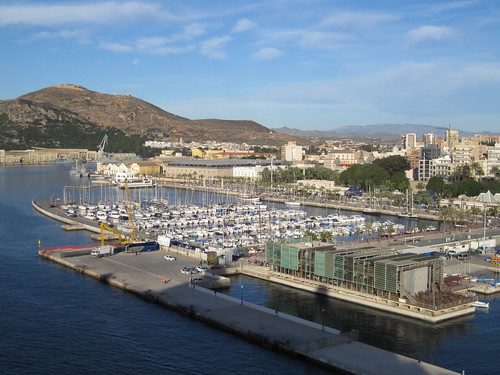
Getting To Cartagena
Cartagena is located on the Costa Calida in south-east Spain and is surrounded by the mountain ranges of the Sierra de Almenara and Sierra de Algarrobo.
Cartagena has a long history with the Phoenician, Roman and Moorish civilisations all passing through. Most were attracted here because of the abundance of natural minerals, including lead and iron ore, which can be found in the area.
Cartagena has two airports in its vicinity which are Alicante and Murcia airports of which Murcia Airport is the closest. Residents and tourists are eagerly awaiting the opening of a third airport which is La Covera Airport which will bring even more tourists to the Costa Calida with its golf courses, beaches and theme parks, (Paramount Pictures is due to open in 2015)
Sights and Attractions
Today Cartagena is one of the most important military naval bases in Spain together with Ferrol in the north and has been the capital of the Spanish Maritime Department of the Mediterranean since the Spanish Bourbon dynasty ascended the throne in the 18th century. Cartagena as a naval port has been most important to the country as early as the 16th century.
Because Cartagena was strategically important a number of civilizations have made their presence felt as can be seen from its heritage with landmarks such as the Roman Theatre which is the second largest on the Iberian Peninsula as well as substantial remains dating back to the Phoenicians, Roman, Byzantine and Moorish eras.
Because of its cultural diversity, Cartagena is on the tourist map when it comes to cruise holidays as well.
Cartagena is guarded by two fortresses and one of the must things to do in Cartagena is visit the Castilla de la Concepcion. If you are looking to book a Mediterranean cruise which has Cartagena as a port of call there are four excursions on offer which are Cartagena Port of Cultures, Elche and the Botanical Gardens, Magical Murcia and a Cartagena Bike Tour. These optional excursions start from as little as €40 per person.
Here is a video tour guide of Cartagena:
Accommodation – Where To Stay
Accommodation wise Cartagena has a whole host of hotel rooms to book from as little as €38 a night and the most popular of these include the Carlos III Sercotel, NH Campo Cartagena, Best Western Hotel Alfonso XIII, Los Habeneros and the Posadas de Espana Cartagena.
Best Bars – Nightlife
A Cartagena nightlife experience can best be enjoyed in the bars and clubs where tourists mingle with locals and dance the night away.
Popular Cartagena bars and nightclubs include Stereo, Cayote and Tris Tras.
Cartagena also has some fine restaurants which includes Los Churrascos, Mari Zapata, Mare Nostrum, Techosbajos and Tasca del Tio Andres.
Excursions/Days Out
Cartagena is less than twenty minutes away by car from the La Manga Strip , Mar Menor with its beaches and the famous La Manga Golf Course.
Head for the protected area known as the Sierra Espuna natural park, an area of ouytsanding natural beauty which is a great spot for walking and enjoying the outdoors.
If you have visited Cartagena because of its attraction as a city of museums and historic landmarks then you would also enjoy the town of Lorca which is famous for textiles and ceramics.
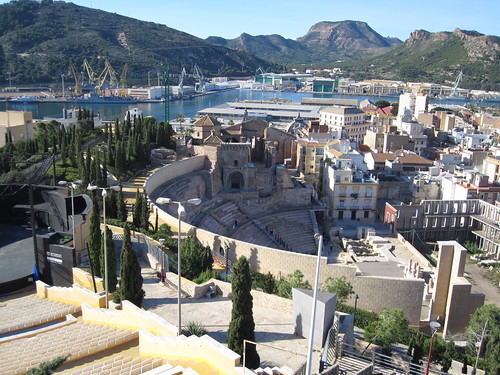
Cartagena has a some great beaches within easy reach which includes the Cala Cortina, Islas Menores, El Galua Beach and La Gola beach.
There are about 35km of coastline featuring many fantastic sandy beaches and small coves for a spot of privacy. If you are looking for the best beaches for nude sun bathing or naturalists Percheles and Los Lobos.
Some of the best beaches are Playa del Casteller, Playa de Bahia and Playa de Nares.
Make sure you head west to the small fishing village of Bolnuevo, famous for the amazing natural rock formations.
Cartagena is well-known for it’s celebrations. The best ones to look out for include:
In mid-March Puerta del Cartagena celebrates the patron saint San Jose. This involves the burning of a giant falla (statue) on the beach ending with the usual spectacular firework display.
In the summer months of July and August there are many events such as concerts and celebrations.
Real Estate Agents
Whether you’re looking for a place to rent or to stay at permanently, you can take advantage of the services from the real estate agents in Cartagena who are more than willing to help you in finding your ideal residence.
You can contact Chersun Properties ( www.chersun.com , Tel. +34 610 914 850) and Elysium Properties ( www.elysiumproperties.com , Tel. +34 968 175 957).
Cartagena Tourist Information Office
Cartagena Tourist Office Address: Calle San Diego 25, 30201, Cartagena (Murcia) Telephone Number: +34 968 128 955 Email Address: [email protected] Website: www.cartagenaturismo.es
Cartagena Tourist Office Address: Palacio Consistorial, Plaza del Ayuntamiento s/n, 30201, Cartagena (Murcia) Telephone Number +34 968 128 955 Opening Hours: Monday-Friday 10:00-14:00 and 16:00-18:00. Saturdays 10:00-13:00.
Related Cartagena Pages…
Cartagena Weather
Towns in the Cartagena Region…
- Costa Calida
About the Author

Mark Eastwood
Main author and owner of SpainMadeSimple.com which was started in 2004 when I first moved to Spain.
Spain Made Simple features expert advice on all aspects of moving to and living in Spain as well as useful tourist information and travel tips.
As well as my own articles we have many contributions from professionally qualified experts in varied occupations in Spain.
Thank you for visiting our website and if you would like to comment or contribute, we welcome this! Just type your message in the comments box at the bottom of the page.
Reader Interactions
Robert Esposito says
December 7, 2023 at 9:06 pm
Will be there on Dec. 24th and 25. at the Grand Hyatt. Are there any good quality vegetarian restaurants open in the center on Christmas Eve?
Leave a Reply Cancel reply
Your email address will not be published. Required fields are marked *
Official Pages
- Privacy Policy
- Terms & Conditions
- Cookie Policy (EU)

9 Things To Do In Cartagena, Spain: A One Day Itinerary
Last Updated on February 20, 2024
by Michael Rozenblit
Disclaimer: This article contains affiliate links. That means if you click a link and make a purchase, we may make a small commission. As an Amazon Associate we earn from qualifying purchases. For more information, see our privacy policy.
When researching about the best things to do in Cartagena, Spain, I was constantly directed to articles about the eponymous city in Colombia. Cartagena is one of the most popular cities to visit in Colombia, while its namesake in Spain tends to often be overlooked by foreign tourism except for some cruise ships that stop here during the summer months.
This is a great shame as Cartagena has a lot to offer travellers; from ancient Roman history, a bustling city centre and pier and unique cuisine that offers you the chance to try dishes not found in more-travelled regions such as Andalucía , Catalonia or Madrid .
This article outlines how we recommend spending one day in Cartagena as well as some tips if you have a longer stay in the city.
Table of Contents
Getting To & Around Cartagena
While the majority of foreign visitors that make it to Cartagena arrive via a cruise ship, it’s incredibly easy to visit this city as part of a longer trip throughout Spain.
There are a few direct buses daily from Granada and Valencia making it a logical stop if you’re travelling between Andalucía and Catalonia or Valencia. It also makes for a logical day trip if staying in nearby resort towns such as Alicante .
If you have the flexibility of renting a car while in Spain (we recommend using Rentalcars.com to compare prices!) then a stop in Cartagena can be added onto a longer trip in the region of Murcia and along the Eastern Coast of Spain.
Once in Cartagena, the centre of the city is easy to get around and navigate on foot and you can easily get to all of these things to do without using public transport.
If you want to explore with the help of a knowledgeable local guide, then this guided walking tour of the city is a good option. And foodies will love this gourmet tapas tour of Cartagena.

9 Best Things To Do In Cartagena
Mercado de santa florentina.
One of the best ways to start your time in Cartagena is to head to the local Mercado de Santa Florentina . Open every day except Sunday from 8am to 3pm, this market has a range of typical fresh produce including fruits and vegetables, olives, cheeses, fish and meats.
Apart from picking up a few snacks for your day of exploring Cartagena, this is also a great place to enjoy a coffee and light breakfast.

Stroll down Calle Mayor
From the Mercado de Santa Florentina, head into the centre of the city by taking a stroll along the main pedestrian street in the old town of Cartagena – Calle Mayor.
Calle Mayor is a bustling place during the morning hours and once again in the evening, making it a great place to people-watch and appreciate the Art Nouveau architecture (and if you really want to appreciate the architecture, don’t miss the gorgeous town hall, either).
If you didn’t manage to fit in your caffeine fix at the market or simply need another one, then Calle Mayor is also a great place to enjoy a coffee and people-watch.
Kuss Cartagena became our go-to coffee place each morning during our time in the city and has an incredibly appealing selection of cakes and baked goods to accompany any hot drink!

Teatro Romano de Cartagena
One of the most historically important things to do in Cartagena is to visit the Roman Theatre. While you can get decent views of the Roman Theatre from various parts of Cartagena, it’s definitely worth paying to visit to learn more about the history of this site and be able to explore it properly.
The Roman Theatre was only rediscovered a few decades ago with excavation beginning in 1988 and completed in 2003 but it is now a top attraction in the city.
A visit to the Roman Theatre begins with a short film that alternates between Spanish and English which shows the history of the site and how it would have originally looked.
Visitors are then guided through a small museum that houses artefacts found during the excavation and an archaeological corridor that guides you finally to the theatre itself.
The Roman Theatre is open daily except for Mondays and with reduced hours on Sunday. Standard entry is €6 with discounts available for students and seniors. You can buy skip-the-line tickets here or purchase a combined ticket if you plan to enter other Roman ruins in the city.

Cartagena Port
From the Roman Theatre, keep heading south along Calle Mayor until you reach the Port of Cartagena. On a sunny day, this is a great place to enjoy a short stroll along the seaside or take a boat tour to see some of the historical sites around the city’s port.
The Tourist Boat leaves approximately every hour with reduced services during the low season. The ride lasts 40 minutes and takes you past several important historical sites including castles, forts, naval docks and lighthouses while also allowing you to enjoy nice views of Cartagena.
There is commentary in both Spanish and English so you understand the significance of what you are seeing and learn about the Carthaginian history and Punic War here.
Tickets cost €6 or €8 if you also want to get off the boat and visit one of the forts. During busier periods you might not be able to buy a ticket last minute so it can be worth coming to the ticket office before visiting the Roman Theatre to ensure you secure a spot for later in the day.

Calle Jara for Lunch
After an active morning, it’s time to head back up Calle Mayor and turn right down Calle Jara. On this street, you will find a few fantastic tapas bars conveniently located right next to each other.
Two of these bars, La Uva Jumillana and Bodega La Fuente are owned by the same people and actually have the other’s menus on the back of their own. Both these restaurants require you to order and pay at the bar and give you the food on a tray to take to your table inside or outside.
Bodega La Fuente is known for its fish dishes and is a great place to try a variety of toastas (flatbread) and montaditos (little sandwiches) with anchovies. A local speciality to try is marinera which is a crispy breadstick topped with Russian salad and an anchovy.
La Uva Jumilliana has a wider range of dishes with its specialities including a fantastic version of patatas bravas (fried potatoes with spicy paprika sauce), pollo kentucky (fried chicken) and caldero (traditional seafood rice which acts as Cartagena’s version of paella) which is only available on Sundays and public holidays.

Next, to these bars, you will find La Bodeguilla which is another great option for lunch. They have an extensive wine list and have table service unlike the other two places listed here. You can also order from a long list of tapas or go for one of their larger typical Spanish dishes.
You can easily hop between these three places for lunch or simply pick your favourite and enjoy your time there. If you’re anything like us, chances are you’ll be returning to one of these places later in the day for dinner or the following day if you happen to have more than one day in Cartagena.
Street Art & Roman Forum
After lunch, it’s time to take a stroll through some of the side streets to enjoy the impressive range of street art that Cartegena has to offer. There isn’t necessarily a specific district to see street art but we kept getting pleasantly surprised as we walked down random alleyways away from the main pedestrian streets.
Some of the largest murals can be found opposite the Roman Forum (Cerro del Molinete Archeological Park) which is worth a visit in its own right. It is one of the largest archaeological sites in Spain and allows you to transport yourself back to Roman times as you walk through the preserved section of the city.
The Roman Forum is open daily in high season and from Tuesday to Sunday for the rest of the year. The entry fee is €6 and there is also reduced prices for students and seniors.

Café Asiatico or Churros
If you need a moment of relaxation after a busy day of sightseeing, enjoy a local speciality coffee drink known as Café Asiatico. Sharing some similarities to Vietnamese coffee, this drink can only be found in Cartagena and surrounding towns.
It consists of a coffee, condensed milk, cognac and is topped with a local liquor known as Licor 43. Many cafes serve it along the main pedestrian streets of Cartagena.
If a Café Asiatico doesn’t sound quite up your alley, then another option is to head to Churreria Tofi for some churros can chocolate. This local favourite is located just north of the main city centre and serves traditional churros con chocolate as well as porras (thicker churros) on the weekends.
You can choose to get them to take away or sit in the undercover seating section.

Sunset at Castillo de la Concepción
One of the best things to do in Cartagena in the evening is to climb up to Castillo de la Concepción which offers one of the best viewpoints in the city.
Travellers can either take the approximate 20-minute uphill walk up or if you’re tired after a day of sightseeing, you can choose to go up on the panoramic lift instead ( purchase tickets here ).
From this viewpoint, you can get amazing views of the sun setting behind the mountains as well as panoramic views of all of Cartagena including the Roman Theatre and the sea.
The panoramic lift shuts down at 7 m however it’s a fairly straightforward 10-15 minute walk down from the viewpoint back into the city centre if you want to stay up at the viewpoint for longer. Make sure to keep an eye out for the peacocks that reside up here as well!

Evening Tapa
There’s no better way to end your day in Cartagena than to enjoy a final tapa or two in the city. One option is to head back to any of the places listed in this article for lunch, in case you didn’t make it all of them earlier in the day!
Another option is to head down along Calle Mayor which has plenty of places to eat and to enjoy the atmosphere of the bustling Spanish city.

Have More Than One Day in Cartagena?
This Cartagena itinerary undoubtedly packs a lot into the single day, so if you have the luxury of spending more time in the city, then you can easily stretch out some of these things to do across several days.
There are a few museums to visit in Cartagena that can be worth checking out, such as the Casa de la Fortuna, the Cartagena Naval Museum, the Spanish Civil War Museum and more. You could also visit some more ancient ruins, such as the Punic Wall.
There are also some fantastic beaches near Cartagena that are the perfect place to enjoy the sun. Cala Cortina is located 4km from the city centre and has a small beach suitable for swimming as well as some nearby restaurants.
If you have rented a car , then there are some other beaches located about 20 to 30 kilometres outside of the city centre that also make for an enjoyable day out.
Where to Stay in Cartagena
B&B Hotel Cartagena Cartagonova – A four-star hotel located in the centre of the city, offering a range of private rooms including single rooms. Rooms are modern and comfortable and there is the option to include a buffet breakfast in the daily rate.
Hotel Los Habaneros – A fantastic budget hotel that is located close to the port and the bus and train stations. Rooms are clean and spacious with options available for solo travellers, couples and families.
Not quite what you’re looking for? Click here to browse other hotels in Cartagena!

There are many fantastic things to do in Cartagena, Spain that deserve to put the city on travellers’ radars when visiting Southern Spain.
Are you visiting Cartagena? Have any questions about this itinerary?? Let us know in the comments!

Related Posts:

Marbella or Malaga: Which Spanish City to Visit?

Segovia vs Toledo: Choosing a Madrid Day Trip

How to Plan a Montserrat Day Trip from Barcelona

About Michael Rozenblit
Michael is a co-founder and writer for The World Was Here First. Both solo and with his partner, Maggie, he has travelled to over 50 countries across the globe and has a particular affinity for the Balkans and Eastern Europe. He’s lived in numerous countries worldwide but currently resides in his hometown of Melbourne, Australia. Read more about Michael
Great ideas! I lived here as a child in the 60s..returned in 2009..but have heard the city is even more beautiful now..Thanks for all your wonderful suggestions..
It’s definitely a lovely city Barbara – hope you have a great time visiting again!
Hi Michael how lucky am I to have across you Love your blog hubby and I are sailing the Mediterranean we picked up our catamaran in La Rochelle in May and we are currently sailing the Spanish coast line heading to Cartagena Thank you for your insights maybe you could consider marinas and anchorages for us sailors and there’s a lot of us Cheers Desi ? check us out on sailing Solis for a laugh
Thanks for your comment – hope you have a great time in Cartagena!
Leave a Comment Cancel reply
- Top Things To See And...
Top Things To See and Do in Cartagena, Spain

Cartagena is a history buff’s dream. Situated in the southeastern corner of Spain, in the province of Murcia, the town may be relatively small, but it is home to 12 museums, 10 buildings of interest, four churches and many monuments. Cartagena also has one of the most fascinating histories in all of Spain, being inhabited by a number of great civilisations and cultures
Did you know – Culture Trip now does bookable, small-group trips? Pick from authentic, immersive Epic Trips , compact and action-packed Mini Trips and sparkling, expansive Sailing Trips .
Marvel at the Roman Theatre
Museum, Theater

Built between the fifth and first centuries BC, Cartagena’s theatre is a perfect example of Roman architecture. The theatre remained hidden for many centuries and was eventually rediscovered and restored. The museum is split into two parts – the first housing archaeological items found at the theatre and detailing the restoration project, and the second a guided tour of the site itself.
Visit the Palacio Consistorial
Building One of the most picturesque buildings in the city, the Palacio Consistorial was built between 1900 and 1907 and was inspired by French architecture. Its facade is made from marble from Macael, the famous quarry in Almería , and it also has decorative elements such as stained-glass windows. Guided tours allow visitors to see inside the palace, which is filled with ornate rooms and a magnificent staircase.
Learn about the city’s history at the Archaeological Museum
Museum The Archaeological Museum is built around the site of a necropolis, which was used for around 400 years from the seventh to the third century BC. It traces the history of the city, displaying prehistoric tools, Bronze Age pottery and Greek ceramics. The museum also details the 2,000-year history of the various civilizations who have colonized Cartagena, from the Carthaginians; to the Romans, who introduced Christianity to the city; the Vandals; the Visigoths; the Byzantines; the Muslim Moors; and the Christians, who won reclaimed control in the 13th century.
Explore the Castillo de la Concepción
Building Offering one of the best views over the city, Castillo de la Concepción sits at the highest point of Cartagena . It was built on the site of a Roman temple, which was later turned into a Moorish fortification under Muslim rule in the 12th century. Eventually, this was replaced too, after the Christian reconquest of Spain, and it was turned into a medieval fortress. The castle was in use right up until the time of the Spanish Civil War as a lookout for bombs. Ride up on the panoramic glass lift and spend your time strolling around the gardens and learning about the history of the city at the Centro de Interpretación de la Historia de Cartagena.
Look around the Military Museum
Building, Museum, Park

Located inside the city’s Artillery Park, the Military Museum is home to one of the largest collections of artillery in Spain. Housed in a historic building dating back to the 18th century and built by Carlos III, it’s characterized by arched vaults and stone pillars. Inside, exhibits detail the history of artillery through displays of models, documents, weapons, uniforms, paintings and drawings. Tours take visitors through a cannon room, an ammunition room and an aircraft artillery room.
Discover the Naval Museum
Building, Museum The town’s Naval Museum displays exhibits on everything from boat construction to naval health, uniforms, art and sailor life. It also has one room housing the famous Isaac Peral Submarine. Built-in the 19th century by inventor Isaac Peral, it was the first to be electronically powered and incorporate torpedo weaponry. The building where the museum is housed is also of notable interest, having won architectural awards for seamlessly fusing together the old styles of the original 18th-century prison with the navy training centre of the 20th century and modern-day 21st-century design.
Spend the afternoon at Cala Cortina
Natural Feature After all those museums, you’ll be ready for some relaxation, and where better than the beach? The town’s only beach, Cala Cortina, lies four kilometres (two metres) from the town centre. A lovely, wide sweep of sand, the beach offers facilities such as bars, restaurants, toilets, kids’ play areas and a picnic area.
Culture Trips launched in 2011 with a simple yet passionate mission: to inspire people to go beyond their boundaries and experience what makes a place, its people and its culture special and meaningful. We are proud that, for more than a decade, millions like you have trusted our award-winning recommendations by people who deeply understand what makes places and communities so special.
Our immersive trips , led by Local Insiders, are once-in-a-lifetime experiences and an invitation to travel the world with like-minded explorers. Our Travel Experts are on hand to help you make perfect memories. All our Trips are suitable for both solo travelers, couples and friends who want to explore the world together.?>
All our travel guides are curated by the Culture Trip team working in tandem with local experts. From unique experiences to essential tips on how to make the most of your future travels, we’ve got you covered.

See & Do
A walking tour of ancient sites in cartagena, spain, culture trip spring sale, save up to $1,100 on our unique small-group trips limited spots..

- Post ID: 999955
- Sponsored? No
- View Payload
- 1 Understand
- 2.1 By plane
- 2.2 By rail
- 2.4 By ship
- 3 Get around

Cartagena is the main seaport of the Murcia region. It has 214,000 inhabitants (2018), the second-largest city in the region. Cartagena concentrates an artistic legacy that summarizes almost three millennia of Spanish history, being inhabited by most great Mediterranean empires that have conquered the Iberian Peninsula . Cartagena is a city full of monuments, with many archaeological sites and outstanding buildings of historical interest, together with the charm of the sea and the typical bustle of a port city.
Understand [ edit ]
Dirty and very polluted in the past (due to the nearby refinery), the new redevelopments (like the initiative "Cartagena, Port of Culture") and restorations have turned it into a major tourist destination, and is a frequent disembarkation point for numerous cruises. Its wide municipal territory also include part of the famous holiday resort La Manga del Mar Menor , part of the Mar Menor coast and several protected areas of natural beauty near the coast.
Get in [ edit ]
By plane [ edit ].
- San Javier Airport ( MJV IATA ) ( Murcia ) is a short drive from the city.
- El Altet Airport ( ALC IATA ) ( Alicante ) is located on the homonymous nearby province.
By rail [ edit ]
- Mainline trains from Murcia serve a terminus on Mexico Square, east of the city centre.
- Metre-gauge trains terminate in the corner of a roundabout two thirds of the way along the road to the main station.
By bus [ edit ]
- The city's circular bus station is adjacent to the narrow-gauge station.
By ship [ edit ]
Cruise ships occasionally visit, and often can "deposit" passengers at a dock on the edge of downtown.
Get around [ edit ]

Municipal buses are subcontracted to ALSA [dead link] .
See [ edit ]

- Roman remains, including the brand-new Roman theatre. Also of interest is its museum.
- Modernist houses, made by the pupils of the famous architect Anton Gaudí, including the former Town Hall, the Gran Hotel, the Casino and the Casa Maestre, among others.
- Military fortresses and facilities.
- The Promenade and the harbour, including the famous Peral Submarine and the ARQUA (National Museum of Subacquatic Archaeology).

- Other ancient remains (of Punic, Byzantine or Arab origin).
- Several churches throughout the city.
Do [ edit ]
- A route by the tourist catamaran throughout the port area on way to the Christmas Fortress, at the end of the harbour and at the beginning of the open sea.
- A route by the tourist bus, covering the old part of town.
- Take the panoramic elevator and have a view of the city.
- Go to the nearby beaches.
Buy [ edit ]
Shopping ranges from numerous, quality stores to an El Corte Ingles department store, most found on a pedestrianized avenue that begins at the harbour.
Eat [ edit ]
City centre:
- La Tartana, Puertas de Murcia. Mediterranean food.
- La Tagliatella, Italian nice restaurant, near of the Roman Theater.
- La Mejillonera, seafood and good fish. Calle Mayor.
- Mare Nostrum, in the port. Mediterranean food.
- Mesón Jamaica, Calle Canales. Mediterranean food.
- La Marquesita, Plaza de Alcolea nº6, Mediterranean food, expensive but excellent food.
Near of city center:
- El pincho de Castilla, Calle Angel Bruna.
- Sacromonte, in "La Vaguada". Excellent food. (5 km from city centre).
- El Trovador, in "La Vaguada". (5 km from city centre).
- Alameda Tapas, Alameda San Antón.
- La Vagoneta, Alameda San Antón.
- El Rancho, cocina argentina.
- La Sella, vegetarian food and good ambience.
Drink [ edit ]
Sleep [ edit ].
There is a naturist family beach at El Portus some 12 km southwest of Cartagena with a family naturist camping site where there are bungalows and apartments to rent.
Go next [ edit ]
- Has custom banner
- Has mapframe
- Articles with dead external links
- Outline cities
- Outline articles
- City articles
- Murcia (region)
- All destination articles
- Has Geo parameter
- Pages with maps
Navigation menu
Visit Cartagena; a fascinating town in Spain

Visit Cartagena
Cartagena is in the province of Murcia in the region of Valencia and Murcia . Cartagena has been an important site for centuries due to its deep natural harbour.
Explore Cartagena
The old town of Cartagena is full of character. Constructed by the Carthaginians in 223BC it was Hannibal's capital city on the Iberian Peninsula. It was conquered by the Romans in 209BC.
The main archeological sites in Cartagena date from the Roman era and the key site is the Roman Theatre called the Carthago Nova. This has recently undergone a major renovation project and is an impressive monument. Building of the theatre began in the second century BC. Making the site even better are the attached ruins of the Santa Maria Cathedral, destroyed in Spain's Civil War.
Other Roman sights include the remains of an ampitheatre which was once incorporated into the bullring, a Roman street and ruins of a temple and a Bizantine wall. Visit the Museo Archeologico to view the Roman artifacts uncovered in the area.

Good views of the city can be seen from the ruins of the Castillo de la Concepcion. This castle was used by Carthaginians, Romans, Visigoths, Arabs and Castilians - all eager to defend this important port, which even today is Spain's main naval base.
Cartagena is undergoing something of a re-invention as a tourist town and a lot of money is being spent to this end. Walk through the harbour and along the sea walls. The impressive town hall is on the seafront and this area is full of bars and restaurants and you can enjoy your drink or meal whilst looking out over the harbour and the coastal forts.
Another good area for eating is in the old town at the Plaza del Ayuntamiento and Plaza Maria Jose Artes and the streets surrounding them.
Cartagena also has some fine Modernist architecture. Victor Beltri was one of the key architects in Cartagena and his works include Casa Cervantes and Casa Llagostera on Calle Major, the main shopping street. Also look out for the old Hotel Zapata on Plaza de Espana and the Casino, the Gran Hotel and the Railway Station.
Museums in Cartagena
The Navidad fortress built in the 19th century is in use now as a visitor centre for the 'Defensive Architecture of Cartagena and the Mediterranean'. This is closed to the public but the Naval Museum and National Museum for Underwater Archeology can be visited.
The Museo Archeologico has a collection of Roman artefacts and details of Cartagena's history.
Places to visit nearby
The Gulf of Mazarron south of Caragena is a scenic stretch of coast with lots of small coves and a backdrop of dunes and hills.
Orihuela is nearby and has a lovely old quarter and a Gothic cathedral with Renaissance cloisters. The charming port and seaside town of Aguilas is also nearby and worth visiting. Aguilas has a carnival which has been going for 200 years now and is included in Spain's official tourist calender (events of National tourist interest).
You can find more local travel ideas in the Valencia and Murcia guide .
Map of Cartagena and places to visit
Cartagena places to visit.

Puerto de Mazarron
Puerto de Mazarron is a pleasant beach resort on the Costa Calida which has miles of long sandy beaches protected by the Sierra de la Almenera mountains.

Orihuela is an attractive town with a restored old quarter and a wealth of historic buildings to admire.

A seaside town with an attractive port and a beach dominated by a 17th century castle.
...or see all our recommended places to visit in Valencia and Murcia
Select your language
Spain This Way - copyright 2009 - 2024
- privacy policy

My Itchy Travel Feet
The Baby Boomer's Guide To Travel
Do-it-Yourself Tips for a Self-guided Cartagena, Spain Walking Tour
This article may contain referral links. Read our DISCLOSURE
Will your Mediterranean cruise be visiting Cartagena, Spain ? It’s a lovely cruise port in the Region of Murica in Southwest Spain that’s easy to explore on your own.
An important naval seaport due to the well protected harbor, Cartagena offers beautiful Art Nouveau buildings. You’ll also find impressive Roman ruins. The combination makes for a lovely architectural walking tour.
Sometimes on longer cruises , Alan and I prefer to skip cruise excursions . Too many ports filled with history, cathedrals and museums burns us out. Taking a break to explore by ourselves is the solution.
During a Silversea Atlantic Crossing and Mediterranean cruise, that’s how we ended up creating a Cartagena, Spain walking tour that best suited us. With no goal of what to do and see, we simply strolled Cartagena’s lovely streets until a building or site attracted our attention—of course we had already read the daily program and Cartagena port information provided by Silversea.
Tips for a free Cartagena, Spain walking tour

The beauty of a do-it-yourself cruise excursion is starting out when we choose—no rushing out the cabin door at eight in the morning. So after a leisurely breakfast, Alan and I begin our free Cartagena walking tour.
With only two ships in port, Silver Spirit, and a larger Crystal ship, the marble paved streets of Cartagena aren’t too crowded with cruise tourists, yet. The streets gleam from the thousands of footsteps over hundreds of years that have polished the marble.
Although we can turn right from Calle Real, pay a fee and enter the Roman coliseum ruins —the second largest on the Iberian Peninsula—Alan and I keep on walking.
Boomer Travel Tip
MedjetAssist Members who are hospitalized 150 miles from home receive medical transport to a home-country hospital of choice. Memberships from $99 .

Colorful art deco buildings line Cartagena’s marbled avenues filled with shops, cafés and other tourists. The main street, Calle Mayor , is pedestrian-only. The elegant promenade offers visitors a chance to stretch their legs in a beautiful setting.
Slipping down a side street, Alan and I escape into a quieter part of the city. Soon, we’re nodding to shopkeepers standing in doorways or listening to conversations in Spanish wafting through open windows.
Discovering ancient ruins in Cartagena, Spain

And then this walking tour of Cartagena takes an historical turn. Actually, it’s a turn up a flight of stairs. At the top, we discover an outdoor museum of ruins that are still undergoing excavation. The city dates back to 227 BC when a Carthaginian general, Hasdrubal the Fair, founded New Carthage.
Archaeological sites scattered about Cartagena offer glimpses of life in Roman times not to mention evidence of invaders like the Vandals, Visigoths and eventually Arabs. Next time, we’ll include the Roman amphitheater and the Punic Wall on our DIY walking tour.
Need help dressing for a cruise? Be sure to ready my tips in luxury cruise wear for women .
How to explore Cartagena in-depth

We chose a cursory look but if you prefer an in-depth exploration, consider these Cartagena guided tours:
- Half-Day Roman Walking Tour
- Enjoy a 3-Hour Gourmet Tapas Tour
A port worth admiring

After exploring the city’s charms, we walk back down the hill, cross a busy street, then enjoy a walk along the quiet path that edges Pier Alfonso XII Cruise Terminal. Of course a seat on a bench to think about where we’ve been is part of our self-guided Cartagena walking tour.
Stopping at one of the many tapas bars is another tasty option.

It’s an easy return to home aboard the Silver Spirit. On port-intensive cruises, Alan and I highly recommend taking a respite from the action for a do-it-yourself day on shore.
In today’s travel climate, trip insurance is a must. Compare policies and rates at InsureMyTrip .
Tips for a DIY walking tour in Cartagena, Spain
When you visit Cartagena, a few tips will make your time even better.
- Bring a bottle of water from the ship or fill up your personal water bottle as it can be hot any time of year in Mediterranean climates.
- Wear a hat and sunscreen for protection from the strong sun—follow my skin cancer travel tips to protect your skin.
- Stop for tapas and a beer at Bodega La Fuente .
- Walk in the morning before the crowds build up.
Summer is a popular time to travel to Mediterranean cities. I recommend cruising in spring or fall for a less crowded—and more enjoyable—experience.
More cruise excursions in Spain to enjoy
Spain shore excursions offer something for everyone. From the mountaintop beauty of Montserrat to touring with faldo singers in Cadiz, discover some of our favorites:
- Listen to the angels sing on a Montserrat cruise excursion .
- Walk with history, and a faldo singer, on a Cadiz walking tour .
- Visit a megalithic site on a Menorca shore excursion .
Scratch those itchy travel feet!
Boomer travelers rely on our weekly email newsletter for fresh travel inspiration, tips, and advice. It's free! No spam, unsubscribe anytime.
You may also like
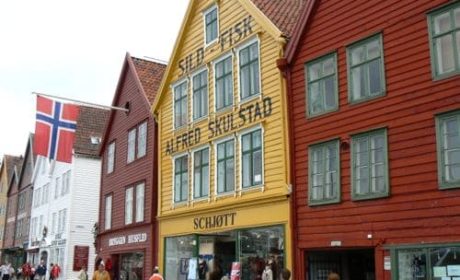

Spanish city named one of the 'best' for history with its 'five-star' tourist attractions
A Spanish town with a long history behind it as been named one of 'the best' with its 'five-star' tourist attractions. Cartagena has been awarded the accolade of 'best Spanish seaside town for history' in a recent survey conducted by Which? Travel .
For history enthusiasts who want to learn a little more about the history of Spain, Cartagena has been described as the perfect destination, as reported by the Express .
Cartagena is located on the coast of Murcia in southeastern Spain. Which? Travel experts praised the region for its "five-star" tourist attractions, which includes museums and ancient ruins to explore.
Read more: Foreign Office warns UK tourists in Turkey 'can be dangerous' and to 'be aware'
Which ? experts said: "That’s thanks to sights such as the 1st-century Roman amphitheatre and contemporary bathhouse and arcade preserved as the Barrio del Foro Romano."
The maritime enclave was a draw for the Carthaginians and Romans, and even now, Cartagena remains an important naval seaport and is home to a large naval shipyard, as reported by the Express .
The port town is also a hub for cruise shops which can arrive every fortnight. It means that the area can get fairly busy, with Which? awarding the town just two stars for peace and quiet.
Some of the city's most popular museums include the National Museum of Underwater Archaeology, Cartagena Roman Theatre Museum and the Municipal Archaeology Museum.
People have also applauded the city for being a great spot for witnessing some of the architectural feats of civilisation past, including Torre Ciega. The monument is the one thing that remains of the Roman necropolic that was found beside the route from Carthago Nova to Tarragona.
You can also find the Roman Theatre of Cartagena, believed to have been built between 5 and 1 BCE. An ongoing project saw the theatre restored and gave the city a new museum space for visitors.
But it's not just history that the seaside town is famous for. Cartagena also has a rich gastronomy science thanks to the wide variety of landscapes of the Region of Murcia.
In Cartagena, the star dishes are products preserved in brine, fish, rice dishes and paellas. Another regional speciality is fig bread and if you want to drink like the locals, Cartagena's asiático is a must-try, made from condensed milk, cognac and cinnamon.
The nearest airport to Cartagena is Murcia, located around 25km away. You can find a one-way flight from Birmingham Airport for as little as £52 on Skyscanner on a random date in May. While hotels are available for two nights in May from £50 on Booking.com .


18 Best Things to Do in Cartagena You Can’t Miss
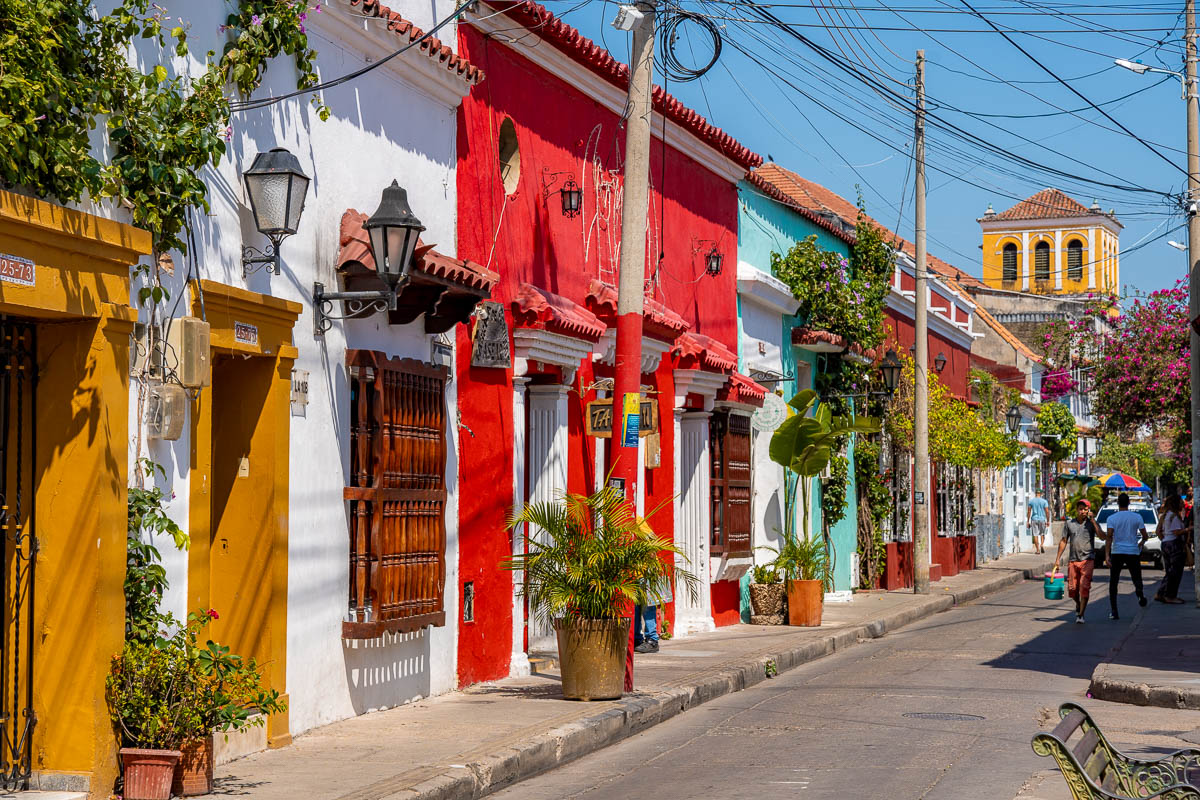
Out of all of the amazing Colombian cities we visited, Cartagena was the one that really stole my heart. Having spent just a few days there, I can totally understand why this spot is the most visited part of the country.
That’s not to say that you shouldn’t set aside a few days in Medellin or Bogota , which you absolutely should, but you simply can’t skip Cartagena!
There are dozens of exciting attractions in Cartagena, and it felt like the perfect blend of history and culture, along with a touch of luxury.
Although the city is known for its well-preserved defensive walls and hip neighborhoods, that’s just a taste of what this tourist hub offers. Some of the other top things to do in Cartagena include trips to nearby islands, excursions to mud-filled volcanos, and countless coffee shop visits.
If all this information is sending you into a frenzy, fear not, as I’ve put together this complete list of what to do in Cartagena to help you pick and choose activities to add to your must-see list.
For a little more detail, check out my 3-day itinerary and my guide to the best places to stay.
With this in mind, let’s dive into the best things to do in Cartagena.
* Disclosure: This post contains a few affiliate links, which means I may receive a small commission, at no cost to you, if you make a purchase through my link. *
Table of Contents
Are you planning a last-minute trip to Cartagena?
If your trip is coming up soon and you still haven’t booked anything, we have you covered! Below you can find our top picks when it comes to hotels, tours, getting around, and more.
Best Tours and Experiences in Cartagena
- Rosario Islands Catamaran with Lunch and Snorkel (the best day trip from Cartagena)
- Totumo Mud Volcano Experience (the coolest experience ever)
- Historic Center and Getsemani Shared Walking Tour (top-rated walking tour, perfect for first-timers)
- Playa Blanca Full-Day Trip (the most beautiful beach in Cartagena)
Best Places to Stay in Cartagena
- Movich Hotel Cartagena (amazing luxury hotel in Centro with an epic rooftop pool and bar)
- Hyatt Regency Cartagena (best luxury hotel on the beach)
- GHL Hotel Armeria Real (great mid-range option with rooftop pool and bar)
- Hotel Blue Concept (budget-friendly hotel with a great restaurant in Bocagrande)
Can’t speak Spanish very well? As people in Cartagena (and in Colombia in general) don’t really speak English, our best tip is to download Spanish on Google Translate so you can use it offline! Trust us, you’re going to need it.
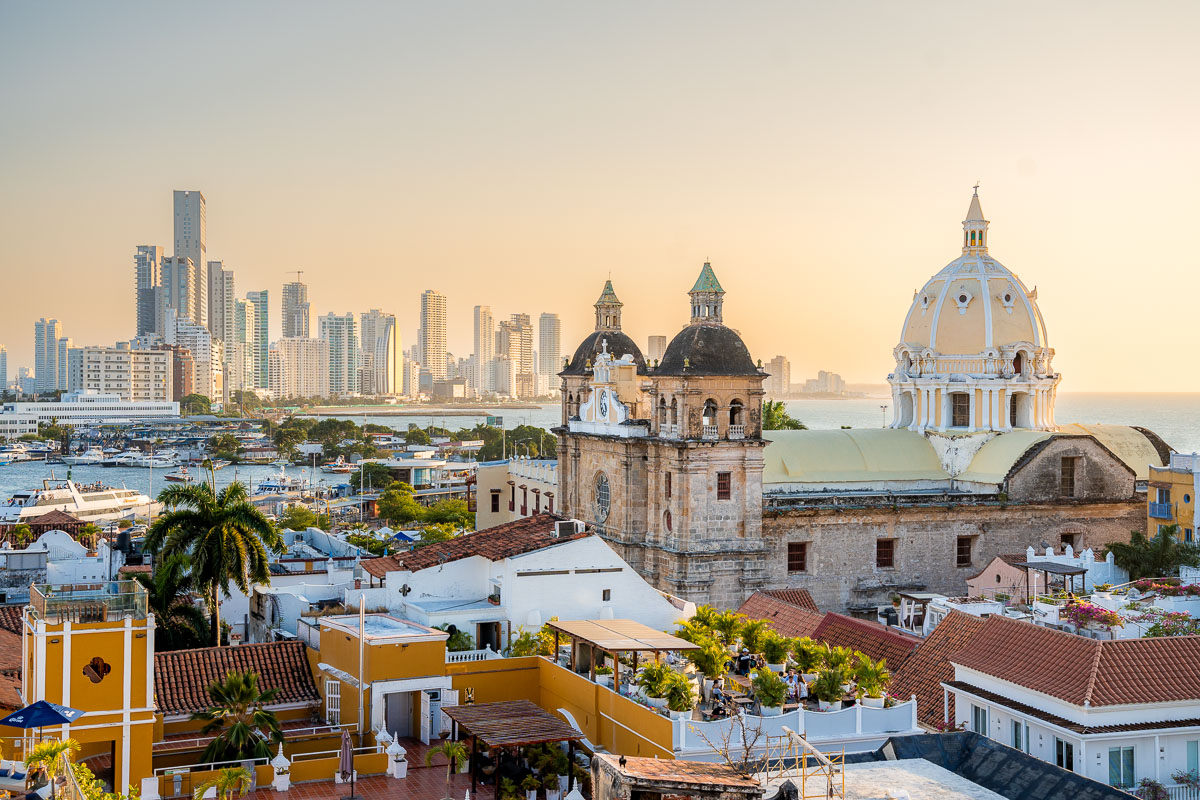
Best Things to Do in Cartagena
1. explore the historic walled city and getsemani on a walking tour.
If you know me, then you’ll know I’m a sucker for a walking tour whenever I land in a new city.
What I love about this one is that it doesn’t just stick to one area, as it covers both the historic center, where you’ll find the iconic Spanish-era city walls, as well as the beautiful and colorful Getsemani district.
Both areas are full of gorgeous colonial buildings and are oozing with history and culture. Your guide will give you all you need to know about the Spanish and Caribbean influences on this north-coast city and how the indigenous Colombian people lived.
Street art, centuries-old churches, and lively walkways are just a taste of what you can look forward to as part of this walking tour, which runs for just under 3 hours.
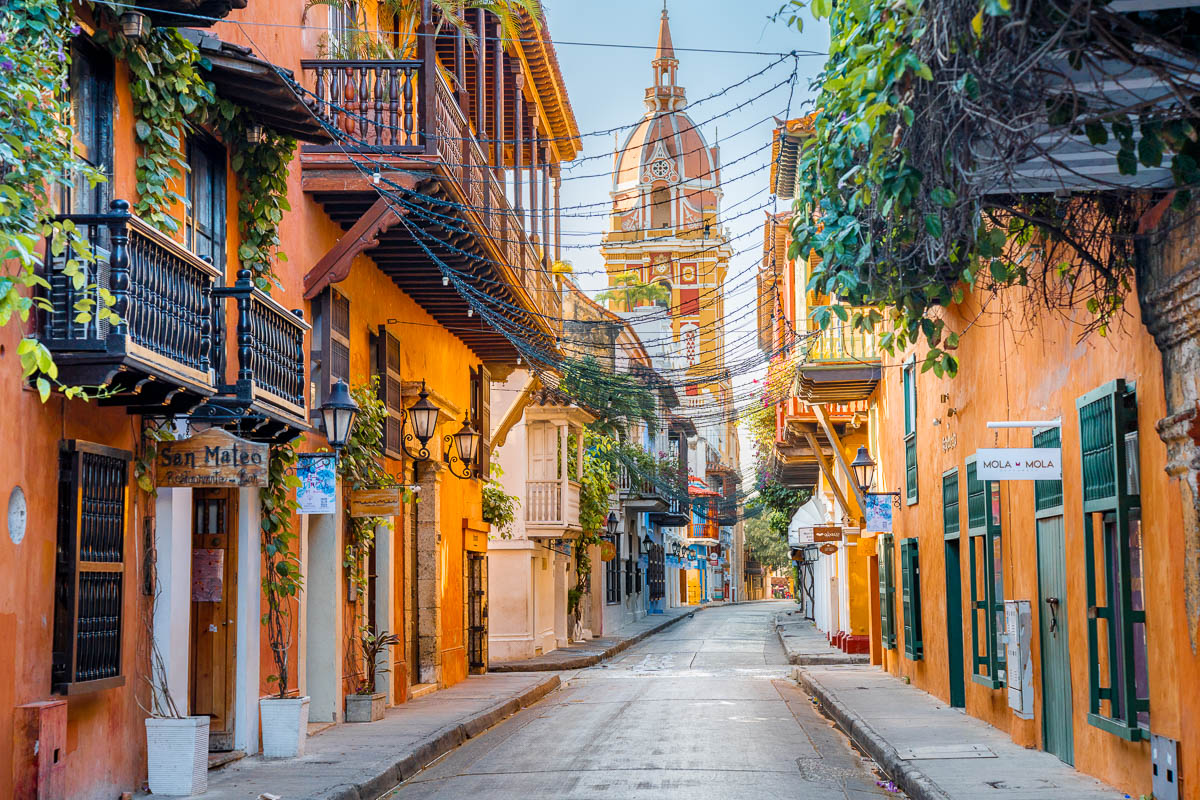
2. Visit Castillo de San Felipe de Barajas
I can’t talk about the best-loved attractions in Cartagena without mentioning the Castillo de San Felipe de Barajas .
This almost 500-year-old fortress is an emblem of Cartagena and was used by Spanish forces to protect the city from potential attacks. The tunnels that wind through the castle are super cool, too, and they are a welcome relief from the heat if you’re visiting during midday.
As the area around the castle has limited shade, aside from the tunnels, your best bet is to arrive here as early as possible. From 7 am onwards, the fortress is open, and tickets are available at the entrance for 30,000 COP ($7.5 US).
If you’re keen to get a bit more background on the castle, I highly recommend hiring a guide when you arrive, as there’s little information on display here.
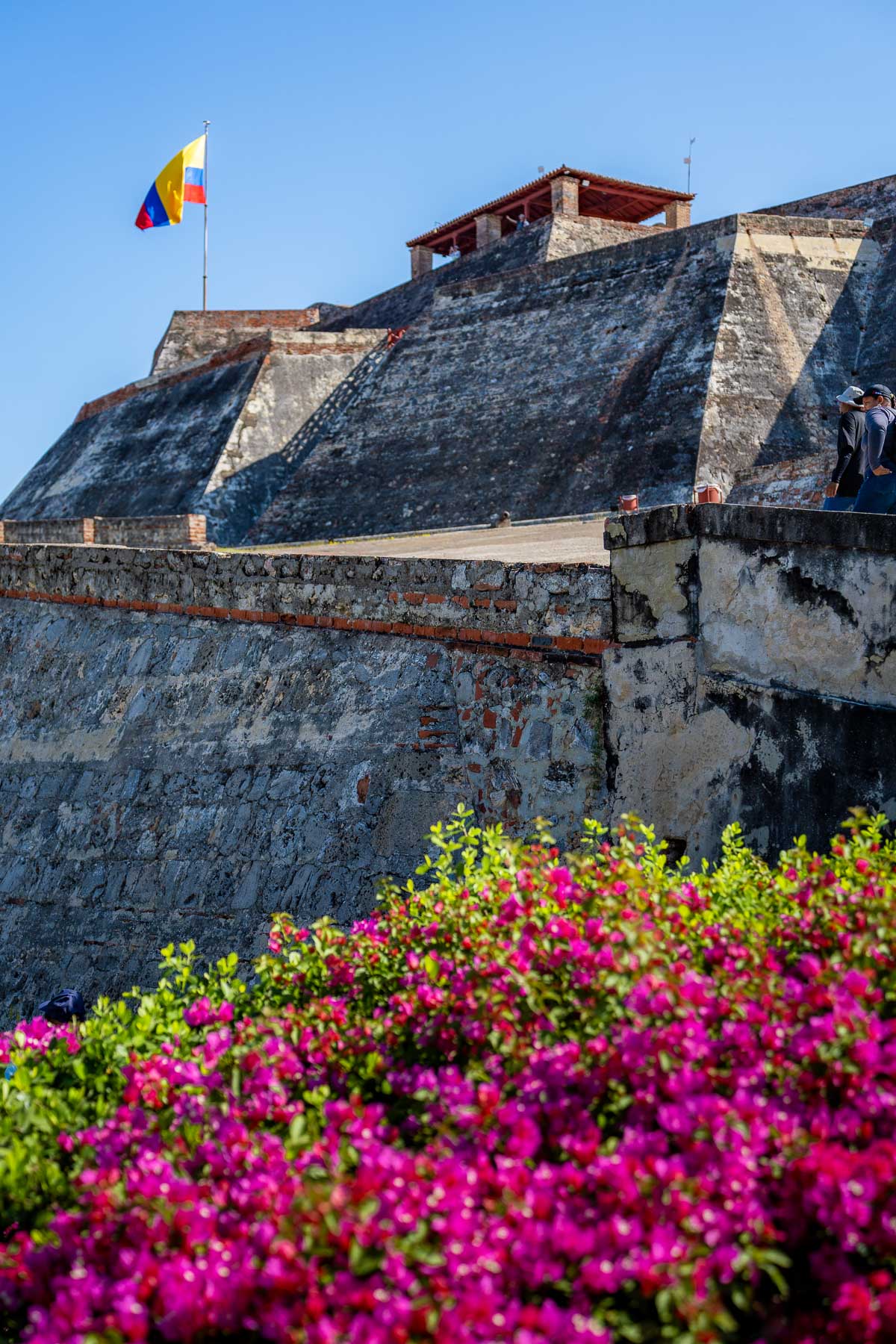
3. Go street art hunting in Getsemani
The Getsemani district is possibly the most photogenic place in all of Cartagena, and that’s largely due to the incredible street art that has brought the whole area to life.
Getsemani is bursting with color from the adorable colonial buildings and famous hanging umbrellas, but it’s the graffiti and street art that give it its hipster edge.
This is a neighborhood that helped to kickstart the movement that aimed to abolish slavery in Cartagena, so much of the artwork represents people’s yearning for freedom and change.
In addition to this, Getsamani also had a reputation as an unsafe and crime-riddled part of town, and expression through art has played a major role in redeveloping the area.
Plaza de la Trinidad is a great place to start, as many of the streets branching off from here are filled with striking and inspirational works of art. My favorite streets are Calle de la Lomba and Calle de Las Sombrillas so definitely don’t miss these!
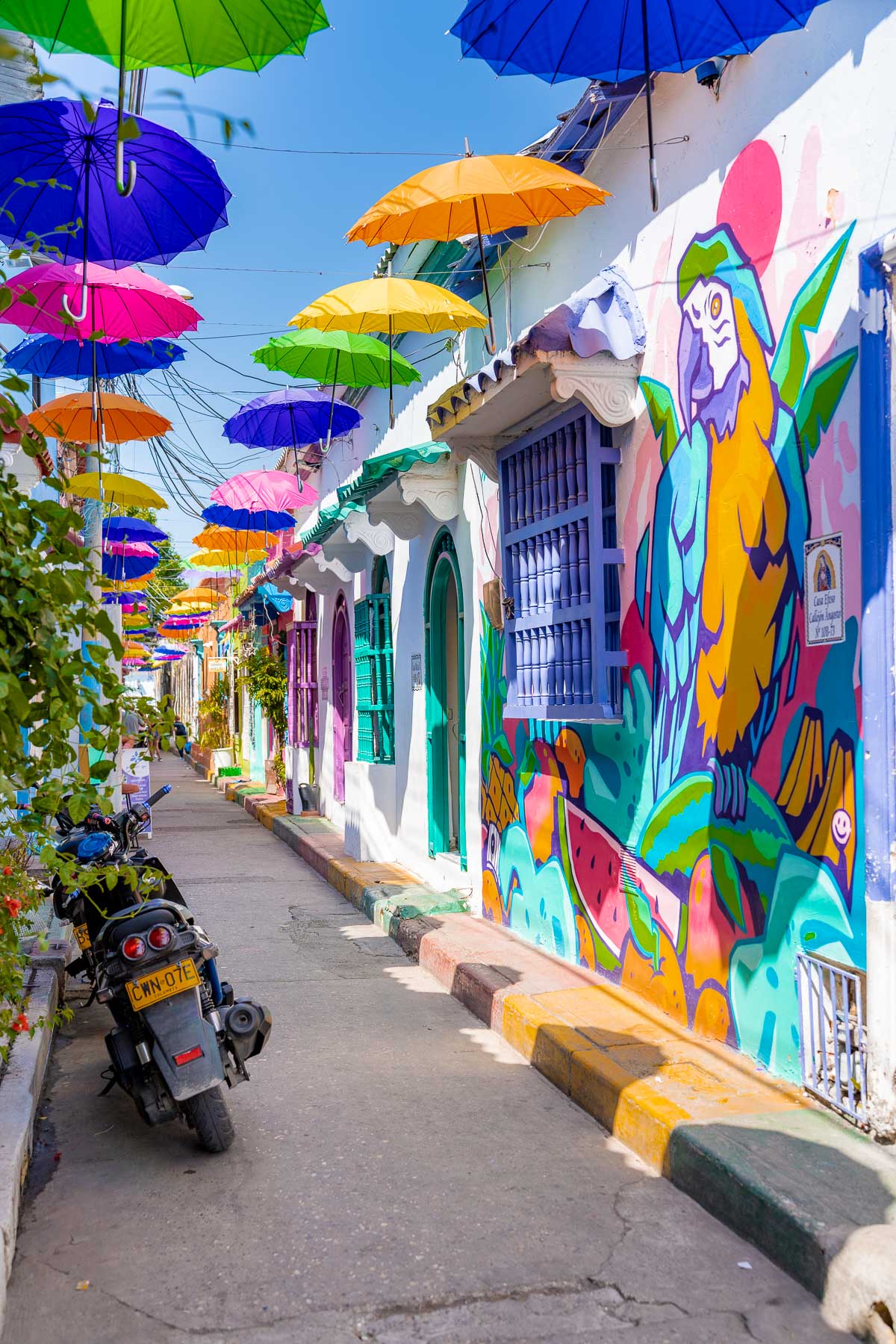
4. Join a tour to Playa Blanca
Playa Blanca is one of the best places to go in Cartagena to soak up some sun and experience a little slice of island life.
This dreamy white sand beach is situated around a 90-minute drive from Cartagena on the island of Baru. Historically, Baru was a peninsula, but it was cut off from the mainland when the Canal del Dique was formed.
Unfortunately there’s no public transport or shuttle services to Playa Blanca, so the easiest way to get there is by joining a tour .
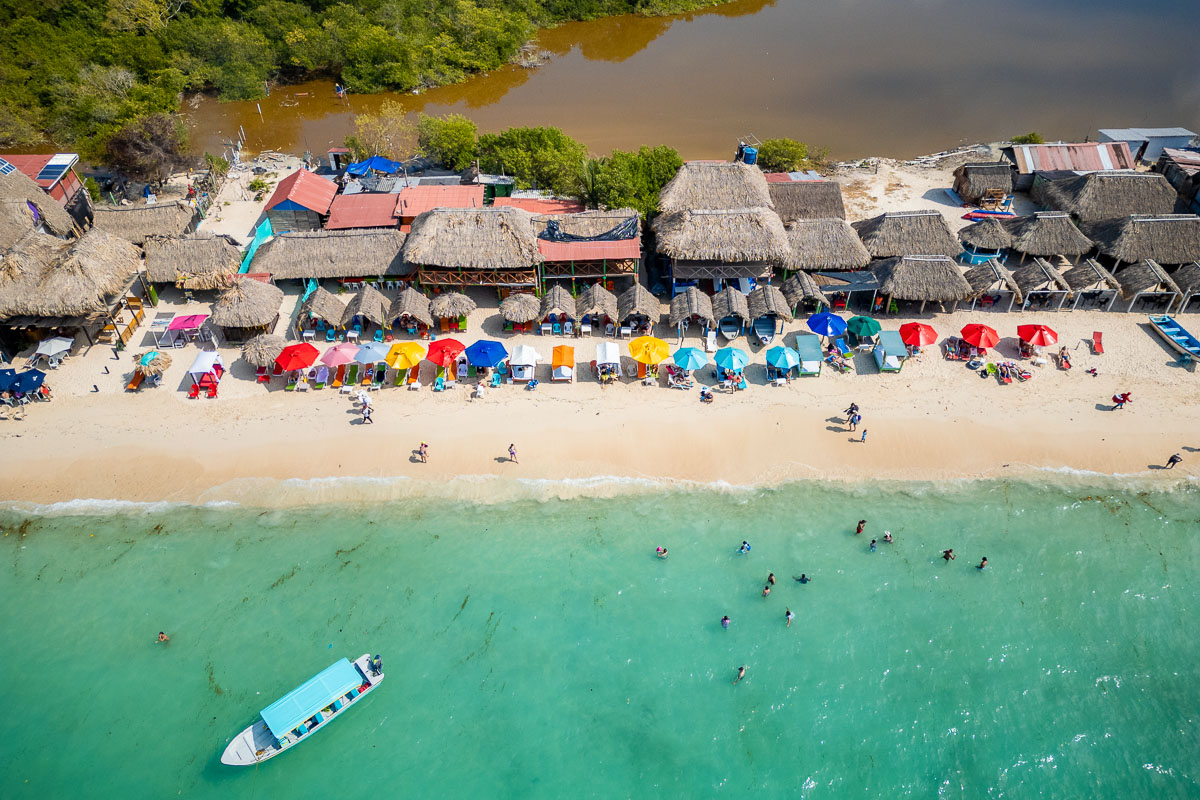
You can also get there by yourself by taking a taxi but I would honestly not recommend doing this. We made the mistake of wanting to go by ourselves and we ended up having a really sketchy journey and quite a stressful day.
We were constantly being followed by “vendors” selling us things, constantly saying no to them and they were not taking no for an answer. Even after paying for a sunbed in a fenced-off area they were still coming up to us and trying to sell us things.
But the worst part was definitely the journey. On the way to Playa Blanca, our taxi was stopped by a group of men trying to block the road and starting to hit the car and demand for us to pay.
And when we wanted to go back to Cartagena, we realized that there were no taxis or Ubers in the area so we had to arrange transport with our broken Spanish and had to get into a car with two complete strangers which was quite stressful. Luckily, we made it back safely but it wasn’t a pleasant experience overall.
So please learn from our mistake and visit Playa Blanca on a tour as it’s much safer and more convenient that way.
Unlike most day-long excursions, this tour gives you lots of free time to chill out on the beach, so you can swim and sunbathe as you please for most of the morning. Each trip is inclusive of a local lunch, and there are usually plenty of vendors around if you’re looking for a drink or snack.
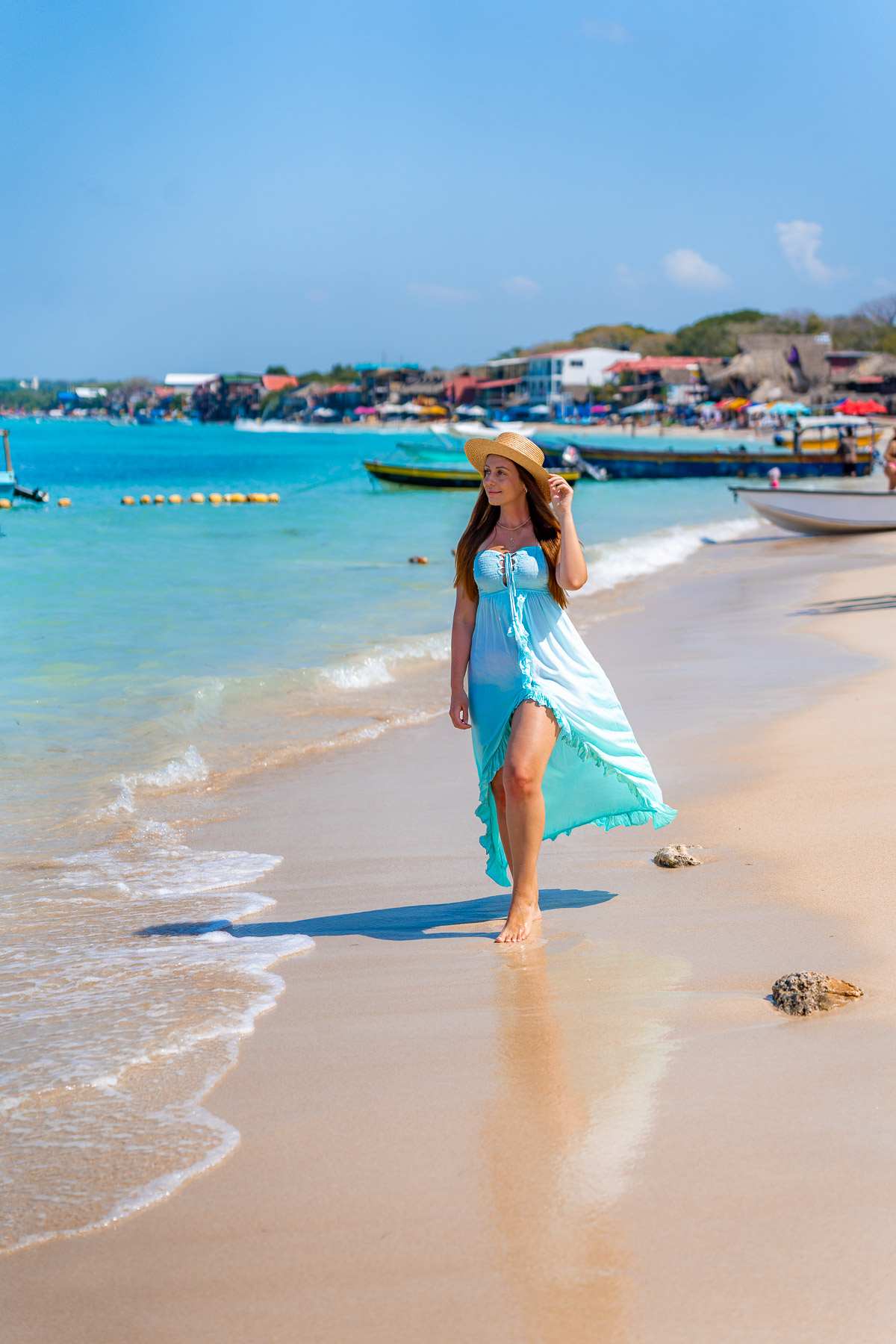
5. Take a boat trip to the Rosario Islands
Another fabulous (and I personally think a much better) way to spend a day in Cartagena is to set sail on a luxurious catamaran around the Rosario Islands .
This archipelago of tiny islands looks like it came from the front of a postcard. The untouched beaches and rustic vibe make these islands feel like they’re totally isolated despite being just an hour away from the city. For sure, these islands are some of the best places to see in Cartagena.
As you cruise around these idyllic islands, you’ll have opportunities to hit the water to snorkel with tropical fish and swim past colorful coral reefs. If you’d prefer, you can always lounge on the catamaran and take in the views for the day.
The tour includes lunch and light snacks, as well as an open bar with beer, wine, and rum cocktails. It was honestly one of the best days we had in Cartagena, and I would highly recommend it.
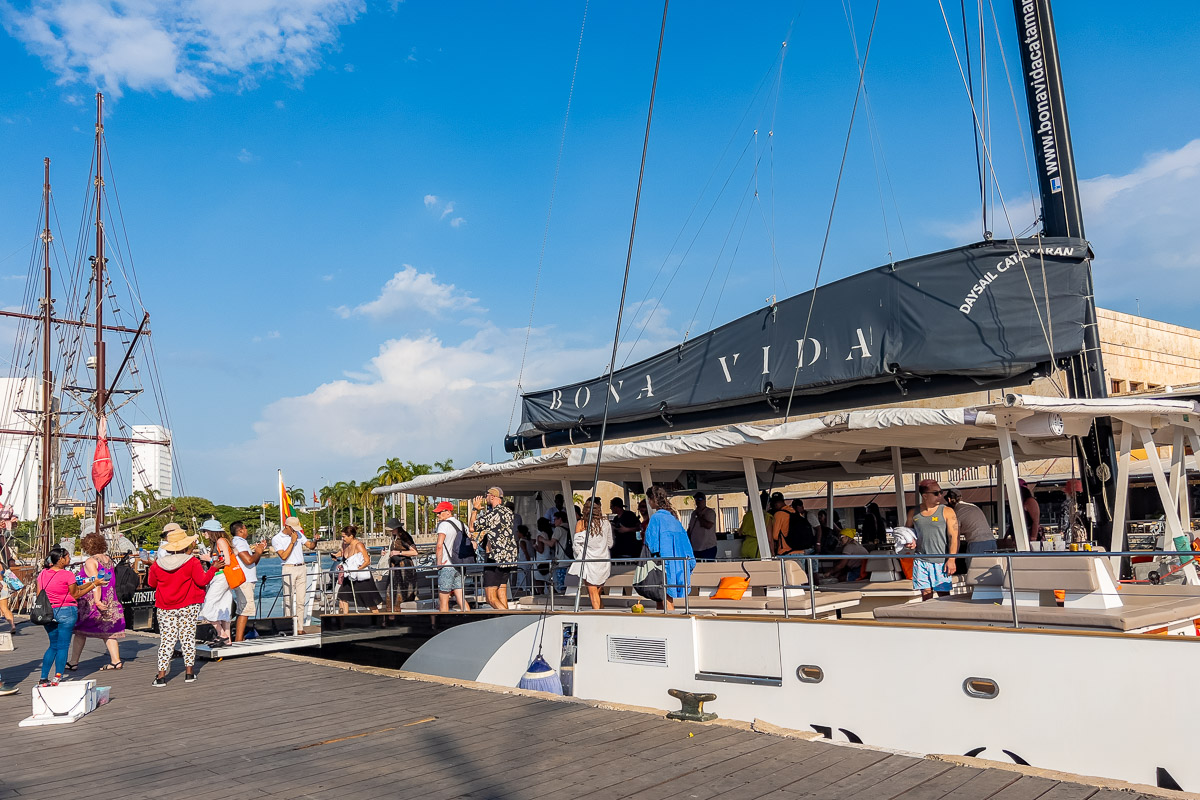
6. Head out on a sunset cruise
If you don’t have time in your itinerary for a day-long boat trip, a sunset cruise is a brilliant alternative. It’s also one of the most romantic things to do in Cartagena if you’re on the hunt for a date night idea.
Cartagena is blessed with some wonderful sunsets, and this cruise gives you uninterrupted views of both the shimmering sea and the city skyline.
These tours usually only run for around two hours and include a beer or wine to sip as the sun goes down, making them the perfect way to wind down after a busy day of sightseeing.
7. Enjoy the sunset at Café del Mar
No Colombia itinerary is ever complete without watching the sunset at Café del Mar at least once!
Strategically perched upon the city walls overlooking the Caribbean Sea, Café del Mar is regarded by many as one of the best places to go in Cartagena to catch the sunset.
All of the tables are outside, so there’s not a bad seat in the house. In saying that, this restaurant gets busy quickly around dusk, so I definitely suggest getting here early or making a reservation.
We stopped by for a drink and the cocktails were amazing and the view was just incredible. In saying that, I’d been eager to sample some of their seafood if we made it back here, as everything we saw looked absolutely delicious.
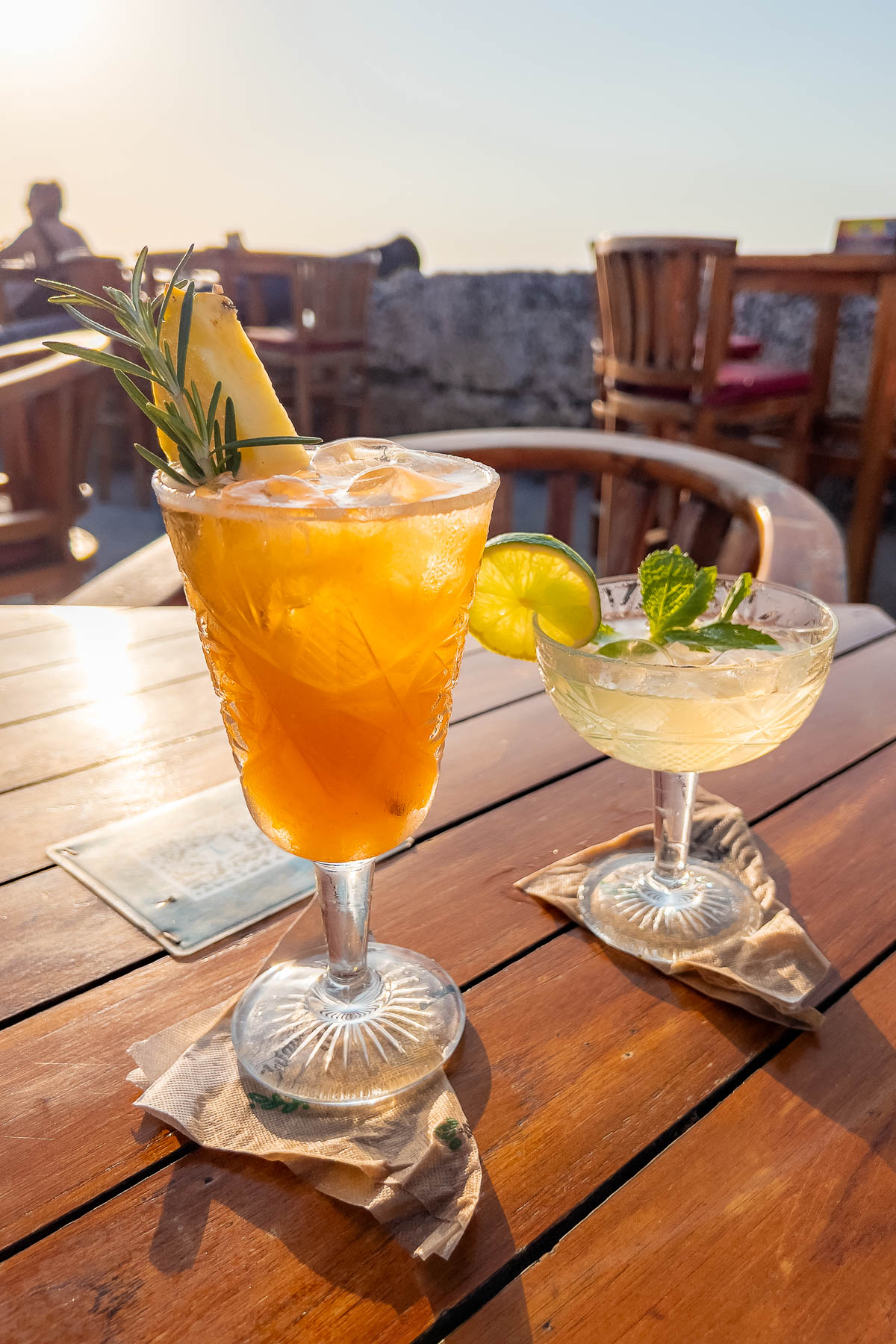
8. Discover the history of Cartagena at the Museum of Cartagena de Indias
No matter where you find yourself traveling, it’s always a good idea to familiarize yourself with the local history, and the Museum of Cartagena de Indias is just the place to do it here.
Set in a stunning building in the heart of the Walled City, this museum gives a pretty good overview of the hardships that Cartagena has been through over the centuries. From the struggle of slaves to the Spanish Inquisition, you’ll find artifacts from all the key moments in Colombian history here.
One downside to this exhibit is that not all of the displays are translated into English, so you’ll likely feel a little lost unless you come equipped with a translator app on your phone.
Your tickets can be purchased on arrival, and they go for 24,000 COP ($6 US) each.
9. Spend the day on Playa del Bocagrande
As heavenly as both Playa Blanca and the Rosario Islands are, sometimes something a little closer by is just what you’re looking for.
Bocagrande is Cartagena’s most upscale neighborhood and is all about beaches, high-end hotels, and premium restaurants.
Playa del Bocagrande is the main beach here and is only around a 15-minute drive from the Walled City. Many of you might find yourself staying in this neighborhood for your trip, meaning the beach will likely be within walking distance from your hotel.
The beach itself is great, but there are a ton of vendors here offering snacks, drinks, and massages, which can become a little overwhelming at times.
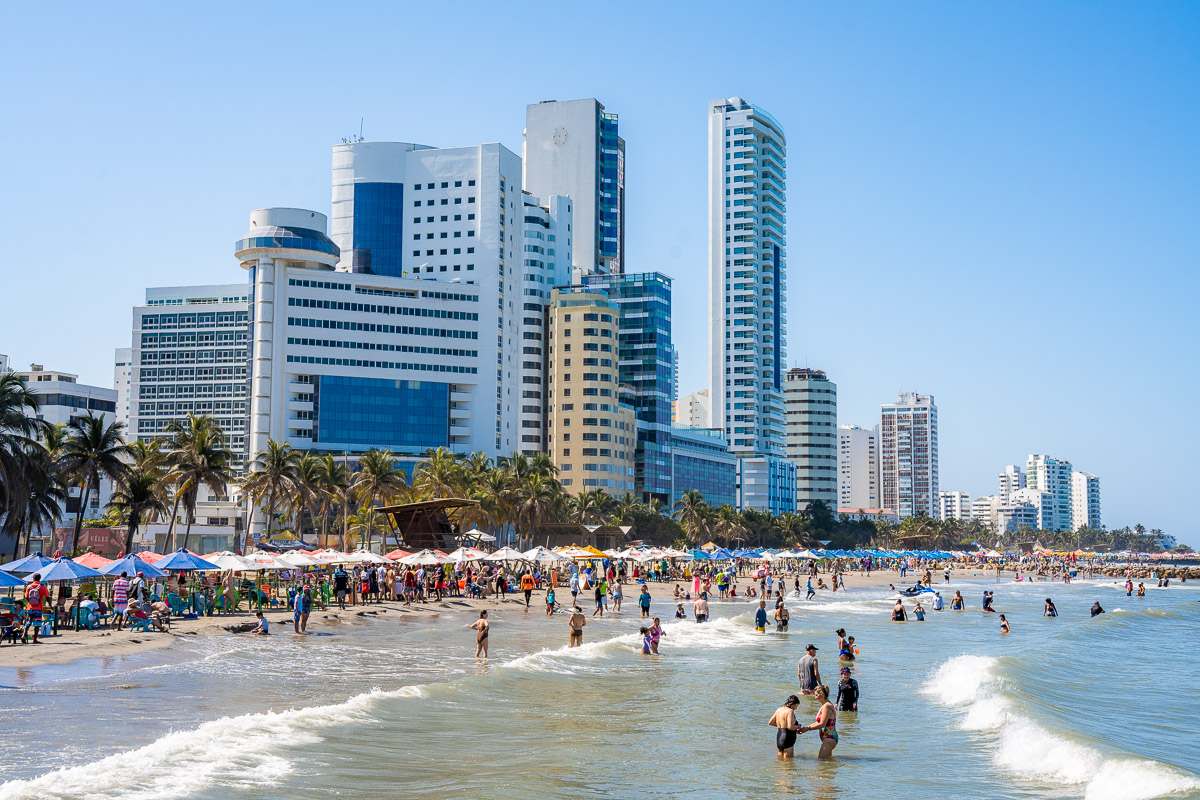
10. Get muddy on the Totumo Mud Volcano Experience
One of the most peculiar but unmissable activities in Cartagena is to make the half-day trip to El Totumo , a tiny mud volcano.
El Totumo is among the world’s smallest volcanoes, and it produces thick, mineral-rich mud rather than lava!
Making the hour-long drive out to El Totumo is a quintessential Cartagena experience and typically involves making a quick climb to the top of the volcano, where you’ll then immerse yourself in warm mud amongst your fellow travelers.
While you’re busy rejuvenating your skin, you’ll likely be offered a massage for a small extra fee, although it’s pretty packed in there, so it may not be the most comfortable encounter!
When you’ve had your fill of bathing, simply walk down the steps and into the lake to wash off the mud before you start the journey back to the city with your group.
11. Have a cocktail at the rooftop bar of Movich Hotel
Another place to rest up during golden hour is the rooftop at the Movich Hotel .
This lodging is tucked away in the center of the Walled City and is home to an elegant rooftop with sweeping views of the old and new Cartagena. Best of all, you don’t have to be a resident here to enjoy dinner or drinks on the rooftop.
The menu has plenty of classic and signature cocktails available, and my lychee martini went down a treat!
Bookings aren’t required here, but it’s always best to call in advance and make a reservation to be safe.
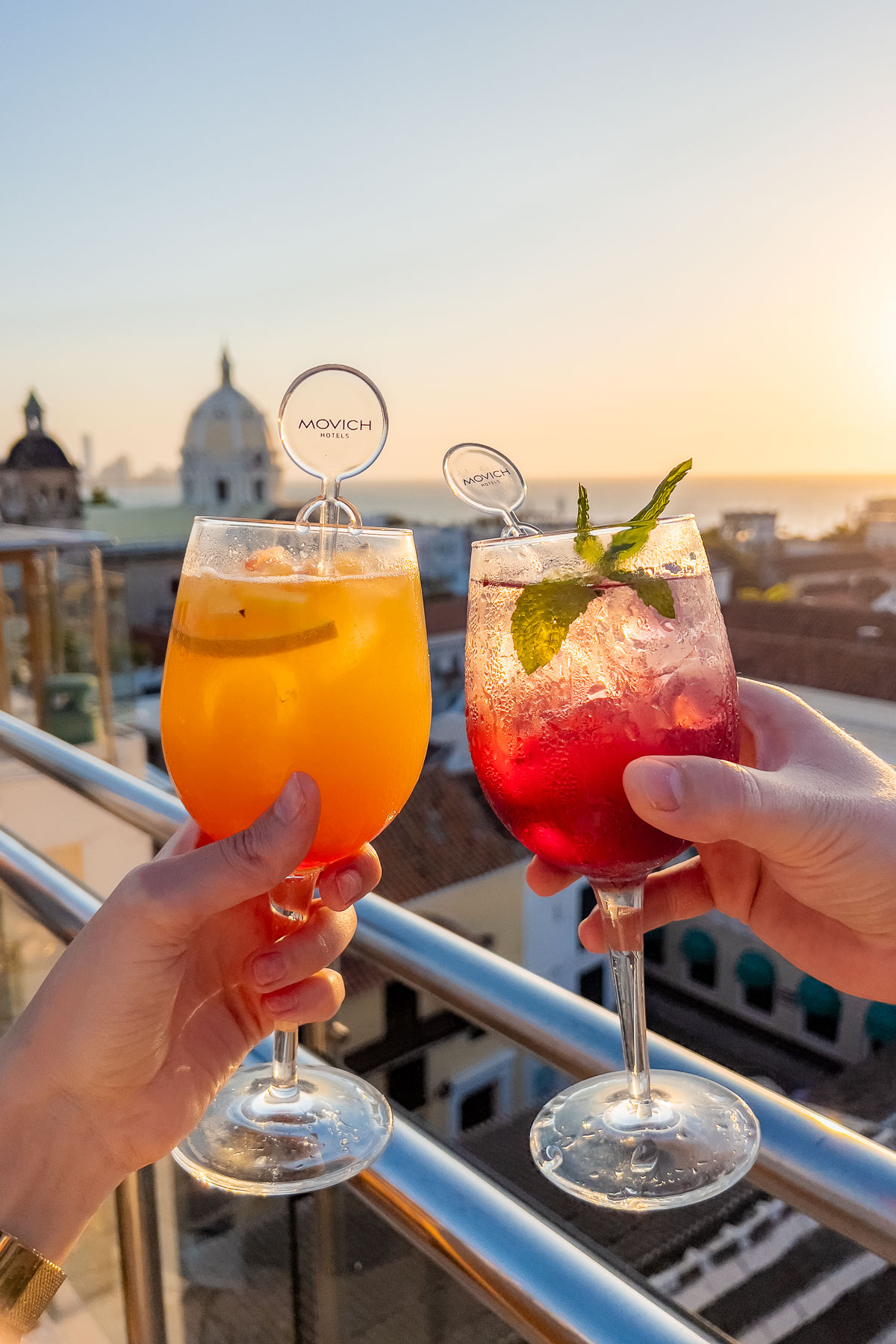
12. Join a street food tour
Eat like the locals do and tuck into some traditional Colombian dishes as part of a street food tour .
As is the case in most countries, the best way to experience authentic and tasty food is to leave it in the hands of a local guide.
In addition to giving you the lowdown on the must-try local eats, your guide will know exactly where to go to find the absolute best version of every dish, so it’s a win-win.
This particular tour takes you on a culinary adventure through 9 different tastings of various Colombian foods and drinks, from fresh juices to savory snacks.
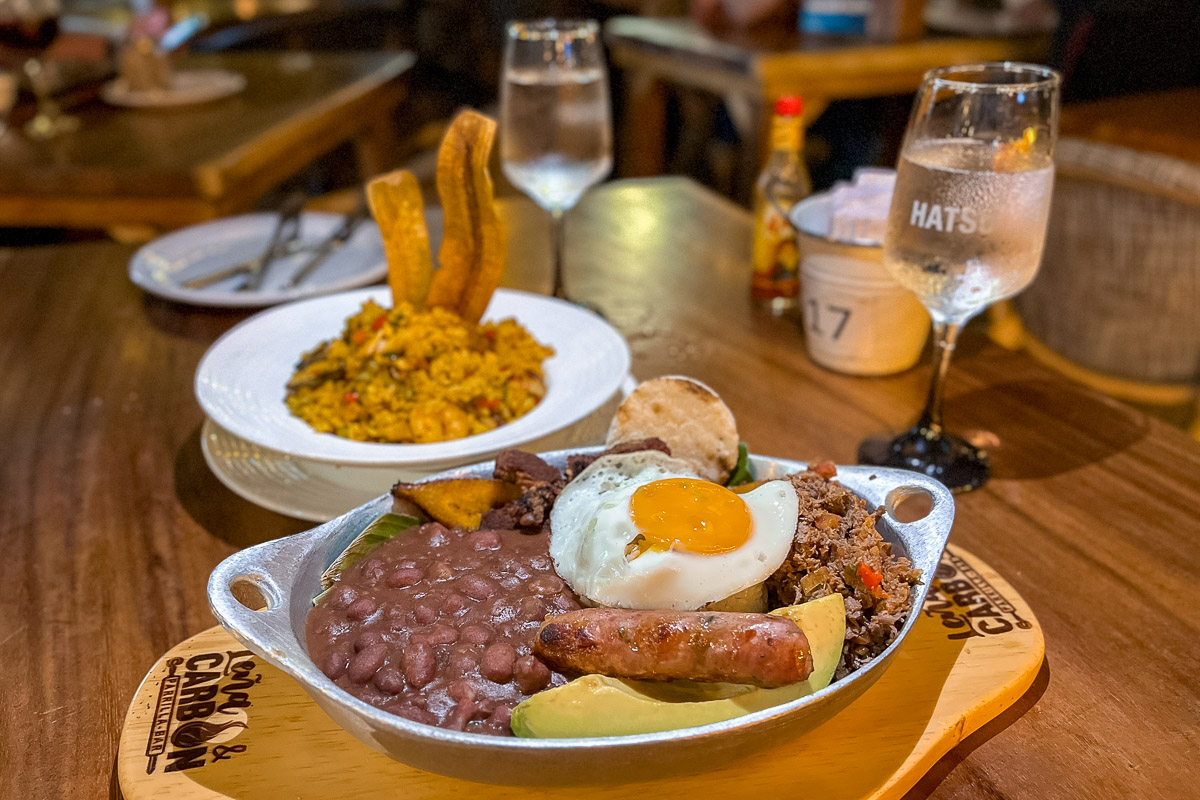
13. Cafe hop in the Walled City
While the Walled City is, of course, especially famous for its captivating history, I also loved it for its fantastic cafe scene.
We stopped by so many gorgeous cafes while we were there, and I had a tough time narrowing it down, but I have a few top picks that I’m confident you’ll love.
Época Café Bar was our go-to spot for brunch (huevos divorciados was a personal favorite), while Ábaco Libros y Café had such a great setting. Hidden in an old-school bookstore, this is such a relaxed little haunt with the most delectable coffee.
Café La Manchuria was another cafe that we kept going back to, and it’s perfect for when you fancy a quick pitstop for coffee and a pastry.

14. Visit the Museo Naval del Caribe
If you’re looking for things to do in Cartagena with kids, the Museo Naval del Caribe is an excellent option, but it’s just as interesting for the grown-ups, too.
The museum is home to a collection of scale models, artifacts, and navy equipment, which come together to recount the history of Cartagena and its status as a maritime city.
I think the little ones will have a blast exploring the likes of the submarine simulator experience and the life-sized replicas of helicopters and coastguard boats, and there are also plenty of interactive exhibits.
Unfortunately, not all of the display boards are in English, so it can be hard to get a clear understanding if you don’t have a guide or translation app.
15. Take a walk in Centenario Park
When you want to slow the pace down a little, go for a wander around Centenario Park and spend a few hours taking shelter from the sun and spotting wildlife.
Centenario Park is not just your average green space; it has quite a unique bunch of residents, including sloths, monkeys, and iguanas. Considering that this park is relatively small, it’s astounding to think that it’s home to such a variety of animals.
It’s also a superb place for anyone interested in bird-watching, as parrots and parakeets are known to make an appearance from time to time.
The park was built as a symbol of Colombia’s independence, though the wildlife often tends to overshadow the historical significance!
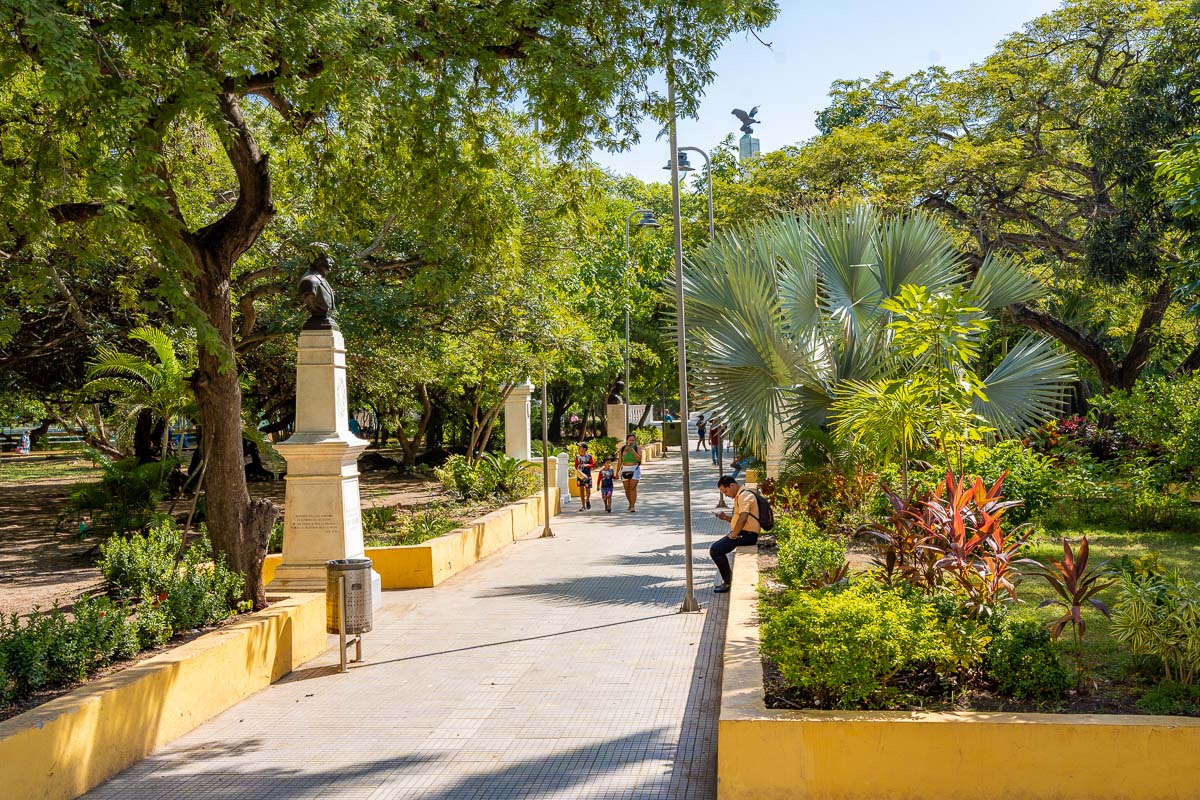
16. Explore the Museo del Oro Zenú
A free, small, but informative museum, the Museo del Oro Zenú focuses on Cartagena’s pre-Columbian era and is packed with ancient relics from the Zenú people, an indigenous community from northern Colombia.
Goldsmithing, ceramics, and pottery were the traditional crafts of the Zenú community, and a wealth of examples of each make up most of the museum’s exhibits.
Also on display inside are a number of short films that give a bit more detail on the way the Zenú people lived and how they developed the skills to craft such ornate pieces.
17. Walk along the city walls
Café del Mar isn’t the only place along the city walls that are open to the public. In fact, most of the walls are perfectly walkable and offer some of the most breathtaking views over Cartagena.
As you can probably imagine, there aren’t exactly a great deal of shaded patches along the walls, so the late afternoon or early evening is most definitely the best time to amble your way around the area and admire the vistas.
You’ll likely notice that some parts of the walls are in much better condition than others. There are plenty of steps along the way connecting the walls to the main streets below, should you stumble upon some inaccessible areas.
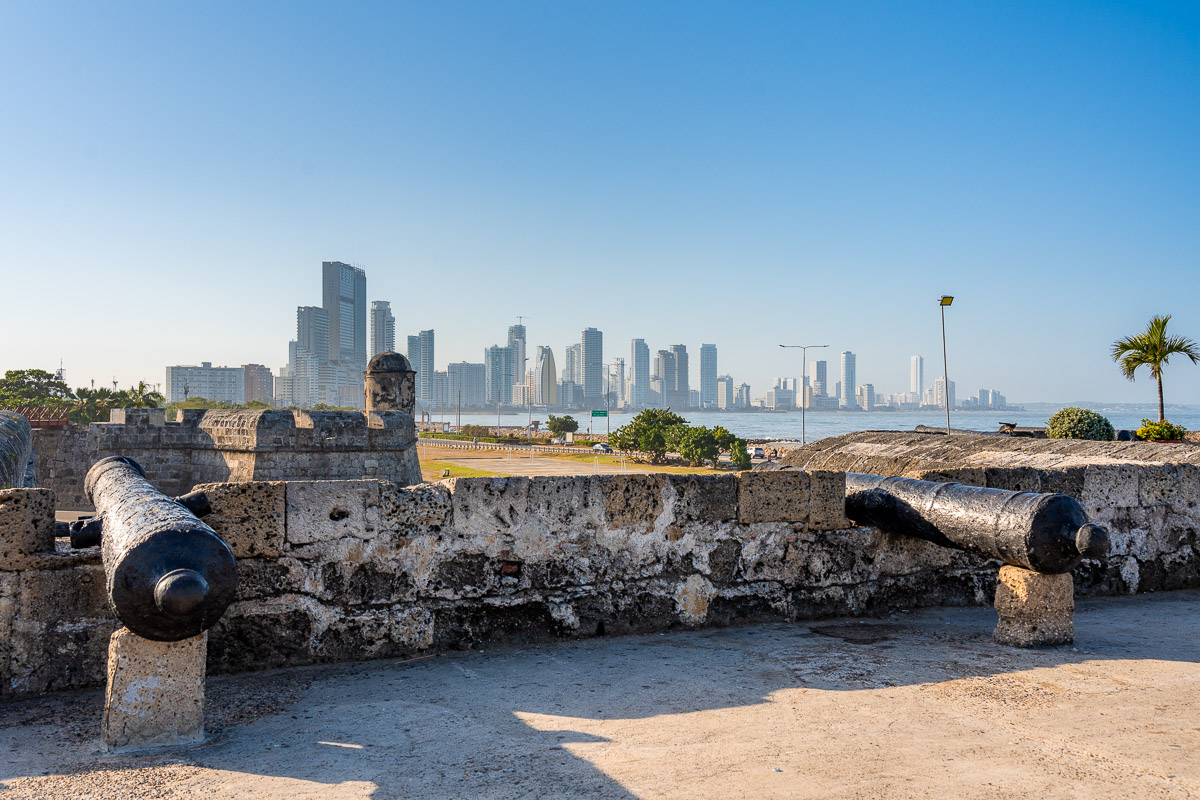
18. Take in the views from Convento de la Popa
When talking about the best viewpoints in Cartagena, you can’t go without mentioning Convento de la Popa , which might just have the best views of them all.
Convento de la Popa is an enchanting convent positioned at the top of Cartagena’s highest hill, meaning some of the most staggering views in the city can be seen from the terrace.
Be sure to give yourself enough time to explore the beautifully kept cloister and small chapel before going to the observation area, as I felt these both made the convent grounds even more impressive.
The entrance fee is 11,000 COP ($2.8 US) and you also have the option to hire a guide which would make the experience much more worthwhile and put everything on the grounds into context.
Planning a trip to Colombia?
Then you might want to take a look at all our other travel guides about Colombia. I promise, they are just as awesome as this article was!
- The Ultimate 2 Weeks in Colombia Itinerary
- 3 Days in Cartagena: The Perfect Cartagena Itinerary for First-Timers
- 18 Best Things to Do in Cartagena You Can’t Miss
- Where to Stay in Cartagena: 6 Best Areas & Hotels
- How to Spend 3 Days in Bogota: The Ultimate Bogota Itinerary
- Where to Stay in Bogota: 5 Best Areas & Hotels
- 10 Unmissable Things to Do in Salento, Colombia (+ Tips for Visiting)
- 3 Days in Medellin: The Perfect Medellin Itinerary for First Timers
- Top 20 Things to Do in Medellin You Absolutely Can’t Miss
- 13 Best Things to Do in Guatape, Colombia
- Luxury Glamping in Guatape: Bosko Hotel Review
- Glamping in Colombia: 17 Stunning Bubbles & Luxury Tents to Book
Pin It for Later!
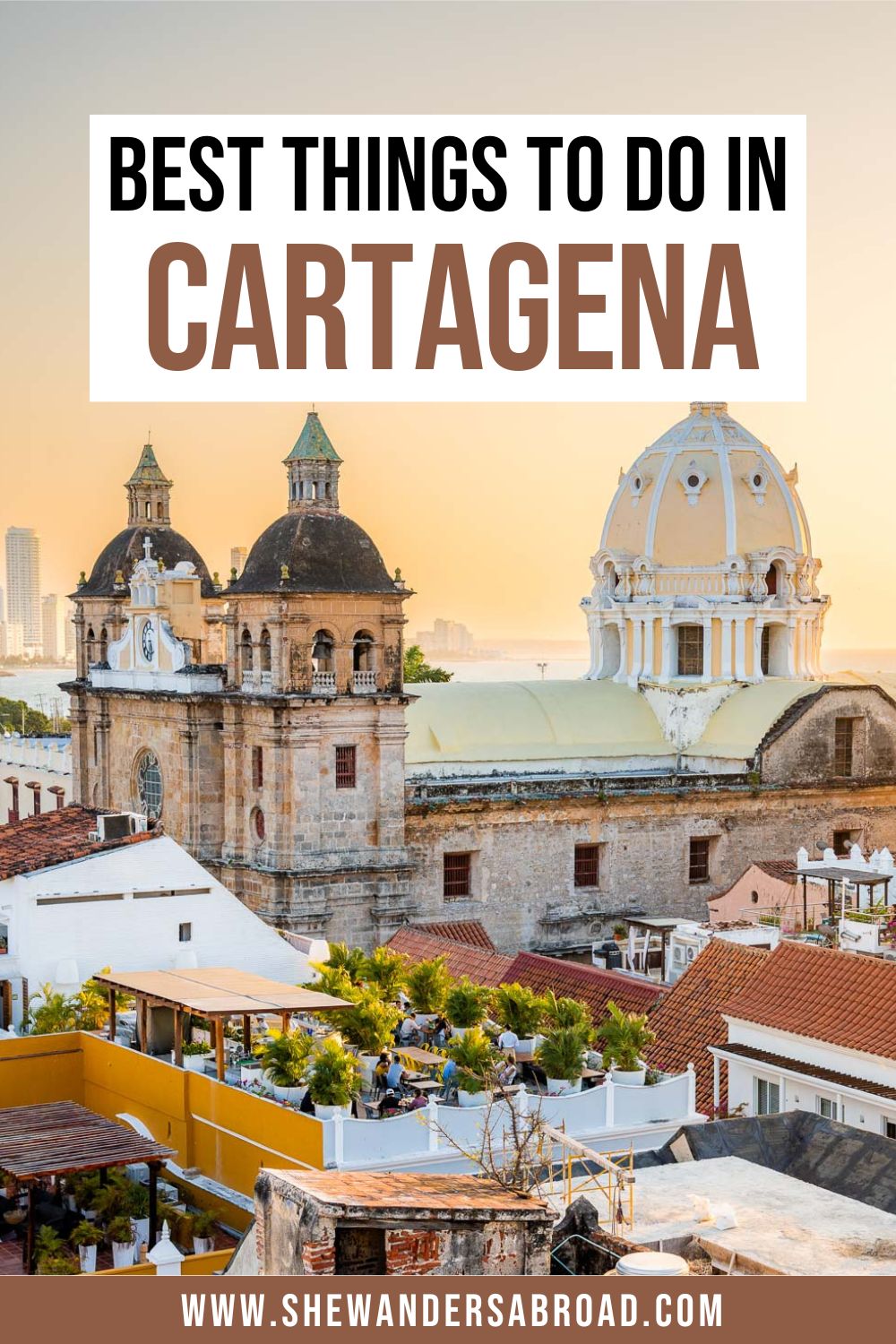
Leave a Comment Cancel reply
Accessibility Links

I’ve been to 31 countries as a solo female. Here’s where I’d recommend
From hiking in nepal to homestays in sri lanka, these are the ultimate trips to go at alone (and my tried-and-tested ideas for how to enjoy them).

I have long been a fan of solo travel. And while women striking out on their own is hardly a new phenomenon — Gertrude Bell, Martha Gelhorn and Dervla Murphy were pioneers in the late 19th to mid-20th centuries — the sheer number of #solotravel posts by women on Instagram suggests it is a growing trend.
Over the past 20 years I’ve visited 60 countries, more than half of them on my own. Travelling alone allows me to shake off the shackles of the person I am at home. I can enjoy long conversations with new people, wander slowly and observe everything, eager to soak in each second of the experience — something I find hard to do when I’m in company.
Many of my most memorable travel moments wouldn’t have happened had I been with a companion. Being invited back to family lodgings for home-cooked meals in Colombia, for example, or chancing upon a shaman ritual at a Bribri village in Costa Rica. Low points have included being groped in India, mugged in Chile and flashed in Cuba and Turkey, but these incidents have done little to deter me.
There is so much goodness and beauty in the world, and the kindness of strangers never fails to move me. There’s nothing more exhilarating than solo travel. My top picks — away from the obvious backpacker trails — are based on the friendliness of the locals, the range of affordable, quality accommodation on offer and ample public transport, to get you further (safely and cheaply).
This article contains affiliate links that can earn us revenue
Advertisement
Safaris and homestays in sri lanka.

Verdant jungle dotted with bright-white Buddhist stupas, a high concentration of wild leopards and elephants, rugged beaches and picturesque temples — it was an easy decision to extend my two-week trip to Sri Lanka (I’m still here now). I took a high-low approach by staying in cute Airbnbs and well-run homestays — a great way to experience local life and home cooking — so that I could splash out on a special night or two. The highlight of these was a sleepover at Wild Coast Tented Lodge on the edge of Yala National Park, with its exquisite poolside suites that have freestanding copper bathtubs ( all-inclusive doubles from £537; resplendentceylon.com). The rate includes daily game drives into Yala — on one 6am excursion I saw blue-tailed bee-eater birds, tufted grey langurs somersaulting through the jungle, juvenile elephants and three leopards lazing on rocks. Outside the luxe lodgings, women travelling alone should take precautions such as avoiding beach walks after dark, dressing modestly and, if you’re visiting remote archaeological sites, going with a group of fellow travellers. Don’t miss Expertly blended arrack cocktails at the Ropewalk bar in the Unesco world heritage site of Galle Fort (cocktails from £5; instagram.com/ropewalksl). Make it happen Intrepid Travel has an affordable, solo-friendly group tour of Sri Lanka exploring the ruins of Anuradhapura by bike, visiting the Sigiriya rock fortress and beaches of Mirissa and meeting Tamil tea farmers. Fourteen nights’ B&B starts at £1,805pp, including transfers, activities and some extra meals (intrepidtravel.com); fly to Colombo.
Rainforests and beach days in Costa Rica

With its ancient virgin cloud forests, more than 2,500 plant species and pura vida way of life, Costa Rica was one of my most relaxing solo trips and a highlight of 2022. It’s a country in which I felt incredibly safe and if, like me, you adore the natural world, it’s a must-visit. I filled my days cycling along coastal paths to national parks on the border with Panama, hiking through rainforests and relaxing on the paradisaical beaches of the Caribbean coast. Because I met friendly locals and fellow travellers wherever I went — on buses, in bars, on walks — I never once felt lonely. In fact some days I wondered whether I’d get an hour to myself. Don’t miss A few nights at the utterly gorgeous Hotel Aguas Claras near Puerto Viejo, where sloths laze languidly in the trees above ( room-only doubles from £245; hotelaguasclaras.com). Make it happen G Adventures runs group tours to Costa Rica for solos, including some in its new “Geluxe” collection aimed at travellers aged 40 and over. Its nature-focused Tortuguero, La Fortuna & Rio Celeste seven-night itinerary, with extra-comfy places to stay, costs from £2,649pp, including mostly full-board accommodation, tours, excursions and ground transport ( gadventures.com ); fly to San Jose.
Tapas and trains in Spain

After spending three months travelling through Spain in 2021 — from buzzy Madrid and historic Pamplona to Barcelona, Valencia, Calpe (for a quick look at Ricardo Bofill’s postmodern apartment complex La Muralla Roja), Seville and Menorca — it has become one of my favourite European countries to explore on my own. Spanish trains and buses are efficient and relatively affordable making it simple to get around; hostels are plentiful and it’s easy to find Airbnb rooms when hotel prices skyrocket during peak season. The local people I met were always eager to share tips or check in on me once they found out that I was travelling alone — something I haven’t experienced everywhere in Europe. The tapas is also a huge draw here, especially at old-school bars tucked away in side streets. Since small bites, or pintxos , are often complimentary and served alongside drinks, it’s easy (and great value) to spend lazy afternoons sampling a whole array of Spanish delights, often to a 1980s soundtrack. Don’t miss A day trip from Madrid to Chinchon, the town where the Wes Anderson film Asteroid City was shot; it takes just over an hour by bus from the city centre. Make it happen Solos Holidays focuses on walking, foodie and cultural tours for those mostly aged 40 and older. Its Walking the Sierra de la Nieves group tour takes like-minded ramblers through the Ronda Mountains in Andalusia, via dramatic scenery and sociable dinners. Seven nights’ half-board costs from £1,659pp, including flights to Malaga (solosholidays.co.uk).
Cooking and street tours in Colombia

When I told friends and family that I was heading to Colombia alone at the start of last year, many people queried my sanity. The country’s narco past, guerrilla warfare and history of kidnappings meant that, for a long time, it was a no-go area for solo travellers, especially women. Today, Colombians detest its drug-riddled past and the glorification of the notorious trafficker Pablo Escobar. Instead they’re eager to showcase the country they adore. According to Juan Sebastian, a lawyer I met on a bus from Medellin to the quaint town of Salamina, “Escobar’s reign was one of the worst chapters in Colombia’s history” — a sentiment shared by many I met in the country. Sebastian introduced me to the whimsical town of Jardin, taking me to his favourite restaurant, Doña Hilda (mains from £4), and showing me impressive waterfalls, many of which weren’t listed in my guidebook. The days I spent in Medellin, Cartagena, Bogota, Barranquilla and Jardin provided me with some of my most precious travel moments, including dreamlike solo hikes through pink banana plantations in Jardin and a colourful street-art tour of Medellin. I felt safe throughout my time in Colombia, especially in the countryside, where farmers and children were always eager to chat. I always organise my own trips, but there are a range of companies offering group tours to Colombia, adding an extra element of security and ease. Don’t miss Leonor Espinosa’s 12-course tasting menu at her Leo restaurant in Bogota, with its focus on regional ingredients, sourced from 52 areas across Colombia. It is a delight from start to finish (from £80; restauranteleo.com). Make it happen The solo travel company Flash Pack specialises in group tours for lone travellers in their thirties and forties; its Vibrant Colombia tour digs into the local scene with cooking classes in Medellin, rum tasting in Cartagena and visits to the Rosario Islands and a coffee farm. Eight nights’ B&B starts at £2,620pp, including all activities, domestic transport and eight other meals (flashpack.com); fly to Bogota.
• 11 of the best group tours for solo travellers • Best city breaks for solo travellers
Mountain hiking in Nepal

As the gateway to the Himalayas, Nepal stuns at every turn. The remarkable country captured my heart in 2015, during a monthlong solo jaunt in which I trekked with two female Nepalese guides through hypnotic mountains to Annapurna Base Camp, at a heady 4,130m (13,551ft). Alone with my thoughts most days, I was forced to look inward, helping me to make sense of a messy recent break-up. The soaring mountains and ethereal beauty of the landscape made me realise the insignificance of our time on the planet. After seven days of hiking and sleeping in some of the basic teahouses that dot the hillsides, I awoke to catch the sunrise turning the peak of one of the highest mountains in the world to gold. Kathmandu and Pokhara, the jumping-off point for hikes into the Annapurna range, are well equipped for solo travellers, with a range of great hostels, restaurants and cafés where crossing paths with fellow adventurers of all ages is easy. Don’t miss Catching a glimpse of the Living Goddess Kumari at the Kumari Ghar in Durbar Square, Kathmandu. It is believed that the goddess is a manifestation of divine female energy and she occasionally makes unscheduled appearances on the balcony of her palace. Make it happen Much Better Adventures runs 16-night treks of the Annapurna Circuit for groups of up to 12 (active) travellers. Rated as “challenging”, its trips put you up in guesthouses and teahouses and include free time for exploring Kathmandu. Sixteen nights starts at £1,230pp, including guides, porters and five meals (muchbetteradventures.com); fly to Kathmandu.
Great food in Naples

I don’t want to draw comparisons to the Eat, Pray, Love memoir, but Italy is one hell of a draw for solo females — especially if you love to eat. Ahead of my monthlong, summertime trip to the country, friends balked at the idea of spending August in Italy: “Too hot! Too expensive!” But I couldn’t disagree more. As I wasn’t interested in the Amalfi coast, I stuck to Naples, and my Airbnb host quickly became my guide to the vibrant city, offering daily recommendations: Mennella for dreamy gelato (from £2; pasticceriamennella.it) and Buatta di Angela Gargiulo for the best pasta in town (mains from £9; buattanapoli.com). I also took captivating day trips to Pompeii and the unsung island of Procida. Don’t miss Banksy’s Madonna With a Pistol mural, next to the Church and Convent of the Girolamini. Make it happen Four nights’ room only for two at Palazzo Adele, just along the coast in Ercolano and rated “exceptional”, starts at £386pp, including flights (expedia.co.uk).
Which countries have you travelled to solo? Share your tips in the comments below
Become a subscriber and, along with unlimited digital access to The Times and The Sunday Times, you can enjoy a collection of travel offers and competitions curated by our trusted travel partners, especially for Times+ members
Sign up for our Times Travel newsletter and follow us on Instagram and X
Related articles

Switch language:

Spanish port grapples with allegations of ships carrying arms to Israel
Spain denied the Marianne Danica cargo vessel’s port of call in Cartagena for shipping explosives from India to Israel.
- Share on Linkedin
- Share on Facebook

Earlier today (17 May), the Borkum carrier decided not to attempt to dock at Cartagena Port, Murcia, amid swirling allegations that the Antigua and Barbuda-flagged vessel is shipping arms to the Israel Defence Forces (IDF) via Ashdod Port.
The commotion was but the latest controversy in a chaotic week for Cartagena’s port authorities and Oscar Puente, Spain’s Minister for Transport, who has vehemently denied the allegations.
Go deeper with GlobalData

Innovation in Ship: Anti-fouling Ship Hull Coatings
Environmental sustainability in ship: bio-fuel propulsion marine ve..., premium insights.
The gold standard of business intelligence.
Find out more
Related Company Profiles
Chennai petroleum corp ltd, maersk line as.
Spain’s government, however, rejected the Marianne Danica’s port of call at Cartagena on Wednesday (15 May), El País reported, as part of what Foreign Minister José Manuel Albares called “a consistent policy with any ship carrying arms to Israel that wants to call at Spanish ports”.
The vessel’s operator H Folmer & Co said the government’s decision was a “mistake”, Trade Winds reported. The Danish-flagged Marianne Danica was en route from Chennai, India, to Israel’s Haifa Port, satellite data from Marine Traffic shows, but its last transmitted location was just off the coast of Mauritania, West Africa.
Why did Spain block the Marianne Danica’s port of call?
Madrid’s decision, the first time Spain has refused port of call authorisation for Israeli-arms-carrying ships, is a bold move by Prime Minister Pedro Sanchez’s leftist coalition government.
It remains rare for EU members to reject carriers registered under another EU country.
How well do you really know your competitors?
Access the most comprehensive Company Profiles on the market, powered by GlobalData. Save hours of research. Gain competitive edge.

Your download email will arrive shortly
Not ready to buy yet? Download a free sample
We are confident about the unique quality of our Company Profiles. However, we want you to make the most beneficial decision for your business, so we offer a free sample that you can download by submitting the below form
The European Commission’s Articles 3eb and 3ec state that “port access should not be granted if a competent authority has reasonable cause to suspect that the vessel is in breach of the relevant prohibitions”. This framework names Russian oil exports as prohibited, but not arms intended for IDF use in Gaza.
Spain exercised this right in February 2023, when the government banned a Singapore-flagged vessel operated by Denmark’s Maersk from Spanish ports after its cargo of oil products was discovered to have been carried by another vessel that was formerly Russian-flagged.
The refusal of the Marianne Danica’s port of call marks an escalation in Sanchez’s pro-Palestine stance amid Israel’s continued offensive.
Along with Ireland, Spain has been among the most vocal European nations in calling for a two-state solution and recognising Palestine as a separate state.
Is the Borkum also transporting arms to Israel?
Madrid’s stance on Israeli-bound vessels has not come without political headache.
While the government says it has proof that the Marianne Danica was carrying explosives intended for the IDF, it believes similar allegations around the Borkum are baseless.
“I do not understand the controversy that has been caused,” Puente told reporters yesterday (16 May). “Creating controversy on absolutely false claims is serious amid the Palestine-Israel conflict, where so many innocent lives are at risk; playing with these feelings is, to me, deeply irresponsible.”
La que van a liar con el barco. Oscar Puente te deja claro que lo del barco es otro bulo más. Que rule!!! pic.twitter.com/KsD1IyB0kT — Fran Guerrero (@Fran_Guerrero82) May 16, 2024
Puente is part of Spain’s Socialist Party (PSOE), which has held office in Spain under Prime Minister Pedro Sánchez since 2018. In October 2023, PSOE entered into a coalition government with Sumar, an alliance of leftist Spanish parties.
In a post on X , Puente accused Javier Sánchez Serna, political representative of Podemos (part of Sumar) in Murcia, of aggravating the situation by visiting the Port of Cartagena to investigate the Borkum .
Sumar officials and the Solidarity Network Against the Palestinian Occupation (RESCOP, by its Spanish initials), have alleged the Borkum is also carrying weapons to Israel’s Ashdod Port from Chennai. But Puente says it is carrying military supplies to the Czech Republic, not Israel.
“In this country, the vast majority of us are with the Palestinian cause, as is the Spanish government”, Puente added. “If a ship was carrying arms, and we had legitimate proof it was bound for Israel, nobody would have any doubt that the Spanish government would stop it.”
Spain’s Ministry of Transport had not responded to Ship Technology’s request for comment at the time of publication.
Sign up for our daily news round-up!
Give your business an edge with our leading industry insights.
More Relevant
Rhine port of Kehl launches feasibility study for wind energy
India and iran strengthen chabahar port partnership with new deal, sustainable shipping companies and solutions, dp world acquires savannakhet dry port in laos, sign up to the newsletter: in brief, your corporate email address, i would also like to subscribe to:.
Ship Technology In Brief
Ship Technology Global : Ship Technology Focus (monthly)
I consent to Verdict Media Limited collecting my details provided via this form in accordance with Privacy Policy
Thank you for subscribing
View all newsletters from across the GlobalData Media network.

IMAGES
VIDEO
COMMENTS
What to visit. Select from the list or hover over the map to find out about points of interest. National Museum of Underwater Archaeology. Cartagena Roman Theatre Museum. "Enrique Escudero de Castro" Municipal Archaeology Museum. Torre Ciega.
So towards the end of the century some gorgeous art nouveau buildings went up. You could fit the best ones into a walking tour and they include the Palacio Pedreño, the Casino de Cartagena, the Casa Cervantes, the Palacio de Aguirre and the Gran Hotel. 4. Palacio Consistoria. Source: turismocuatro.
Cartagena is a city with more than 2,500 years of history. Each corner, street and square of the city offers travellers monumental examples of its splendorous historical past, of the civilizations that put in at its port. The visitor will also be able to enjoy the local gastronomy which, in the case of Cartagena, is special in that it is a port ...
Top Things To Do In Cartagena, Murcia Region - Our Cartagena Itinerary For 3 days. Visiting the Old Town and nearby monuments. Exploring ancient Roman ruins. Trying Andalusian cuisine and tapas. Relaxing on the best beach in Cartagena. Discovering wildlife from Southern Spain.
Things to Do in Cartagena, Spain: See Tripadvisor's 53,511 traveler reviews and photos of Cartagena tourist attractions. Find what to do today, this weekend, or in May. We have reviews of the best places to see in Cartagena. Visit top-rated & must-see attractions.
Understand Ancient History at the Punic Wall. View Map. Address. C. San Diego, 25, 30202 Cartagena, Murcia, Spain. Phone +34 968 50 00 93. Web Visit website. Cartagena has made a great effort to explain the sometimes complicated history to visitors. The Punic Wall Interpretation Center protects the remains of Cartagena's oldest part, the ...
Cartagena. Spain, Europe. Cartagena's fabulous natural harbour has been used for thousands of years. Stand on the battlements of the castle that overlook this city and you can literally see layer upon layer of history spread below you: the wharf where Phoenician traders docked their ships; the street where Roman legionaries marched; the plaza ...
Top Things to Do in Cartagena, Spain: See Tripadvisor's 53,502 traveller reviews and photos of Cartagena tourist attractions. Find what to do today, this weekend, or in May. ... Cartagena Tourism Cartagena Hotels Cartagena Bed and Breakfast Cartagena Vacation Rentals Flights to Cartagena Cartagena Restaurants Cartagena Attractions Cartagena ...
Things to Do in Cartagena, Spain: See Tripadvisor's 53,511 traveller reviews and photos of Cartagena tourist attractions. Find what to do today, this weekend, or in May. ... Cartagena Tourism Cartagena Hotels Bed and Breakfast Cartagena Cartagena Holiday Rentals Flights to Cartagena Cartagena Restaurants Cartagena Attractions Cartagena Travel ...
Murcia. Discover the best attractions in Cartagena including Museo Nacional de Arqueología Subacuática, Museo del Teatro Romano, and Barrio del Foro Romano.
Best Things To Do In Cartagena, Spain. Travel tip. If you're interested in visiting more than two Cartagena's sites you might want to buy one of the combined tickets which allow access to the various sites at a cheaper rate. There are several options ranging from a 13€ ticket that allows access to 4 museums to the complete voucher that ...
By somizoom. 31,957. Explore Cartagena. A Roman amphitheatre, Moorish castle, and the bombed-out ruins of a 13th-century cathedral are just some of the major sights in history-steeped Cartagena. Add in beaches, thrumming nightlife, and mountainous surrounds, and you have one of southern Spain's most vibrant and varied cities.
31,957. Explore Cartagena. A Roman amphitheater, Moorish castle, and the bombed-out ruins of a 13th-century cathedral are just some of the major sights in history-steeped Cartagena. Add in beaches, thrumming nightlife, and mountainous surrounds, and you have one of southern Spain's most vibrant and varied cities. Read more.
Cartagena Spain . Visitor & Tourist Information . Cartagena Spain. Cartagena Spain. Cartagena, Spain, is located in the southeast of the country bordering on the Costa Blanca and the Costa de Azahar. Often overlooked by visitors to Spain, it is a city brimming with history, culture, and Mediterranean charm.
The months of July, August and September are the warmest in Cartagena, with high temperatures averaging about 30°C (86°F) with plenty of sunshine. Conversely, the coolest months in Cartagena are in December, January and February, where the average high temperature is around 17°C (63°F) — still very warm when compared to elsewhere in ...
Cartagena Tourist Information Office. Cartagena Tourist Office Address: Calle San Diego 25, 30201, Cartagena (Murcia) Telephone Number: +34 968 128 955 Email Address: [email protected] Website: www.cartagenaturismo.es. Cartagena Tourist Office Address: Palacio Consistorial, Plaza del Ayuntamiento s/n, 30201, Cartagena (Murcia)
Mercado de Santa Florentina. One of the best ways to start your time in Cartagena is to head to the local Mercado de Santa Florentina. Open every day except Sunday from 8am to 3pm, this market has a range of typical fresh produce including fruits and vegetables, olives, cheeses, fish and meats. Apart from picking up a few snacks for your day of ...
Situated in the southeastern corner of Spain, in the province of Murcia, the town may be relatively small, but it is home to 12 museums, 10 buildings of interest, four churches and many monuments. Cartagena also has one of the most fascinating histories in all of Spain, being inhabited by a number of great civilisations and cultures
Cartagena. Cartagena is the main seaport of the Murcia region. It has 214,000 inhabitants (2018), the second-largest city in the region. Cartagena concentrates an artistic legacy that summarizes almost three millennia of Spanish history, being inhabited by most great Mediterranean empires that have conquered the Iberian Peninsula.
Cartagena is in the province of Murcia in the region of Valencia and Murcia. Cartagena has been an important site for centuries due to its deep natural harbour. ... Aguilas has a carnival which has been going for 200 years now and is included in Spain's official tourist calender (events of National tourist interest). You can find more local ...
Tips for a DIY walking tour in Cartagena, Spain. When you visit Cartagena, a few tips will make your time even better. Bring a bottle of water from the ship or fill up your personal water bottle as it can be hot any time of year in Mediterranean climates. Wear a hat and sunscreen for protection from the strong sun—follow my skin cancer travel ...
Interactive map of Cartagena, Spain with all popular attractions - Castillo de la Concepción, Roman Theatre Museum, Muralla Púnica and more. Take a look at our detailed itineraries, guides and maps to help you plan your trip to Cartagena, Spain. . Interactive map of Cartagena, Spain with all popular attractions - Castillo de la Concepción ...
Cartagena is located on the coast of Murcia in southeastern Spain. Which? Travel experts praised the region for its "five-star" tourist attractions, which includes museums and ancient ruins to ...
2. Visit Castillo de San Felipe de Barajas. I can't talk about the best-loved attractions in Cartagena without mentioning the Castillo de San Felipe de Barajas. This almost 500-year-old fortress is an emblem of Cartagena and was used by Spanish forces to protect the city from potential attacks.
The Roman Theatre of Cartagena is a popular tourist attraction (Image: Getty Images) Sat on the coast of Murcia in southeastern Spain is Cartagena, a port city which has a long history behind it.
The best rated seaside in Spain has it all - with five stars for its beach, seafront and food and drink. Read on to find out which town won, and the alternative destinations to consider for your next trip - plus the tourist hotspots to avoid. ... Cartagena has deep history - and is the only destination rated five stars for its tourist ...
Since the 18th century, Cartagena has been central to Spain's maritime operations in the region. Landmarks like the Roman Theatre and various architectural treasures showcase its rich heritage. ... Notably tourism and hospitality, have increased, in recent years. Cartagena offers a unique experience, from its historic port to its beautiful ...
The days I spent in Medellin, Cartagena, Bogota, Barranquilla and Jardin provided me with some of my most precious travel moments, including dreamlike solo hikes through pink banana plantations in ...
Earlier today (17 May), the Borkum carrier decided not to attempt to dock at Cartagena Port, Murcia, amid swirling allegations that the Antigua and Barbuda-flagged vessel is shipping arms to the Israel Defence Forces (IDF) via Ashdod Port.. The commotion was but the latest controversy in a chaotic week for Cartagena's port authorities and Oscar Puente, Spain's Minister for Transport, who ...